-
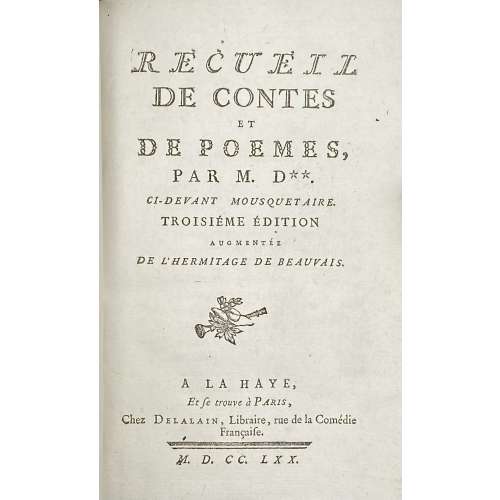 Title page: RECUEIL | DE CONTES | ET | DE POEMES, | PAR M. D**. | CI-DEVANT MOUSQUETAIRE. | TROSIÉME ÉDITION | AUGUMENTÉE | DE L'HERMITAGE DE BEAUVAIS. | [device] | A LA HAYE, | Et se trouve à Paris, | Chez Delalain, Libraire, rue de la Comédie | Française. | — | M. D. CC. LXX. IRZA | ET MARSIS , | POËME, includes: L'isle merveilleuse, Poëme, Chant 1re et Chant 2nd, Invocation a La Fontaine, and Alphonse, Conte – Cohen and De Ricci (#317) describe 2nd edition by the same publisher, 1769, 77 p., with similar illustrations after Charles Eisen: (1) engraved title by Louis Claude Legrand (2) L’Isle 1er: Frontispiece by Joseph de Longueil, (3) headpiece and (4) tailpiece by Emmanuel de Ghendt, and (5) L’Isle 2nd: Frontispiece by Jean Massard, (6) headpiece by Emmanuel de Ghendt + (7) tailpiece unsigned. Les Cerises et la Méprise, Contes en vers – Cohen and De Ricci (#311) also describe the 2nd edition of 1769, with the same (8) frontispiece by De Longueil after Eisen. Sélim et Sélima, Poeme imité de l'allemand; L'hermitage de beauvais, Conte –Cohen and De Ricci (#322) describe edition of 1769 by Sébastien Jorry, with the same (9) frontispiece by Emmanuel de Ghendt after Eisen. Size: 18.6 x 12.3 cm, small 8vo. Binding: polished, multi-coloured stained calf with gilt triple fillet border to boards; gilt floral arabesque and gilt lettering to flat spine: "Oeuvres de Dorat | Contes"; all edges gilt; blue-and-white marbled endpapers. Pagination: ffl, [2] IRZA ET MARSIS engraved half-title / blank, [1-2] - RECUEIL title page / blank, 3-8 (avis sur cette édition); [1 - L'Isle...] 2-184, bfl; Illustrations (copperplate engravings): 5 plates, 2 headpieces and 2 tailpieces. Collation: Octavo; a8 (title and avis sur cette édition); A-L8, M4. Author of the text: Claude Joseph Dorat, (French, 1734 – 1780) Artist: Charles-Dominique-JosephEisen (French, 1720 – 1778) Engravers: Emmanuel Jean Nepomucène de Ghendt (French, 1738 – 1815) Louis Claude Legrand (French, 1723 – 1807) Joseph de Longueil (French, 1730 – 1792) Jean Massard (French, 1740 – 1822)
Title page: RECUEIL | DE CONTES | ET | DE POEMES, | PAR M. D**. | CI-DEVANT MOUSQUETAIRE. | TROSIÉME ÉDITION | AUGUMENTÉE | DE L'HERMITAGE DE BEAUVAIS. | [device] | A LA HAYE, | Et se trouve à Paris, | Chez Delalain, Libraire, rue de la Comédie | Française. | — | M. D. CC. LXX. IRZA | ET MARSIS , | POËME, includes: L'isle merveilleuse, Poëme, Chant 1re et Chant 2nd, Invocation a La Fontaine, and Alphonse, Conte – Cohen and De Ricci (#317) describe 2nd edition by the same publisher, 1769, 77 p., with similar illustrations after Charles Eisen: (1) engraved title by Louis Claude Legrand (2) L’Isle 1er: Frontispiece by Joseph de Longueil, (3) headpiece and (4) tailpiece by Emmanuel de Ghendt, and (5) L’Isle 2nd: Frontispiece by Jean Massard, (6) headpiece by Emmanuel de Ghendt + (7) tailpiece unsigned. Les Cerises et la Méprise, Contes en vers – Cohen and De Ricci (#311) also describe the 2nd edition of 1769, with the same (8) frontispiece by De Longueil after Eisen. Sélim et Sélima, Poeme imité de l'allemand; L'hermitage de beauvais, Conte –Cohen and De Ricci (#322) describe edition of 1769 by Sébastien Jorry, with the same (9) frontispiece by Emmanuel de Ghendt after Eisen. Size: 18.6 x 12.3 cm, small 8vo. Binding: polished, multi-coloured stained calf with gilt triple fillet border to boards; gilt floral arabesque and gilt lettering to flat spine: "Oeuvres de Dorat | Contes"; all edges gilt; blue-and-white marbled endpapers. Pagination: ffl, [2] IRZA ET MARSIS engraved half-title / blank, [1-2] - RECUEIL title page / blank, 3-8 (avis sur cette édition); [1 - L'Isle...] 2-184, bfl; Illustrations (copperplate engravings): 5 plates, 2 headpieces and 2 tailpieces. Collation: Octavo; a8 (title and avis sur cette édition); A-L8, M4. Author of the text: Claude Joseph Dorat, (French, 1734 – 1780) Artist: Charles-Dominique-JosephEisen (French, 1720 – 1778) Engravers: Emmanuel Jean Nepomucène de Ghendt (French, 1738 – 1815) Louis Claude Legrand (French, 1723 – 1807) Joseph de Longueil (French, 1730 – 1792) Jean Massard (French, 1740 – 1822) -
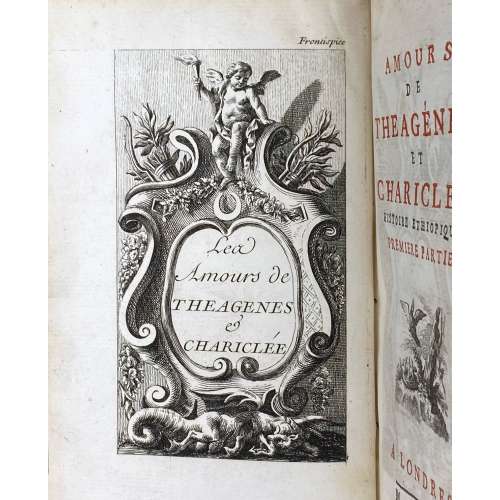 Two volumes in-16o, 16.3 x 10.3 cm, uniformly bound in marbled calf with gilt triple-fillet border, flat spine with gilt lozenges in compartments, two crimson labels with gilt lettering, marbled endpapers, all edges gilt, with engraved title, 2 title vignettes, 11 copper plate engravings, incl. title/frontispiece in vol. 1, and 10 headpieces (two of them similar), printed on laid paper. Vol. 1: Livres 1 – 5. Engraved title-page: Cartouche with the title "Les | Amours de | THEAGENES | & | CHARICLÉE", with a Cupid holding a torch on top and a defeated winged dragon at the bottom; Cupid's quivers with bows and arrows beside. Collation: 8vo; a5 (t.p., preface), A-N8 O4 (O4 blank), total 113 leaves plus 6 unsigned engraved plates, incl. engraved title as frontispiece, unsigned; 5 different headpieces, unsigned. Pagination: [i, ii] iii-x, [1] 2-213 [3] (blank), total 226 pages, ils. Vol. 2: Livres 6 – 10. Collation: 8vo; π1 (t.p.), A-M8, total 97 leaves plus 6 unsigned plates, incl. the Conclusion, no frontispiece; 5 headpieces, the headpiece for Livre 7 similar to Livre 4. Pagination: [2] [1] 2-190 [2] (blank), total 194 pages, ils. Letterpress title-page (red and black) in each volume: AMOURS | DE | THEAGÉNES | ET | CHARICLÉE• | HISTOIRE ETHIOPIQUE. | PREMIERE (SECONDE) PARTIE. | {vignette} | A LONDRES, | — | M. DCC. XLIII. || According to Cohen-DeRicci, this is the first anonymous edition with 9 different headpieces; the second edition in the same 1743 was published by Antoine Urban Coustelier (French, 1714 – 1763) in Paris with less provocative headpiece vignettes. The original text belongs to Héliodore d'Emèse, i.e. Heliodorus [Ἡλιόδωρος] (Greek, 3rd – 4th century AD). The earliest translation into French was performed by Jacques Amyot (French, 1513 – 1593) and published by J. Longis in Paris in 1547. The new translation is credited by Lewine to Jean de Montlyard (French/Swiss, 17th century), first published in Paris in 1620. However, most scholars attribute it to Louis François de Fontenu (French, 1667 – 1759), Bernard Le Bovier de Fontenelle (French, 1657 – 1757) or Germain François Poullain de Saint-Foix (French, 1698 – 1776), first published in 1727 by Herman Uytwerf (Dutch, 1698 – 1754) in Amsterdam. Catalogue raisonné : J. Lewine, 236; Cohen-DeRicci, 478. Information about the story can be found here: Aethiopica.
Two volumes in-16o, 16.3 x 10.3 cm, uniformly bound in marbled calf with gilt triple-fillet border, flat spine with gilt lozenges in compartments, two crimson labels with gilt lettering, marbled endpapers, all edges gilt, with engraved title, 2 title vignettes, 11 copper plate engravings, incl. title/frontispiece in vol. 1, and 10 headpieces (two of them similar), printed on laid paper. Vol. 1: Livres 1 – 5. Engraved title-page: Cartouche with the title "Les | Amours de | THEAGENES | & | CHARICLÉE", with a Cupid holding a torch on top and a defeated winged dragon at the bottom; Cupid's quivers with bows and arrows beside. Collation: 8vo; a5 (t.p., preface), A-N8 O4 (O4 blank), total 113 leaves plus 6 unsigned engraved plates, incl. engraved title as frontispiece, unsigned; 5 different headpieces, unsigned. Pagination: [i, ii] iii-x, [1] 2-213 [3] (blank), total 226 pages, ils. Vol. 2: Livres 6 – 10. Collation: 8vo; π1 (t.p.), A-M8, total 97 leaves plus 6 unsigned plates, incl. the Conclusion, no frontispiece; 5 headpieces, the headpiece for Livre 7 similar to Livre 4. Pagination: [2] [1] 2-190 [2] (blank), total 194 pages, ils. Letterpress title-page (red and black) in each volume: AMOURS | DE | THEAGÉNES | ET | CHARICLÉE• | HISTOIRE ETHIOPIQUE. | PREMIERE (SECONDE) PARTIE. | {vignette} | A LONDRES, | — | M. DCC. XLIII. || According to Cohen-DeRicci, this is the first anonymous edition with 9 different headpieces; the second edition in the same 1743 was published by Antoine Urban Coustelier (French, 1714 – 1763) in Paris with less provocative headpiece vignettes. The original text belongs to Héliodore d'Emèse, i.e. Heliodorus [Ἡλιόδωρος] (Greek, 3rd – 4th century AD). The earliest translation into French was performed by Jacques Amyot (French, 1513 – 1593) and published by J. Longis in Paris in 1547. The new translation is credited by Lewine to Jean de Montlyard (French/Swiss, 17th century), first published in Paris in 1620. However, most scholars attribute it to Louis François de Fontenu (French, 1667 – 1759), Bernard Le Bovier de Fontenelle (French, 1657 – 1757) or Germain François Poullain de Saint-Foix (French, 1698 – 1776), first published in 1727 by Herman Uytwerf (Dutch, 1698 – 1754) in Amsterdam. Catalogue raisonné : J. Lewine, 236; Cohen-DeRicci, 478. Information about the story can be found here: Aethiopica. -
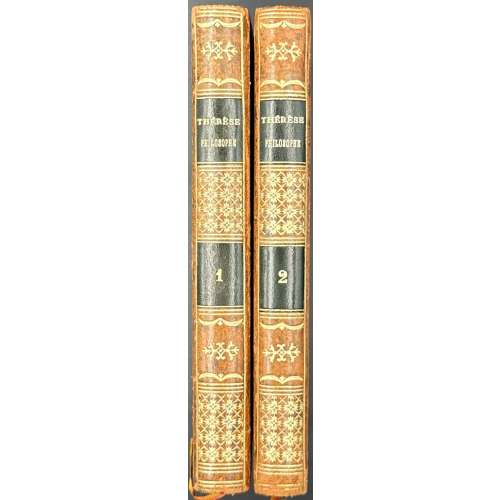 Two volumes, 168 x 106 mm each, uniformly bound in faux mottled calf ruled in gilt, marbled endpapers. Vol. 1: 3 blank leaves of wove paper, 3 blank leaves of laid paper, half-title/blank, blank/frontispiece, ‘engraved’ t.p./blank, both printed on laid paper watermarked “ARCHES A LA | MAIN”; ‘letterpress’ t.p.,/blank, pp.: [1] 2-115 [116 blank], 3 blank leaves of laid paper, 3 blank leaves of wove paper; collated 12mo: π2 A-I6 K4; total 60 leaves plus 16 ‘engraved’ plates, incl. t.p. and frontis. Vol. 2: 3 blank leaves of wove paper, 3 blank leaves of laid paper, half-title/blank, blank/frontispiece, ‘engraved’ t.p./blank, no watermark, ‘letterpress’ t.p.,/blank, pp.: 1-77 [78 blank], 2 blank leaves of laid paper, 3 blank leaves of wove paper; collated 12mo: π2 A-F6 G3; total 41 leaves plus 24 ‘engraved’ plates, incl. t.p. and frontis. Dutel (I): A-1089, p. 325: in-8 (probably by size only, no formula suggested), pagination 115 and 77 as here, 2 frontispieces, 2 engraved titles dated 1873, “et 36 belles gravures de Binet”. Cohen-DeRicci: p. 734 bottom: in-12, no pagination, no formula. "Thérèse" was offered by a French seller user-75d14f4 on the online auction platform CATAWIKI in December 2021. The seller's description of this two-volume set was: "Re-edition, the date of which I was unable to determine. (London, no name, 1782) 2 duodecimo volumes of 115 and 77 pp., very lovely marbled sheepskin pastiche bindings, gilded triple fillets, adorned spines, black title labels. This classic of 18th-century clandestine erotica was written in 1748 by an author who has remained anonymous, attributed at the time to Montigny, which led to his internment in the Bastille. It is now attributed to the Jean-Baptiste de Boyer, Marquis d'Argens. Edition illustrated with 37 very unrestrained figures, engraved in intaglio after Borel, unsigned." I should have paid more attention to the first phase, about the re-edition, but I didn't. After a few bidding rounds, I won the book when the hammer price was 2,200 Euros. On the 28th of December, 2021, I paid for this little beauty $2,760. The book arrived a few days later. The paper's quality and texture, the watermark, the absence of the platemark, and the lack of embossing on the back (text and plates) made me suspect it was a fake. The pages were absolutely flat to the touch! I established clear evidence of a high-resolution 'xerox' copy using Celestron Micro Capture Pro micro-photography. I wrote to the seller and the auction platform, explaining my doubts regarding its authenticity. To prove my point, I include a few micro photos of the "Thérèse" and some books printed at the end of the 18th century. I explained why I considered it a fake and requested a return/refund. After two months of email exchanges, the seller and the platform refused to pay me back. Today is the 2nd anniversary of the purchase. I still have the book. To celebrate my carelessness, I included it in my library to warn fellow book collectors about buying from an unknown dealer via certain online auction platforms. Ref.: Bamber Gascoigne. How to Identify Prints: A Complete Guide to Manual and Mechanical Processes from Woodcut to Ink. — Thames and Hudson, 1995.
Two volumes, 168 x 106 mm each, uniformly bound in faux mottled calf ruled in gilt, marbled endpapers. Vol. 1: 3 blank leaves of wove paper, 3 blank leaves of laid paper, half-title/blank, blank/frontispiece, ‘engraved’ t.p./blank, both printed on laid paper watermarked “ARCHES A LA | MAIN”; ‘letterpress’ t.p.,/blank, pp.: [1] 2-115 [116 blank], 3 blank leaves of laid paper, 3 blank leaves of wove paper; collated 12mo: π2 A-I6 K4; total 60 leaves plus 16 ‘engraved’ plates, incl. t.p. and frontis. Vol. 2: 3 blank leaves of wove paper, 3 blank leaves of laid paper, half-title/blank, blank/frontispiece, ‘engraved’ t.p./blank, no watermark, ‘letterpress’ t.p.,/blank, pp.: 1-77 [78 blank], 2 blank leaves of laid paper, 3 blank leaves of wove paper; collated 12mo: π2 A-F6 G3; total 41 leaves plus 24 ‘engraved’ plates, incl. t.p. and frontis. Dutel (I): A-1089, p. 325: in-8 (probably by size only, no formula suggested), pagination 115 and 77 as here, 2 frontispieces, 2 engraved titles dated 1873, “et 36 belles gravures de Binet”. Cohen-DeRicci: p. 734 bottom: in-12, no pagination, no formula. "Thérèse" was offered by a French seller user-75d14f4 on the online auction platform CATAWIKI in December 2021. The seller's description of this two-volume set was: "Re-edition, the date of which I was unable to determine. (London, no name, 1782) 2 duodecimo volumes of 115 and 77 pp., very lovely marbled sheepskin pastiche bindings, gilded triple fillets, adorned spines, black title labels. This classic of 18th-century clandestine erotica was written in 1748 by an author who has remained anonymous, attributed at the time to Montigny, which led to his internment in the Bastille. It is now attributed to the Jean-Baptiste de Boyer, Marquis d'Argens. Edition illustrated with 37 very unrestrained figures, engraved in intaglio after Borel, unsigned." I should have paid more attention to the first phase, about the re-edition, but I didn't. After a few bidding rounds, I won the book when the hammer price was 2,200 Euros. On the 28th of December, 2021, I paid for this little beauty $2,760. The book arrived a few days later. The paper's quality and texture, the watermark, the absence of the platemark, and the lack of embossing on the back (text and plates) made me suspect it was a fake. The pages were absolutely flat to the touch! I established clear evidence of a high-resolution 'xerox' copy using Celestron Micro Capture Pro micro-photography. I wrote to the seller and the auction platform, explaining my doubts regarding its authenticity. To prove my point, I include a few micro photos of the "Thérèse" and some books printed at the end of the 18th century. I explained why I considered it a fake and requested a return/refund. After two months of email exchanges, the seller and the platform refused to pay me back. Today is the 2nd anniversary of the purchase. I still have the book. To celebrate my carelessness, I included it in my library to warn fellow book collectors about buying from an unknown dealer via certain online auction platforms. Ref.: Bamber Gascoigne. How to Identify Prints: A Complete Guide to Manual and Mechanical Processes from Woodcut to Ink. — Thames and Hudson, 1995.
Books used for comparison: [LIB-2743.2021] Restif de la Bretonne. Les parisiennes, ou XL caractères généraux pris dans les mœurs actuelles, propres à servir à l’instruction des personnes-du-sexe / 4 vol. — Neufchâtel, et Paris: Guillot, 1787. [LIB-3027.2022] [Héliodore d’Emèse]. Amours de Théagènes et Chariclée: Histoire Éthiopique / 2 vol. — Londres [i.e. Paris]: [s.n.], 1743. [LIB-3252.2023] [Nicolas Chorier.] Le Meursius françois, ou entretiens galans d’Aloysia, orné de figures. — Cythere [i.e. Paris: Cazin], 1782. Below is a Xerox copy for comparison.Thérèse philosophe, 1783.
Late 18th century books
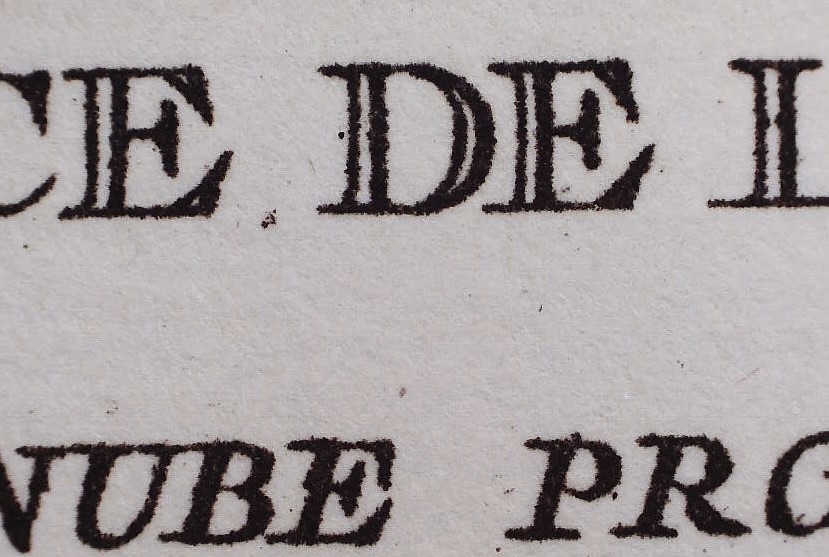

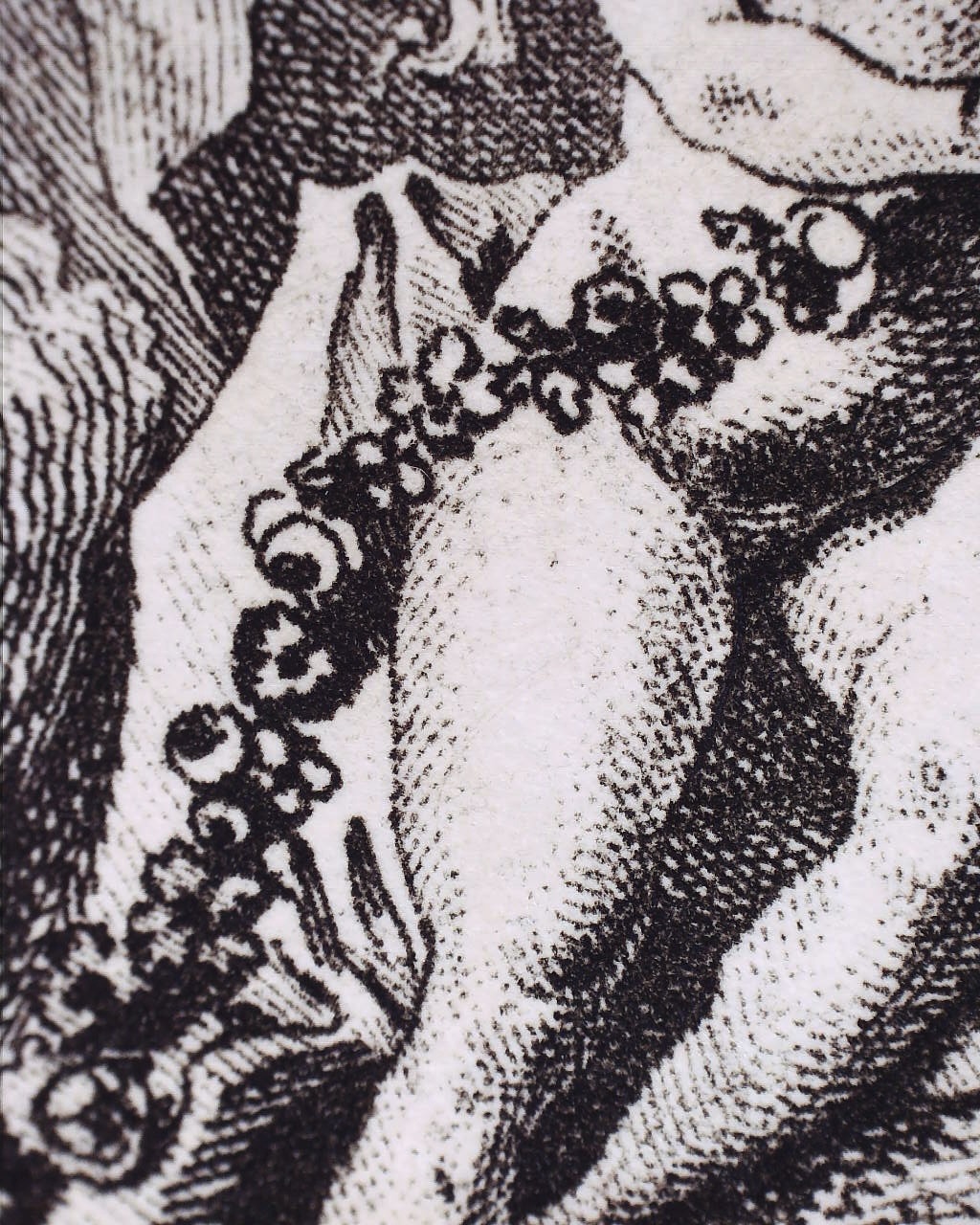
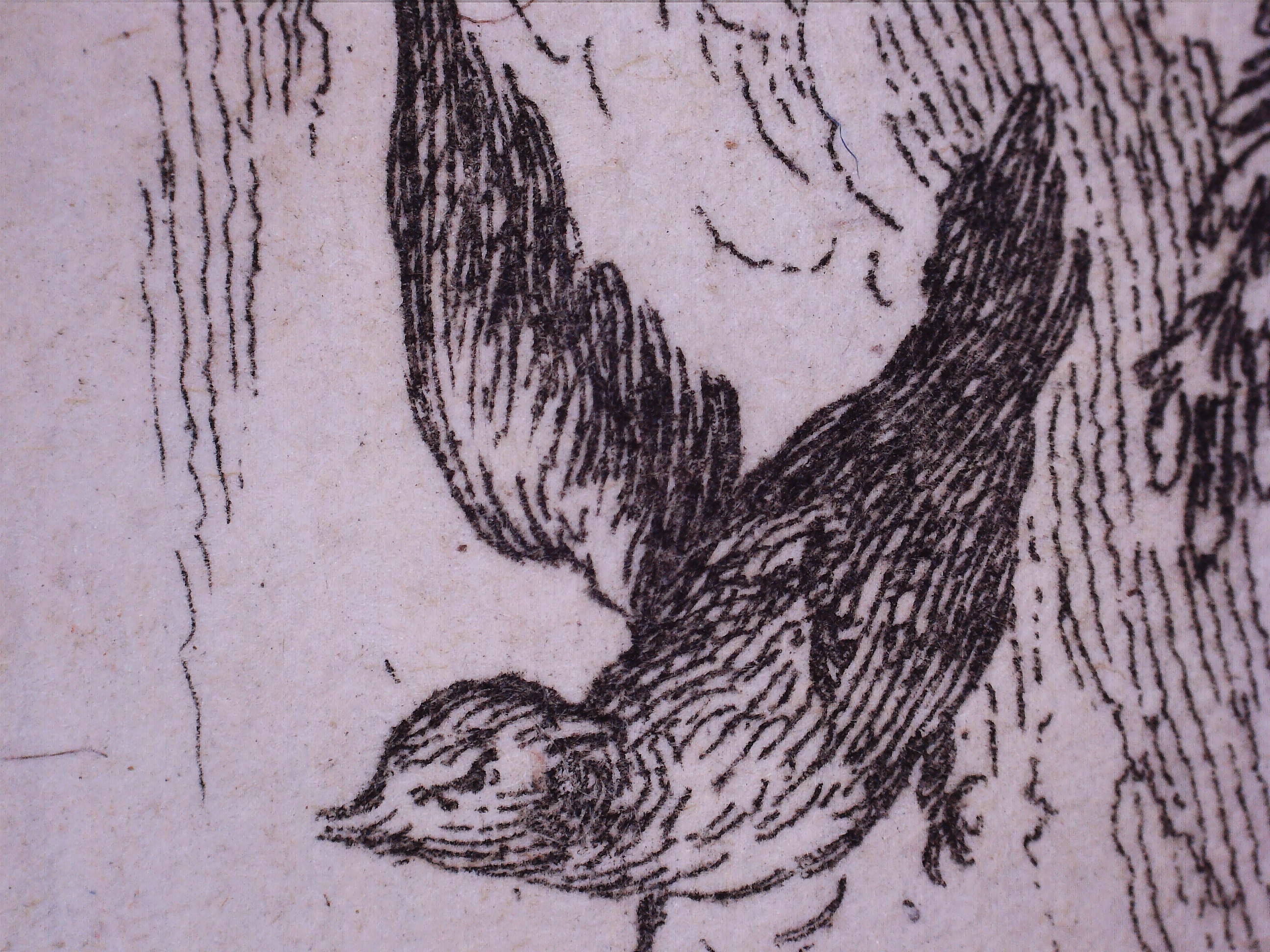
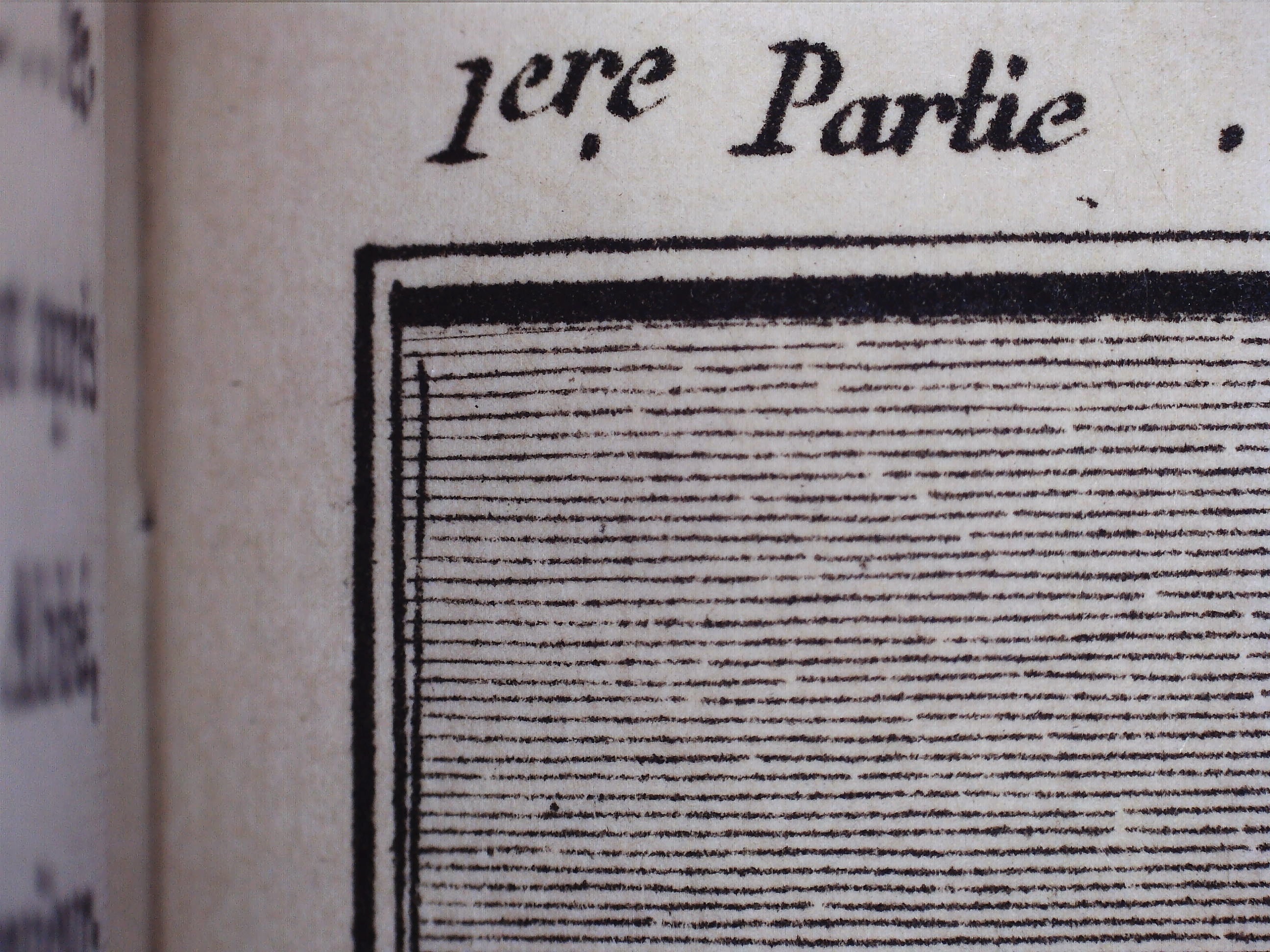
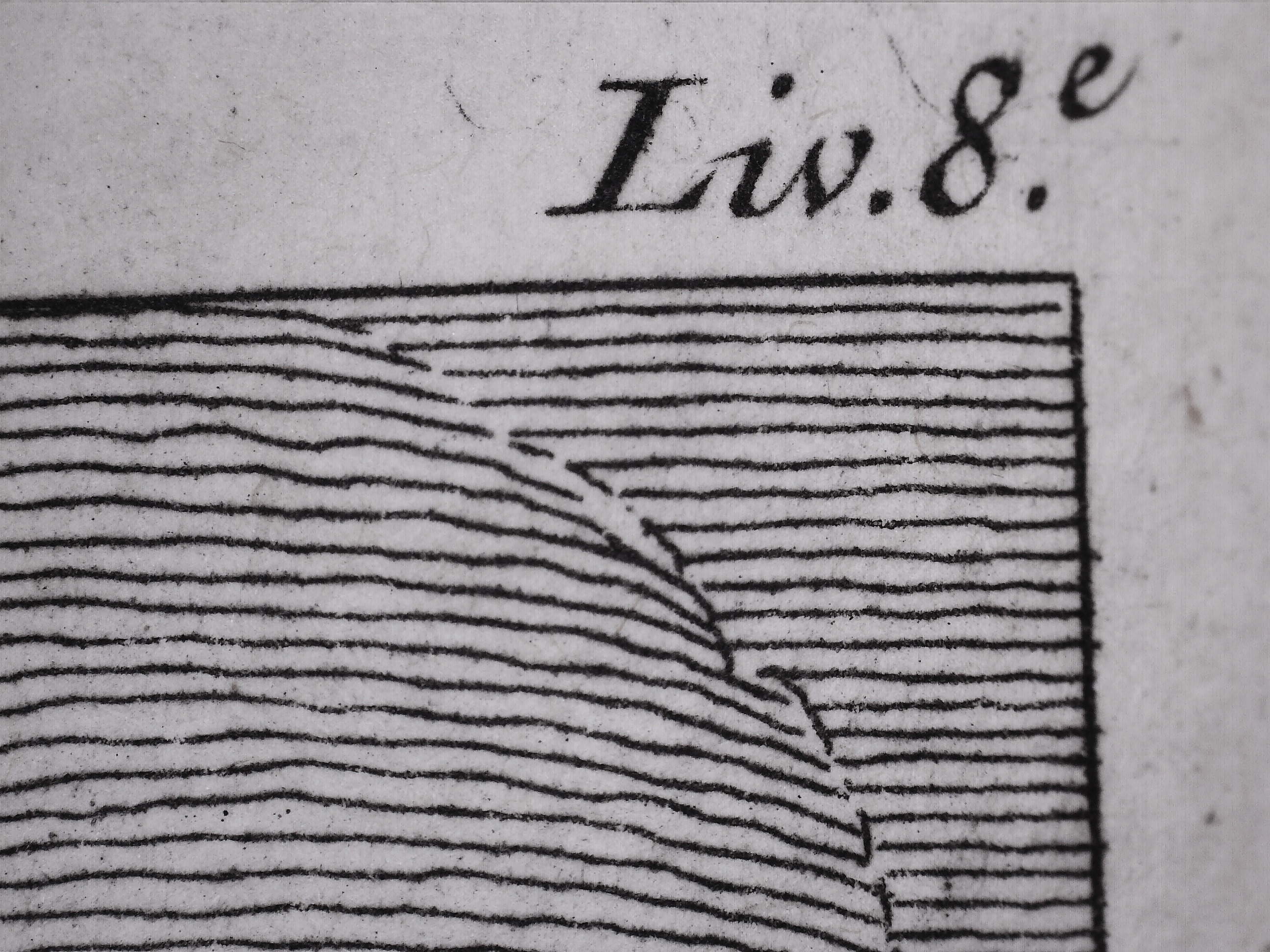
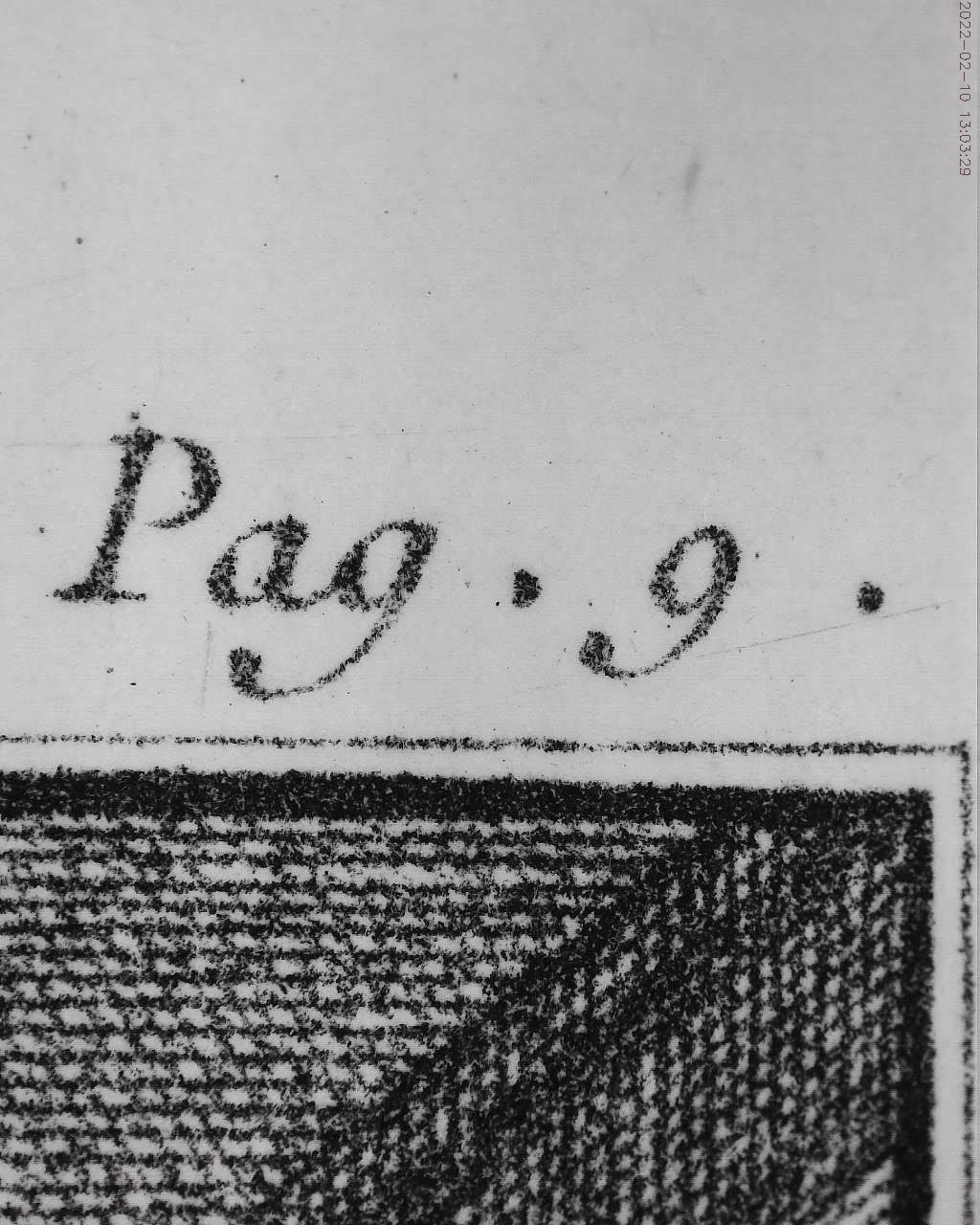
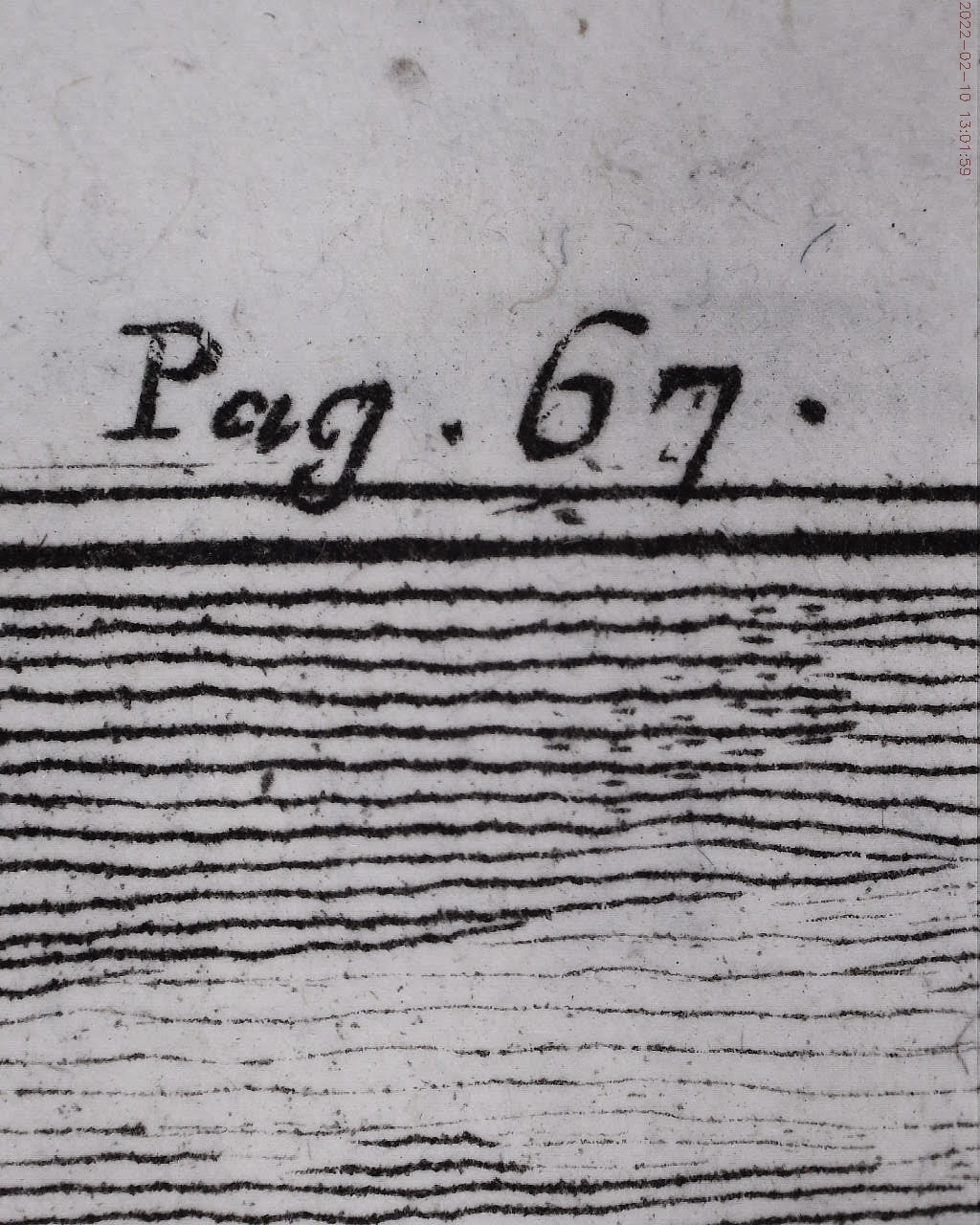

-
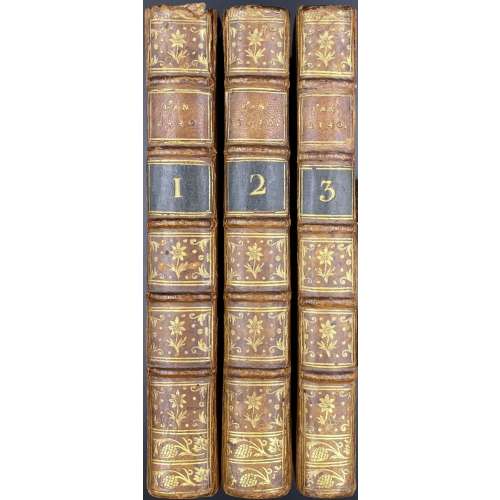 Description: Three volumes 20.5 x 13 cm each, collated 8vo, uniformly bound in quarter calf over marbled boards, with raised bands, gilt in compartments and black and brown gilt-lettered labels to spine; bookplate “Ex libris Jacques Laget” pasted on to front pastedown. Printed on laid paper, with tall “s”. Title-page: L'AN | DEUX MILLE | QUATRE CENT QUARANTE. | Rêve s'il en fût jamais; | SUIVI DE | L'HOMME DE FER, | SONGE. | — | Le présent est gros l’avenir. / Leibnitz. (O utinam !; Le plaisir sans égal seroit de fonder la félicité publique.) | — | NOUVELLE ÉDITION | Avec Figures. | TOME PREMIER (SECOND; TROISIEME). | {device} | — | 1786. || Vol 1: fep a8 A-Z8 2A8; total 201 leaves plus engraved frontispiece by Ghendt after Marillier; pp: ff [i-v] vi-xvi, 1-380 [4]; total 402 pages. Vol. 2: fep π2, A-Z8 2A8 fep; total 196 leaves plus engraved frontispiece by Ghendt after Marillier; pp: [6] 1-381 [5]; total 392 pages. Vol. 3: fep π2, A-T8 V5 fep; total 161 leaves plus engraved frontispiece by Ghendt after Marillier; pp: [6] 1-312 [4]; total 322 pages. Catalogue raisonné: Cohen-DeRicci 701; Lewine 353 Provenance: Jacques Laget (French, 1821 – 1884). Contributors: Louis-Sébastien Mercier (French, 1740 – 1814) – author. Clément Pierre Marillier (French, 1740 – 1808) – artist Emmanuel Jean Nepomucène de Ghendt (Flemish, worked in France, 1738 – 1815) – engraver. See also: LIB-0979.2016 and LIB-2695.2021.
Description: Three volumes 20.5 x 13 cm each, collated 8vo, uniformly bound in quarter calf over marbled boards, with raised bands, gilt in compartments and black and brown gilt-lettered labels to spine; bookplate “Ex libris Jacques Laget” pasted on to front pastedown. Printed on laid paper, with tall “s”. Title-page: L'AN | DEUX MILLE | QUATRE CENT QUARANTE. | Rêve s'il en fût jamais; | SUIVI DE | L'HOMME DE FER, | SONGE. | — | Le présent est gros l’avenir. / Leibnitz. (O utinam !; Le plaisir sans égal seroit de fonder la félicité publique.) | — | NOUVELLE ÉDITION | Avec Figures. | TOME PREMIER (SECOND; TROISIEME). | {device} | — | 1786. || Vol 1: fep a8 A-Z8 2A8; total 201 leaves plus engraved frontispiece by Ghendt after Marillier; pp: ff [i-v] vi-xvi, 1-380 [4]; total 402 pages. Vol. 2: fep π2, A-Z8 2A8 fep; total 196 leaves plus engraved frontispiece by Ghendt after Marillier; pp: [6] 1-381 [5]; total 392 pages. Vol. 3: fep π2, A-T8 V5 fep; total 161 leaves plus engraved frontispiece by Ghendt after Marillier; pp: [6] 1-312 [4]; total 322 pages. Catalogue raisonné: Cohen-DeRicci 701; Lewine 353 Provenance: Jacques Laget (French, 1821 – 1884). Contributors: Louis-Sébastien Mercier (French, 1740 – 1814) – author. Clément Pierre Marillier (French, 1740 – 1808) – artist Emmanuel Jean Nepomucène de Ghendt (Flemish, worked in France, 1738 – 1815) – engraver. See also: LIB-0979.2016 and LIB-2695.2021. -
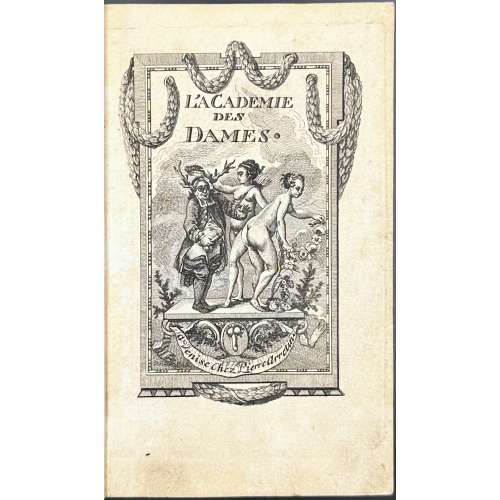 A set of two volumes, one with the text (1) and another with the plates (2), cased in a red ‘romantic’ fitting box of red morocco, lavishly tooled in gilt, c. 1840, more recently adapted to house two books of different size. Vol.1: Hardcover volume, 22.4 x 14 cm, 8vo, bound in half black polished calf (late 19th century) over marbled boards, spine and corners gilt-tooled, raised bands, gilt lozenges in compartments, gilt-lettered red morocco label; marbled endpapers; Francis M. G. Mauleverer armorial bookplate (motto “Deus Providebit”) to front pastedown. Printed on laid paper, Collation: 1 blank, engraved frontis., engraved t.p., A-Cc8 Dd2, 1 blank; pagination:[1] 2-420. Vol. 2: Hardcover volume, 21 x 14 cm, bound in green straight-grain morocco (early 19th century), boards with a roll-tooled palmette border, spine decorated in gilt, blue moiré endpapers, yellow feps, additional blank leaves: 2 in the front and 4 in the back, unpaginated; engraved frontis. and t.p. as in vol. 2, plus 35 plates now attributed to Delcroche printed on India paper, pasted on thicker leaves and bound in numerical order, but pl. 34 after pl. 35; As per Christie’s “The prints, sometimes attributed to de Hooghe, are actually by Delcroche, who illustrated a number of classics in the 1770s and 1780s, including Fanny Hill. AE and ABPC record only three copies of this edition at auction, including the Nordmann and Hayoit copies. Apollinaire Enfer, 277; Dutel A-15; Eros invaincu 16; Foxon Libertine Literature, NY: 1965, p.38; Gay-Lemonnyer I, 10; Pia Enfer, 346.” Contributors: Delcroche (Dutch, 17th century), “artiste hollandaise”, nothing else is known. Dutel and Nordmann attribute the plates to Romeyn de Hooghe (Dutch, 1645 – 1708). Nicolas Chorier (French, 1612 – 1692) – author. Francis M. G. Mauleverer (British, 1918 – 1962) – provenance. Seller’s description: 2 vols in 8vo (215x125 and 204x117 mm), a complete but composite set, the text volume in late 19th c. half black morocco, with corners, gilt spine tooled in gold, the plate volume in a nice early 19th-century green morocco binding, the spine gilt-tooled in compartments, the sides with a roll-tooled palmette border, pale blue moiré style endpapers (hinges repaired). Text vol.: engraved frontispiece, engr. title, pp. 420. Plates vol. comprising: the engraved title, frontispiece, and 35 engraved plates, probably by Delcroche. Both volumes cased in a ‘romantic’ fitting box binding, c. 1840, more recently adapted.
A set of two volumes, one with the text (1) and another with the plates (2), cased in a red ‘romantic’ fitting box of red morocco, lavishly tooled in gilt, c. 1840, more recently adapted to house two books of different size. Vol.1: Hardcover volume, 22.4 x 14 cm, 8vo, bound in half black polished calf (late 19th century) over marbled boards, spine and corners gilt-tooled, raised bands, gilt lozenges in compartments, gilt-lettered red morocco label; marbled endpapers; Francis M. G. Mauleverer armorial bookplate (motto “Deus Providebit”) to front pastedown. Printed on laid paper, Collation: 1 blank, engraved frontis., engraved t.p., A-Cc8 Dd2, 1 blank; pagination:[1] 2-420. Vol. 2: Hardcover volume, 21 x 14 cm, bound in green straight-grain morocco (early 19th century), boards with a roll-tooled palmette border, spine decorated in gilt, blue moiré endpapers, yellow feps, additional blank leaves: 2 in the front and 4 in the back, unpaginated; engraved frontis. and t.p. as in vol. 2, plus 35 plates now attributed to Delcroche printed on India paper, pasted on thicker leaves and bound in numerical order, but pl. 34 after pl. 35; As per Christie’s “The prints, sometimes attributed to de Hooghe, are actually by Delcroche, who illustrated a number of classics in the 1770s and 1780s, including Fanny Hill. AE and ABPC record only three copies of this edition at auction, including the Nordmann and Hayoit copies. Apollinaire Enfer, 277; Dutel A-15; Eros invaincu 16; Foxon Libertine Literature, NY: 1965, p.38; Gay-Lemonnyer I, 10; Pia Enfer, 346.” Contributors: Delcroche (Dutch, 17th century), “artiste hollandaise”, nothing else is known. Dutel and Nordmann attribute the plates to Romeyn de Hooghe (Dutch, 1645 – 1708). Nicolas Chorier (French, 1612 – 1692) – author. Francis M. G. Mauleverer (British, 1918 – 1962) – provenance. Seller’s description: 2 vols in 8vo (215x125 and 204x117 mm), a complete but composite set, the text volume in late 19th c. half black morocco, with corners, gilt spine tooled in gold, the plate volume in a nice early 19th-century green morocco binding, the spine gilt-tooled in compartments, the sides with a roll-tooled palmette border, pale blue moiré style endpapers (hinges repaired). Text vol.: engraved frontispiece, engr. title, pp. 420. Plates vol. comprising: the engraved title, frontispiece, and 35 engraved plates, probably by Delcroche. Both volumes cased in a ‘romantic’ fitting box binding, c. 1840, more recently adapted. -
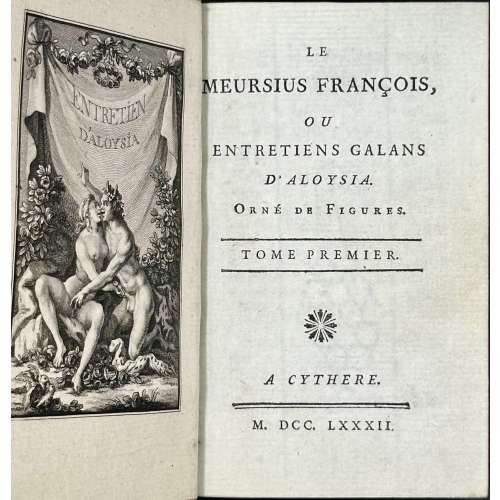 Hardcover volume, 12mo, 125 x 85 mm, two parts in one, bound and gilded by Cuzin and Maillard, respectively, between 1876 and 1881, in crimson crushed morocco with raised bands and gilt lettering to spine, marbled endpapers, all edges gilt, gilt dentelle, signed 'Cuzin' to foot of front turn-in and 'Maillard dor.' to rear. Adorned with engraved frontispiece and 12 plates by Elluin after Borel. Text printed on a slightly bluish paper. Title-page: LE | MEURSIUS FRANÇOIS, | OU | ENTRETIENS GALANS | D'ALOYSIA. | ORNÉ | DE FIGURES. | — | TOME PREMIER (SECOND) | — | ✵ | A CYTHERE | — | M. DCC. LXXXII. || Collation: 12mo, π4 (2 blanks) A-Z6 χ1,+ π2 A-S6 (4 blanks) χ1, total 254 leaves; pagination: [8] [1] 2-277 [278 blank], [4] [1] 2-210 [8 blanks], total 508 pages, plus 13 engraved plates, incl. frontispiece. Catalogue raisonné: Cohen-de Ricci 240; Eros invaincu 17; Fekete 51; Nordmann (I) 91. Contributors: Nicolas Chorier (French, 1612 – 1692) – author. Antoine Borel (French, 1743 – 1810) – artist. François-Rolland Elluin (French, 1745 – c. 1822) – engraver. Hubert-Martin Cazin (French, 1724 – 1795) – publisher. Francisque Cuzin (French, 1836 – 1890) – bookbinder. Seller’s description: Erotica.- [Chorier (Nicolas)]Le Meursius François, ou Entretiens galans d'Aloysia, 2 parts in 1, half-title to each part, engraved frontispiece and 12 plates [by Elluin after Borel], handsomely bound in crimson crushed morocco by Cuzin, spine with gilt lettering and five raised bands, gilt tooled turn-ins by Maillard, signed 'Cuzin' to foot of front turn-in and 'Maillard dor.' to rear, marbled endpapers, g.e., fractional rubbing to extremities, an excellent copy, 12mo, Cythere [but Paris], [Cazin], 1782.
Hardcover volume, 12mo, 125 x 85 mm, two parts in one, bound and gilded by Cuzin and Maillard, respectively, between 1876 and 1881, in crimson crushed morocco with raised bands and gilt lettering to spine, marbled endpapers, all edges gilt, gilt dentelle, signed 'Cuzin' to foot of front turn-in and 'Maillard dor.' to rear. Adorned with engraved frontispiece and 12 plates by Elluin after Borel. Text printed on a slightly bluish paper. Title-page: LE | MEURSIUS FRANÇOIS, | OU | ENTRETIENS GALANS | D'ALOYSIA. | ORNÉ | DE FIGURES. | — | TOME PREMIER (SECOND) | — | ✵ | A CYTHERE | — | M. DCC. LXXXII. || Collation: 12mo, π4 (2 blanks) A-Z6 χ1,+ π2 A-S6 (4 blanks) χ1, total 254 leaves; pagination: [8] [1] 2-277 [278 blank], [4] [1] 2-210 [8 blanks], total 508 pages, plus 13 engraved plates, incl. frontispiece. Catalogue raisonné: Cohen-de Ricci 240; Eros invaincu 17; Fekete 51; Nordmann (I) 91. Contributors: Nicolas Chorier (French, 1612 – 1692) – author. Antoine Borel (French, 1743 – 1810) – artist. François-Rolland Elluin (French, 1745 – c. 1822) – engraver. Hubert-Martin Cazin (French, 1724 – 1795) – publisher. Francisque Cuzin (French, 1836 – 1890) – bookbinder. Seller’s description: Erotica.- [Chorier (Nicolas)]Le Meursius François, ou Entretiens galans d'Aloysia, 2 parts in 1, half-title to each part, engraved frontispiece and 12 plates [by Elluin after Borel], handsomely bound in crimson crushed morocco by Cuzin, spine with gilt lettering and five raised bands, gilt tooled turn-ins by Maillard, signed 'Cuzin' to foot of front turn-in and 'Maillard dor.' to rear, marbled endpapers, g.e., fractional rubbing to extremities, an excellent copy, 12mo, Cythere [but Paris], [Cazin], 1782. -
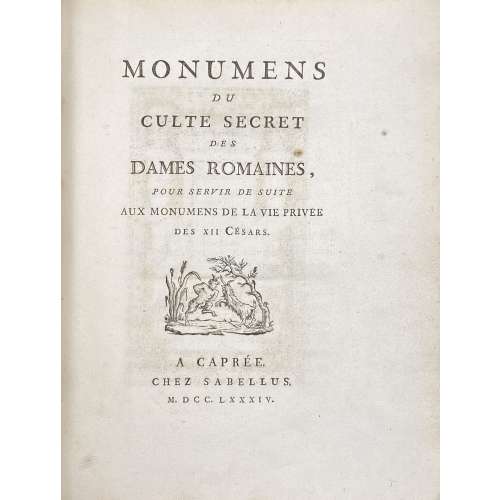 One volume, 25.8 x 20.7 cm, laid paper 25.2 x 19.5 cm, platemark 13.3 x 7.7 cm, wide margins; bound in calf, ruled in gilt, rebacked, raised bands, blind-stamped flower lozenges in compartments, crimson label with gilt lettering, marbled endpapers, all edges gilt, gilt dentelle inside, engraved bookplate to front pastedown: lettered ribbon: “VINCTUS NON VICTUS”, chained Lion Passant in a collar, below “Maurice B. Worms”. Title-page: MONUMENS | DU | CULTE SECRET | DES | DAMES ROMAINES , | POUR SERVIR DE SUITE | AUX MONUMENS DE LA VIE PRIVÉE | DES XII CÉSARS. | {VIGNETTE} | A CAPRÉE. | CHEZ SABELLUS. | M. DCC. LXXXIV. || Collation: [A]2 B-G2 2A-Z2 Aa2 Bb1, total 63 leaves, plus engraved title/frontispiece and 50 plates, all unsigned, first and last blanks. Pagination: [i-ii] iii-xxvii [xxviii] 1-98, ils., total 126 pages. Catalogue raisonné: Cohen-De Ricci: 475; Lewine: 233; Dutel (1650-1880) № A-729, p. 223; Pia (1978): col. 884-5, pp. 467-8. Author: Pierre-François Hugues d'Hancarville (French, 1719-1805) – author. Provenance: Maurice Benedict Worms (Austrian, 1805 – 1867), son of Benedikt Moses Worms (1769 – 1824) and Schönche Jeannette Rothschild (1771 – 1859), maternal grandson of Mayer Amschel Rothschild (1744 – 1812), the founder of the House of Rothschild.
One volume, 25.8 x 20.7 cm, laid paper 25.2 x 19.5 cm, platemark 13.3 x 7.7 cm, wide margins; bound in calf, ruled in gilt, rebacked, raised bands, blind-stamped flower lozenges in compartments, crimson label with gilt lettering, marbled endpapers, all edges gilt, gilt dentelle inside, engraved bookplate to front pastedown: lettered ribbon: “VINCTUS NON VICTUS”, chained Lion Passant in a collar, below “Maurice B. Worms”. Title-page: MONUMENS | DU | CULTE SECRET | DES | DAMES ROMAINES , | POUR SERVIR DE SUITE | AUX MONUMENS DE LA VIE PRIVÉE | DES XII CÉSARS. | {VIGNETTE} | A CAPRÉE. | CHEZ SABELLUS. | M. DCC. LXXXIV. || Collation: [A]2 B-G2 2A-Z2 Aa2 Bb1, total 63 leaves, plus engraved title/frontispiece and 50 plates, all unsigned, first and last blanks. Pagination: [i-ii] iii-xxvii [xxviii] 1-98, ils., total 126 pages. Catalogue raisonné: Cohen-De Ricci: 475; Lewine: 233; Dutel (1650-1880) № A-729, p. 223; Pia (1978): col. 884-5, pp. 467-8. Author: Pierre-François Hugues d'Hancarville (French, 1719-1805) – author. Provenance: Maurice Benedict Worms (Austrian, 1805 – 1867), son of Benedikt Moses Worms (1769 – 1824) and Schönche Jeannette Rothschild (1771 – 1859), maternal grandson of Mayer Amschel Rothschild (1744 – 1812), the founder of the House of Rothschild. -
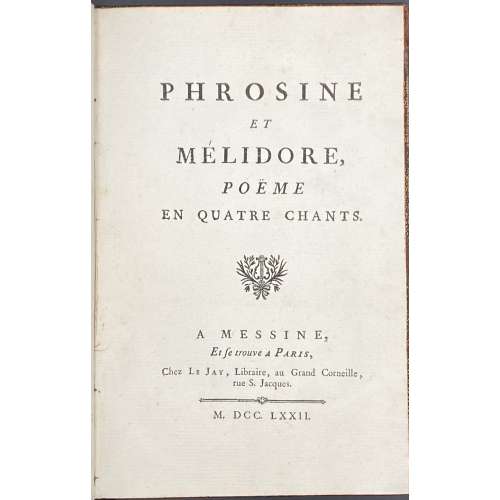 Title page: PHROSINE | ET | MELIDORE, | POËME | EN QUATRE CHANTS. | A MESSINE, | Et se trouve A Paris, | Chez Le Jay, Libraire, au Grand Corneille, | rue S. Jacques. | M. DCC. LXXII. || Pagination : ffl, [2] – h.t. / blank, [2] t.p. / blank, [1] 2-55 [56 blank], bfl ; 4 copperplate engravings by Nicolas Ponce (French, 1746 – 1831) after Charles Eisen (French, 1720 – 1778), one before each chant. Collation: 8vo; π2 (h.t., t.p. ) A-C8 D4. Binding: 20.5 x 14 cm, full mottled calf, gilt-ruled with triple fillet, flat spine, gilt in compartments, black label with gilt lettering, printed on laid paper, all edges red. Catalogue raisonné: Cohen de Ricci p. 132; J. Lewine: p. 53. Contributors: Nicolas Ponce (French, 1746 – 1831) Jean Charles Baquoy (French, 1721–1777) Charles-Dominique-Joseph Eisen (French, 1720 – 1778) Pierre-Joseph Bernard [Gentil-Bernard] (French, 1708 – 1775).
Title page: PHROSINE | ET | MELIDORE, | POËME | EN QUATRE CHANTS. | A MESSINE, | Et se trouve A Paris, | Chez Le Jay, Libraire, au Grand Corneille, | rue S. Jacques. | M. DCC. LXXII. || Pagination : ffl, [2] – h.t. / blank, [2] t.p. / blank, [1] 2-55 [56 blank], bfl ; 4 copperplate engravings by Nicolas Ponce (French, 1746 – 1831) after Charles Eisen (French, 1720 – 1778), one before each chant. Collation: 8vo; π2 (h.t., t.p. ) A-C8 D4. Binding: 20.5 x 14 cm, full mottled calf, gilt-ruled with triple fillet, flat spine, gilt in compartments, black label with gilt lettering, printed on laid paper, all edges red. Catalogue raisonné: Cohen de Ricci p. 132; J. Lewine: p. 53. Contributors: Nicolas Ponce (French, 1746 – 1831) Jean Charles Baquoy (French, 1721–1777) Charles-Dominique-Joseph Eisen (French, 1720 – 1778) Pierre-Joseph Bernard [Gentil-Bernard] (French, 1708 – 1775). -
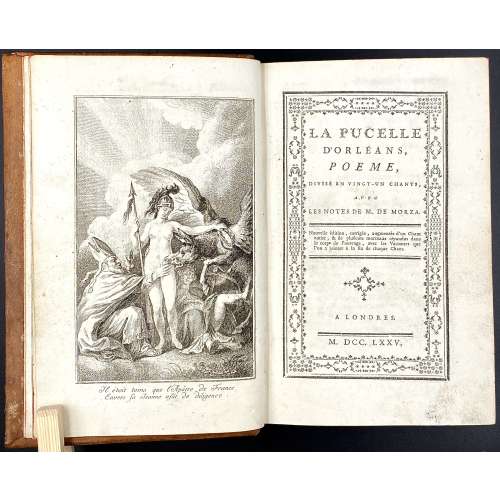 Half title: LA PUCELLE | D’ORLEANS.|| Title: LA PUCELLE | D’ORLEANS , | POEME , | DIVISÉ EN VINGT-UN CHANTS , AVEC | LES NOTES DE M. DE MORZA. | Nouvelle édition, corrigée, augmentée d'un Chant | entier, & de plusieurs morceaux répandus dans | le corps de l'ouvrage, avec les Variantes que | l'on a jointes à la fin de chaque Chant. | [ornament] | A LONDRES. |—| M. DCC. LXXV. || Pagination : [4] – two blank unnumbered fly leaves, [i,ii] – h.t. / double-ruled blank leaf, [2] – blank / frontispiece on verso, [iii, iv] – t.p. ruled and bordered / double-ruled blank leaf, [v]vi-viii – table, ix-xv – preface, [xvi] – double-ruled blank leaf, [1]2-447 [448] – double-ruled blank leaf, [2] – two blank unnumbered fly leaves; page 14 misnumbered 18; title within ornamental border; text within double-ruled borders; head- and tail-pieces; 22 leaves of plates (frontis. + one before each chant.) Collation: 8vo; a8 A-Z8 Aa-Ee8 Binding: 19.9 x 13.2 cm; full contemporary brown calf, blind ruled plates, spine with raised bands, gilt-ruled and tooled in compartments, red label with gilt lettering, all edges red; plate for chant 6, H4, H5 - separated from the block. De Morza is Voltaire (Cf. Quérard, v. 10, p. 306). Engravings unsigned; attributed to Desrais, Claude-Louis (French, 1746 – 1816). False imprint; possibly printed in Paris.
Half title: LA PUCELLE | D’ORLEANS.|| Title: LA PUCELLE | D’ORLEANS , | POEME , | DIVISÉ EN VINGT-UN CHANTS , AVEC | LES NOTES DE M. DE MORZA. | Nouvelle édition, corrigée, augmentée d'un Chant | entier, & de plusieurs morceaux répandus dans | le corps de l'ouvrage, avec les Variantes que | l'on a jointes à la fin de chaque Chant. | [ornament] | A LONDRES. |—| M. DCC. LXXV. || Pagination : [4] – two blank unnumbered fly leaves, [i,ii] – h.t. / double-ruled blank leaf, [2] – blank / frontispiece on verso, [iii, iv] – t.p. ruled and bordered / double-ruled blank leaf, [v]vi-viii – table, ix-xv – preface, [xvi] – double-ruled blank leaf, [1]2-447 [448] – double-ruled blank leaf, [2] – two blank unnumbered fly leaves; page 14 misnumbered 18; title within ornamental border; text within double-ruled borders; head- and tail-pieces; 22 leaves of plates (frontis. + one before each chant.) Collation: 8vo; a8 A-Z8 Aa-Ee8 Binding: 19.9 x 13.2 cm; full contemporary brown calf, blind ruled plates, spine with raised bands, gilt-ruled and tooled in compartments, red label with gilt lettering, all edges red; plate for chant 6, H4, H5 - separated from the block. De Morza is Voltaire (Cf. Quérard, v. 10, p. 306). Engravings unsigned; attributed to Desrais, Claude-Louis (French, 1746 – 1816). False imprint; possibly printed in Paris. -
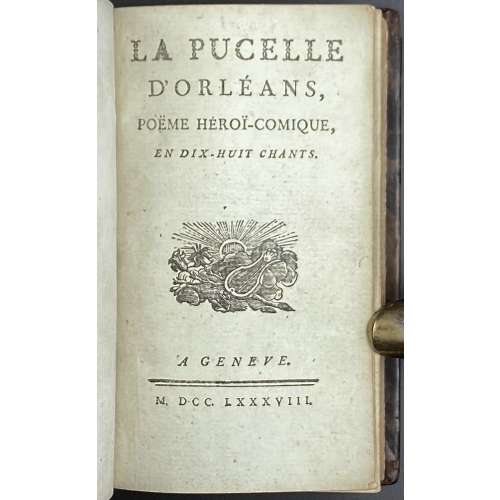 LA PUCELLE | D'ORLÉANS, | POËME HÉROÏ-COMIQUE, | EN DIX-HUIT CHANTS. |{vignette}| A GENEVE. | M. DCC.LXXXVIII.|| Pagination: engraved frontis., engraved portrait, [1, 2] – t.p. / blank, [3] 4-304; plates: engraved frontispiece, engraved portrait of Jeanne d'Arc and 18 engraved plates (the so-called 'suite anglaise' by Marillier, Clément-Pierre (French, 1740 – 1808) after Duflos, Pierre (French, 1742 – 1816). Publisher: Cazin, Hubert-Martin (French, 1724 – 1795). Modern binding to imitate full mottled calf of the 18th century, gilt double-ruled boards, gilt decorated spine with the crimson label “LA PUCELLE”, AEG, laid paper. Size: 13.3 x 8.7 cm; 18mo. Catalogue raisonné: Cohen, De Ricci 1032 (for 1777 and 1780 editions). J. Lewine p.559 (for 1777 16mo and even 12mo editions). The 'correct' 1st thus edition is called suite anglaise because instead of 'chant number' it's printed 'book number' on top of the pages. This copy is definitely a later pirated edition.
LA PUCELLE | D'ORLÉANS, | POËME HÉROÏ-COMIQUE, | EN DIX-HUIT CHANTS. |{vignette}| A GENEVE. | M. DCC.LXXXVIII.|| Pagination: engraved frontis., engraved portrait, [1, 2] – t.p. / blank, [3] 4-304; plates: engraved frontispiece, engraved portrait of Jeanne d'Arc and 18 engraved plates (the so-called 'suite anglaise' by Marillier, Clément-Pierre (French, 1740 – 1808) after Duflos, Pierre (French, 1742 – 1816). Publisher: Cazin, Hubert-Martin (French, 1724 – 1795). Modern binding to imitate full mottled calf of the 18th century, gilt double-ruled boards, gilt decorated spine with the crimson label “LA PUCELLE”, AEG, laid paper. Size: 13.3 x 8.7 cm; 18mo. Catalogue raisonné: Cohen, De Ricci 1032 (for 1777 and 1780 editions). J. Lewine p.559 (for 1777 16mo and even 12mo editions). The 'correct' 1st thus edition is called suite anglaise because instead of 'chant number' it's printed 'book number' on top of the pages. This copy is definitely a later pirated edition. -
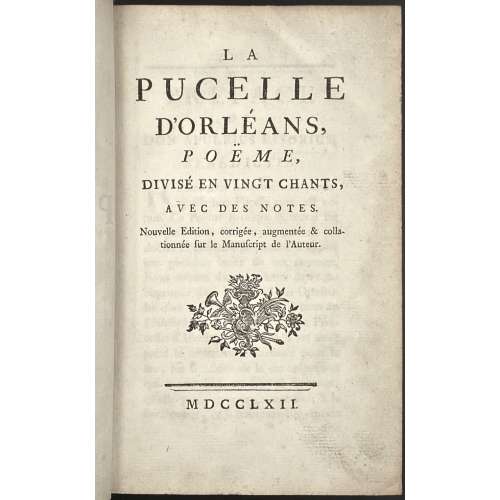 [François Marie Arouet de Voltaire]. La Pucelle d'Orléans, poëme, divisé en vingt chants, avec des notes. Nouvelle édition, corrigée, augmentée & collationnée sur le manuscript de l'auteur. – [Geneva: Gabriel Cramer], 1762.Illustrated book with 20 etchings and numerous woodcut vignettes.Illustrated by: Hubert-François Bourguignon, a.k.a. Gravelot (French, 1699–1773) Author: François Marie Arouet de Voltaire (French, 1694–1778) Printer: Gabriel Cramer (Swiss, 1723–1793)Pagination: [2 blanks, "Ex libris JCP" to recto] [2 - h.t., blank] [2 - t.p., blank], [i] ii-viii, [1] 2-358 [2 blanks]; 20 engraved plates, unsigned, one before every chant, by Gravelot (Hubert-François Bourguignon).Year of Publication: 1762Place of Publication: Geneva, SwitzerlandSize: 8vo, 19.8 x 12.6 x 3.7 cm.Binding: Full mottled calf, restored, flat spine, decorated in gilt, red labels with gilt lettering "Oeuvres de Voltaire; La Pucelle, tom XXII"; marbled endpapers and all margins.CATALOGUE RAISONNÉ: Cohen-de Ricci 1029.Mentions: MFA: ACCESSION NUMBER 25.701.Another copy in this collection: LIB-2580.2020.
[François Marie Arouet de Voltaire]. La Pucelle d'Orléans, poëme, divisé en vingt chants, avec des notes. Nouvelle édition, corrigée, augmentée & collationnée sur le manuscript de l'auteur. – [Geneva: Gabriel Cramer], 1762.Illustrated book with 20 etchings and numerous woodcut vignettes.Illustrated by: Hubert-François Bourguignon, a.k.a. Gravelot (French, 1699–1773) Author: François Marie Arouet de Voltaire (French, 1694–1778) Printer: Gabriel Cramer (Swiss, 1723–1793)Pagination: [2 blanks, "Ex libris JCP" to recto] [2 - h.t., blank] [2 - t.p., blank], [i] ii-viii, [1] 2-358 [2 blanks]; 20 engraved plates, unsigned, one before every chant, by Gravelot (Hubert-François Bourguignon).Year of Publication: 1762Place of Publication: Geneva, SwitzerlandSize: 8vo, 19.8 x 12.6 x 3.7 cm.Binding: Full mottled calf, restored, flat spine, decorated in gilt, red labels with gilt lettering "Oeuvres de Voltaire; La Pucelle, tom XXII"; marbled endpapers and all margins.CATALOGUE RAISONNÉ: Cohen-de Ricci 1029.Mentions: MFA: ACCESSION NUMBER 25.701.Another copy in this collection: LIB-2580.2020. -
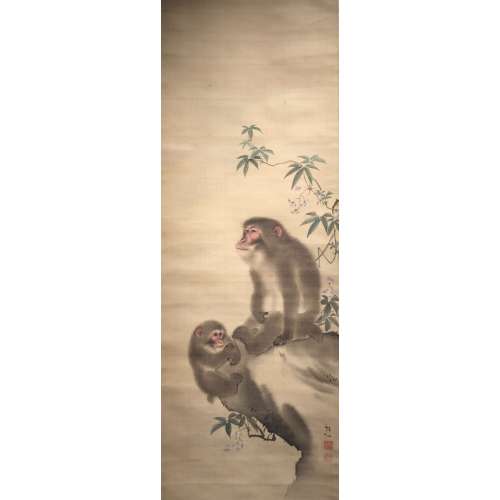 Mori Sosen (1747-1821). A Monkey Seated on a Rock with an Infant Monkey. Hanging scroll painting. Ink and colour on silk. Signed: Sosen. Sealed: Sosen. 108.3 x 38.3 cm. Provenance: According to the box inscriptions, the painting was in the possession of Itakura Katsunao, a daimyo lord in present-day Gunma, in 1808. In 1881, the painting was subsequently acquired by Negishi Shôrei (1833-1897) a master swordsman who established the Negishi school of shuriken ("The only specialist school to have survived is the Negishi-ryū, which was founded by Negishi Shorei in the mid-1800s".)
Mori Sosen (1747-1821). A Monkey Seated on a Rock with an Infant Monkey. Hanging scroll painting. Ink and colour on silk. Signed: Sosen. Sealed: Sosen. 108.3 x 38.3 cm. Provenance: According to the box inscriptions, the painting was in the possession of Itakura Katsunao, a daimyo lord in present-day Gunma, in 1808. In 1881, the painting was subsequently acquired by Negishi Shôrei (1833-1897) a master swordsman who established the Negishi school of shuriken ("The only specialist school to have survived is the Negishi-ryū, which was founded by Negishi Shorei in the mid-1800s".) -
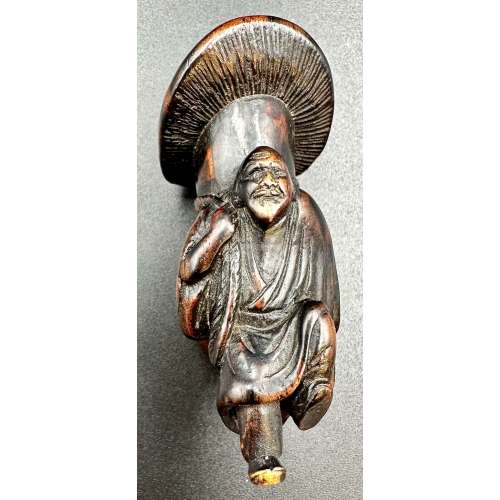 NEW
NEWNetsuke with a design of an old man carrying a giant mushroom on his back. Possibly signed on his left foot. According to Merrily Baird (Symbols of Japan, page. 93): ... This prominent use in the symbol-rich netsuke art form, however, reflects more their sexual symbolism than either their dietary appeal or interesting shapes. Mushrooms in Japan are generally a symbol of fertility, with some flat varieties, like shiitake, being associated with females. In contrast, the matsutake mushroom (Armillaria edodes) is a phallic symbol, as befits its thick, spearlike stem and the fact that it is consumed before cap opens.
Seller's description: "The old man carved walking, with one foot slightly raised, wearing a loose fitted robe and carrying a large long-stemmed mushroom on his back. The wood stained and bearing a fine patina. Himotoshi through the mushroom stem". See VO-0270.2018 for the same subject. Late 18th century. Dimensions: 62 mm tall -
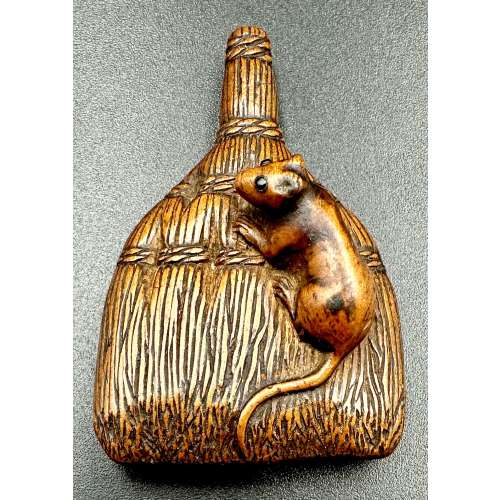 NEWFinely carved as a rat (nezumi) seated on a shuro brush, bound naturalistically with thick bristles. The rodent with a long trailing tail and eyes inlaid in a dark horn. Generously excavated, asymmetrical himotoshi to the underside. According to Merrily Baird (Symbols of Japan, p. 156): …The Japanese do not clearly differentiate between the rat and the mouse, and one word, nezumi [鼠], designates both. …Rat is a messenger of Daikokuten, a deity of grain and vegetation who is one of Japan’s Seven Gods of Good Luck. ...Depictions of the rat are most common in years of the zodiac represented by the animal. Late 18th century. Dimensions: 49 x 33 x 16 mm. Provenance: From the private collection of Armand Basi (Spanish, 1924-2009).
NEWFinely carved as a rat (nezumi) seated on a shuro brush, bound naturalistically with thick bristles. The rodent with a long trailing tail and eyes inlaid in a dark horn. Generously excavated, asymmetrical himotoshi to the underside. According to Merrily Baird (Symbols of Japan, p. 156): …The Japanese do not clearly differentiate between the rat and the mouse, and one word, nezumi [鼠], designates both. …Rat is a messenger of Daikokuten, a deity of grain and vegetation who is one of Japan’s Seven Gods of Good Luck. ...Depictions of the rat are most common in years of the zodiac represented by the animal. Late 18th century. Dimensions: 49 x 33 x 16 mm. Provenance: From the private collection of Armand Basi (Spanish, 1924-2009). -
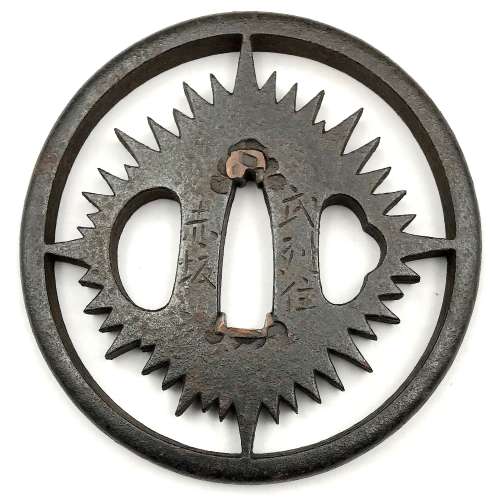 Iron tsuba of round form with slanting rays of light (shakoh) Christian motif (Jesuit’s IHS symbol) in openwork (sukashi). Traditional description of this kind of design is called “tokei”, or “clock gear”. Signed: On the face: Bushu ju Akasaka; On the back: Tadatoki Saku [Made by Tadatoki, resident of Bushu]. Probably, 4th generation of Akasaka School master Tadatoki (忠時), who died in 1746. Akasaka School. Edo period, first half of the 18th century. Size: 79.8 x 78.5 x 6.5 mm
Iron tsuba of round form with slanting rays of light (shakoh) Christian motif (Jesuit’s IHS symbol) in openwork (sukashi). Traditional description of this kind of design is called “tokei”, or “clock gear”. Signed: On the face: Bushu ju Akasaka; On the back: Tadatoki Saku [Made by Tadatoki, resident of Bushu]. Probably, 4th generation of Akasaka School master Tadatoki (忠時), who died in 1746. Akasaka School. Edo period, first half of the 18th century. Size: 79.8 x 78.5 x 6.5 mm -
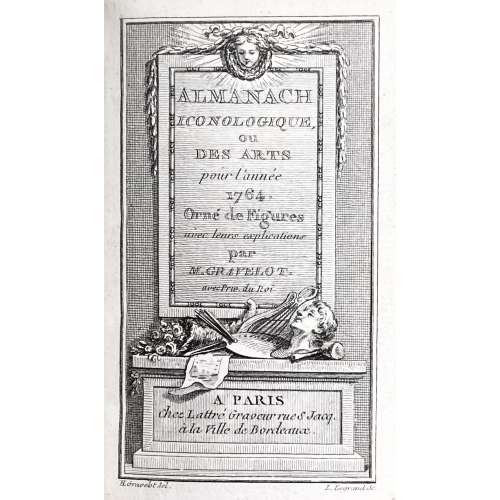
Engraved title:
Upper frame: ALMANACH | ICONOLOGIQUE, | OU | DES ARTS | pour l'année | 1764. | Orné de Figures | avec leurs explications | par | M. GRAVELOT. | avec Priv. du Roy | A PARIS
Lower frame: Chez Lattré Graveur rue S. Jacq. | à la Ville de Bordeaux.
Under the frame: H. Gravelot del. — L. Legrand sc.
28 leaves, of them: engraved t.p., engraved frontis., and 12 plates, text engraved. Pages numbered 1-12, and I-XII (incorrectly marked XVI), other unpaginated, unbound tissue guards. Size: 10.6 x 7.2 cm, full polished crimson calf w/veins, triple-ruled in gilt with florets in corners, flat spine, double-ruled in gilt, all edges gilt. Florets in compartments, black title label with gilt lettering “ALM | ICON ||”, peacock marbled endpapers, blue silk ribbon. Approbation dated 15 November 1763, as some plates.
Catalogue raisonné: Cohen, De Ricci 454.
-
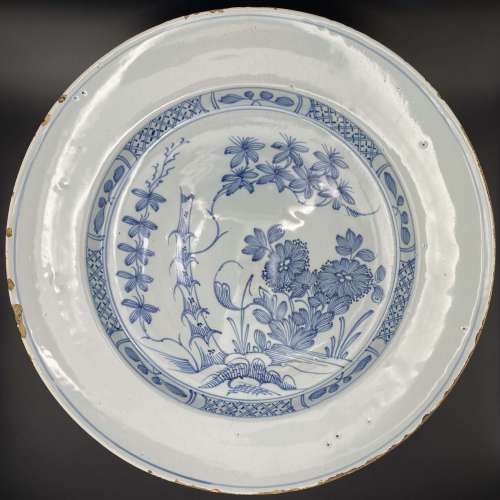 Round plate with a blue and white design of blossoming bamboo and chrysanthemums in the centre with a border of lattice and floral sprays. Diameter: 34 cm, Haight: 5.5 cm.
Round plate with a blue and white design of blossoming bamboo and chrysanthemums in the centre with a border of lattice and floral sprays. Diameter: 34 cm, Haight: 5.5 cm. -
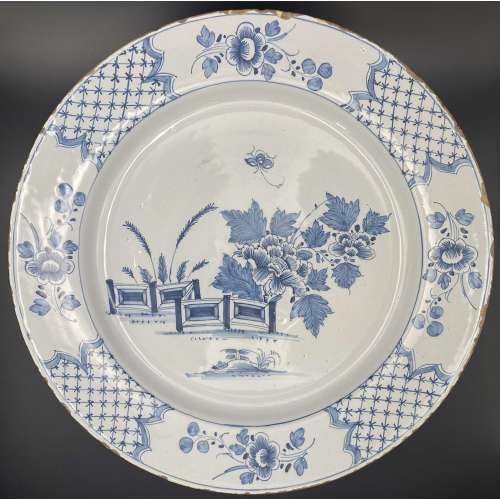 Round plate with a blue and white design of blossoming peony behind a fence with lattice and floral border; flowers to the bottom. Diameter: 33 cm, Haight: 4.5 cm.
Round plate with a blue and white design of blossoming peony behind a fence with lattice and floral border; flowers to the bottom. Diameter: 33 cm, Haight: 4.5 cm. -
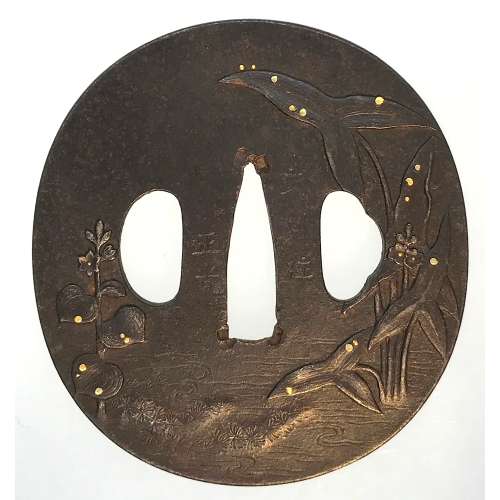
An iron tsuba of oval form decorated with a water plantain (omodaka) carved in low relief and water drops inlaid in gold.
Signed: Bushū jū Masamitsu.
Bushū-Itō school.Height: 71.8; Width: 67.3; Thickness: 3.6; Weight: 96 g.
Mid to late Edo period; 18th-19th century.
There were several tsuba artists with the name of Masamitsu. The one who worked with iron and spelled [正光] is mentioned at Markus Sesko's 'Genealogies' on page 106 in Akasaka School of Edo section as Masamitsu Gorōbei , student of Tadatoki, 4th generation Akasaka master. The name is not mentioned at Torigoye/Haynes 'Tsuba. An Aesthetic Study' in the list of Bushū-Itō family masters on page 181. -
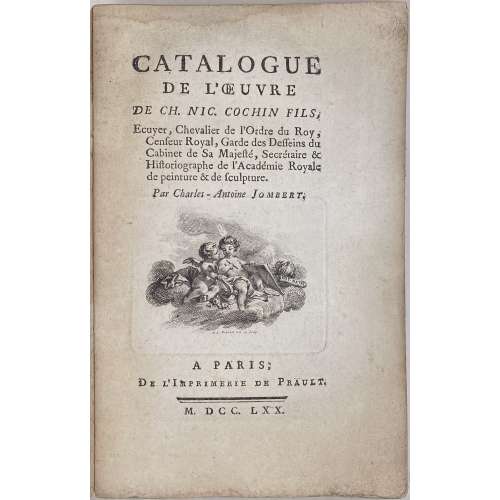 Description: one volume 20 x 12.8 cm, collated 8vo, in grey wrappers (original?), printed on laid paper, with tall “s”, two vignettes by Benoît-Louis Prévost to A1 and A3, 320 entries, where entry 320 Portraits et médaillons, consists of 121 entries itself. Title-page: CATALOGUE | DE L'ŒUVRE | DE CH. NIC. COCHIN FILS, | Ecuyer, Chevalier de l’Ordre du Roy, | Censeur Royal, Garde des Desseins du | Cabinet de Sa Majesté, Secrétaire & | Historiographe de l'Académie Royale | de peinture & de sculpture. | Par Charles-Antoine Jombert. | {vignette by Benoît-Louis Prévost} | A PARIS ; | De l’Imprimerie de Prault. | — | M. DCC. LXX. || Collation: A-I8, K1 (approbation), χ 8 (blanks), two in-text vignettes, total 81 leaves. Pagination: [1-5] 6-144 [145] [17 blanks], ils.; total 162 pages. Ref: Gallica-BnF. Contributors: Charles-Antoine Jombert (French, 1712 – 1784) – author. Charles Nicolas Cochin (French, 1715 – 1790) Benoît-Louis Prévost (French, 1735/47 – 1804) Laurent-François Prault (French, 1712 – 1780)
Description: one volume 20 x 12.8 cm, collated 8vo, in grey wrappers (original?), printed on laid paper, with tall “s”, two vignettes by Benoît-Louis Prévost to A1 and A3, 320 entries, where entry 320 Portraits et médaillons, consists of 121 entries itself. Title-page: CATALOGUE | DE L'ŒUVRE | DE CH. NIC. COCHIN FILS, | Ecuyer, Chevalier de l’Ordre du Roy, | Censeur Royal, Garde des Desseins du | Cabinet de Sa Majesté, Secrétaire & | Historiographe de l'Académie Royale | de peinture & de sculpture. | Par Charles-Antoine Jombert. | {vignette by Benoît-Louis Prévost} | A PARIS ; | De l’Imprimerie de Prault. | — | M. DCC. LXX. || Collation: A-I8, K1 (approbation), χ 8 (blanks), two in-text vignettes, total 81 leaves. Pagination: [1-5] 6-144 [145] [17 blanks], ils.; total 162 pages. Ref: Gallica-BnF. Contributors: Charles-Antoine Jombert (French, 1712 – 1784) – author. Charles Nicolas Cochin (French, 1715 – 1790) Benoît-Louis Prévost (French, 1735/47 – 1804) Laurent-François Prault (French, 1712 – 1780) -
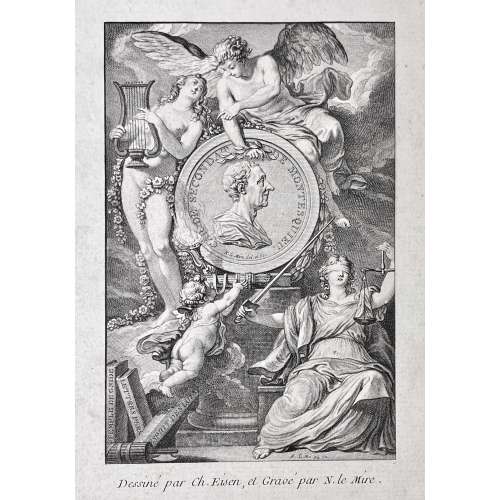 Hardcover volume, 8vo, 24.3 x 16.5 cm, bound in contemporary full marbled calf, spine with raised bands, gilt floral tools in compartments, gilt title lettering, marbled end-papers and all edges, printed on laid paper 23.9 x 5.5 cm with a watermark, entirely engraved (frontispiece, title, nine plates, and text), gatherings not indicated. Title-page (engraved, vignette, tall 's') LE | TEMPLE | DE | GNIDE | Nouvelle Edition, | Avec Figures | Gravées par N. LE MIRE, | des Acad. De Vienne en Autriche et de Rouen, | D’apres les Dessins de Ch. Eisen. | Le Texte Gravé par Droüet. | — | {3 lines quotation from Gallien} | A PARIS | Chez le Mire Graveur | Rue St. Etienne des Gres. | AVEC PRIVELEGE DU ROI. | 1772. || Frontispiece (engraved, vignette): Portrait medallion inscribed "CHARLES SECONDAT DE MONTESQUIEU — N. Le Mire del et sc", signed beneath "N. le Mire sculp 1771"; under the plate: "Dessiné par Ch. Eisen, et Gravé par N. le Mire." Pagination: frontispiece, t.p. / explication, dedication, [i] ii-vii [viii blank] 1-104 [105-6 blanks]; engraved throughout, plus 9 plates by Le Mire after Eisen.Catalogue Raisonné: Cohen-de Ricci 726-27; Ray, French Illustrated Book, №32/p. 61-2.Ref.: MFA (Boston): Accession Number 37.1726.Charles Eisen (French, 1720 – 1778) – artist. Noël Le Mire (French, 1724 – 1801) – engraver, publisher. Droüet (French, 18th century) – text engraver. Charles Louis de Secondat, Baron de La Brède et de Montesquieu (French, 1689 – 1755) – author.
Hardcover volume, 8vo, 24.3 x 16.5 cm, bound in contemporary full marbled calf, spine with raised bands, gilt floral tools in compartments, gilt title lettering, marbled end-papers and all edges, printed on laid paper 23.9 x 5.5 cm with a watermark, entirely engraved (frontispiece, title, nine plates, and text), gatherings not indicated. Title-page (engraved, vignette, tall 's') LE | TEMPLE | DE | GNIDE | Nouvelle Edition, | Avec Figures | Gravées par N. LE MIRE, | des Acad. De Vienne en Autriche et de Rouen, | D’apres les Dessins de Ch. Eisen. | Le Texte Gravé par Droüet. | — | {3 lines quotation from Gallien} | A PARIS | Chez le Mire Graveur | Rue St. Etienne des Gres. | AVEC PRIVELEGE DU ROI. | 1772. || Frontispiece (engraved, vignette): Portrait medallion inscribed "CHARLES SECONDAT DE MONTESQUIEU — N. Le Mire del et sc", signed beneath "N. le Mire sculp 1771"; under the plate: "Dessiné par Ch. Eisen, et Gravé par N. le Mire." Pagination: frontispiece, t.p. / explication, dedication, [i] ii-vii [viii blank] 1-104 [105-6 blanks]; engraved throughout, plus 9 plates by Le Mire after Eisen.Catalogue Raisonné: Cohen-de Ricci 726-27; Ray, French Illustrated Book, №32/p. 61-2.Ref.: MFA (Boston): Accession Number 37.1726.Charles Eisen (French, 1720 – 1778) – artist. Noël Le Mire (French, 1724 – 1801) – engraver, publisher. Droüet (French, 18th century) – text engraver. Charles Louis de Secondat, Baron de La Brède et de Montesquieu (French, 1689 – 1755) – author. -
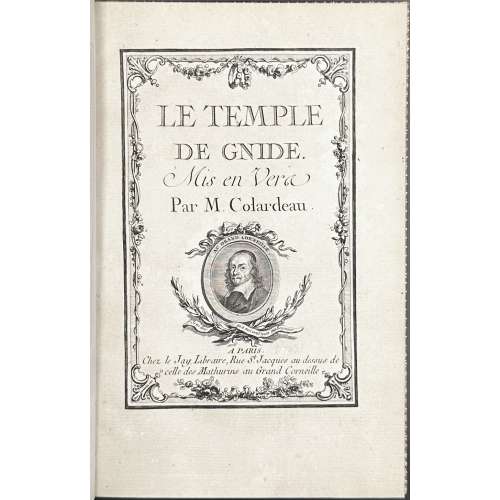 Hardcover volume, 8vo, 21.5 x 14.5 cm, bound by Riviere & Son (stamped on fep verso bottom) in full brown calf, boards with triple gilt fillet border and gilt dentelle inside, spine with raised bands, gilt in compartments, black label with gilt lettering, all margins gilt, blue endpapers, bookplate of Arthur Rau pasted to front pastedown (text: Les hommes sont méchants mais leurs livres sont bons / Arthur Rau; signed: E. H. New – A.D. 1922), traces of removed owner’s label to fep recto; printed on laid paper. Title-page (engraved, in floral frame): LE TEMPLE | DE GNIDE. | Mis en Vers | Par M. Colardeau | {vignette with portrait of Pierre Corneille} | A PARIS | Chez le Jay, Libraire, Rue St. Jacques au dessus de | celle des Mathurins au Grand Corneille || Collation: 2 blanks, h.t., engraved t.p. with a portrait of Pierre Corneille, a8, A-E8 F4 (52 leaves), 2 blanks, plus 7 plates by various engravers after Charles Monnet. Pagination: [i] ii-xvi, [1] 2-88 (104 pp). Ref: MFA (Boston): accession number 37.1747 Catalogue raisonné: Lewine 114, Cohen-DeRicci 245-6. Contributors: Charles Monnet (French, 1732 – after 1808) – artist. Engravers: Jean Charles Baquoy (French, 1721 – 1777) Nicolas Delaunay (French, 1739 – 1792) Isidore Stanislas Helman (French, 1743 – 1806) Louis Joseph Masquelier (French, 1741 – 1811) François Denis Née (French, 1735 – 1818) Nicholas Ponce (French, 1746 – 1831) Portrait(s) designed by: Guillaume Voiriot (French, 1713 – 1799) Author: Charles-Pierre Colardeau (French, 1732 – 1776) Publisher: Edmé-Jean Le Jay (French, 1734 – 1795) Bookplate artist: Edmund Hort New (British, 1871 – 1931) Provenance: Arthur Rau (British, 1898 – 1972); his obituary can be found in The Book Collector 1973, vol. 22, n°1, p. 86-89. According to the genealogy service Geni, Arthur Aron Rau was born to Jacob Aryeh Rau and Katharina (Kaethe) Rau, and has a sister Cecilia (Tsipporah) Rosenfelder and a brother Frederick Solomon Rau. He went to Oxford and then joined Maggs Brothers in their Paris establishment. "After some years there, he set up on his own, returning to England at the outbreak of the Second World War to be a schoolmaster for ten years". In 1949 he returned to Paris and retired in 1963, "and his last years he happily spent in Wensleydale...". All he published during his lifetime were two catalogues, Livres Rares Et Anciens. Manuscrits et Autographes. — Paris: Arthur Rau, 1932-3 and Cinquante Tres Beaux Livres Avec Un Appendice. — Paris: Arthur Rau, 1933. He also contributed to The Book Collector.Seller’s description: In-8° : [2]-t. gr.-xvi-88 pp. ; 7 h.-t. (qqs rouss.). - Poème d'après le roman de Montesquieu ill. de 7 eaux-fortes par Bacquoy, Delaunay, Née, etc., d'après Charles Monnet. Titre gr. orné d'un portr. de Corneille. Cohen, qui cite un ex. millésimé 1773, signale des ex. avec la date de 1772 ou sans date. - Réf. Cohen 245-246. - Conlon 72:675 (éd. à l'adresse d'Amsterdam et Paris, 1772). - Pas dans Reynaud. - Prov. Arthur Rau (1898-1972), gérant de la librairie Maggs à Paris avant d'ouvrir sa propre librairie en 1932 (ex-libris gr. par E.H. New, 1922 ; réf. BnF). - Traces d'ex-libris décollé à la garde sup.
Hardcover volume, 8vo, 21.5 x 14.5 cm, bound by Riviere & Son (stamped on fep verso bottom) in full brown calf, boards with triple gilt fillet border and gilt dentelle inside, spine with raised bands, gilt in compartments, black label with gilt lettering, all margins gilt, blue endpapers, bookplate of Arthur Rau pasted to front pastedown (text: Les hommes sont méchants mais leurs livres sont bons / Arthur Rau; signed: E. H. New – A.D. 1922), traces of removed owner’s label to fep recto; printed on laid paper. Title-page (engraved, in floral frame): LE TEMPLE | DE GNIDE. | Mis en Vers | Par M. Colardeau | {vignette with portrait of Pierre Corneille} | A PARIS | Chez le Jay, Libraire, Rue St. Jacques au dessus de | celle des Mathurins au Grand Corneille || Collation: 2 blanks, h.t., engraved t.p. with a portrait of Pierre Corneille, a8, A-E8 F4 (52 leaves), 2 blanks, plus 7 plates by various engravers after Charles Monnet. Pagination: [i] ii-xvi, [1] 2-88 (104 pp). Ref: MFA (Boston): accession number 37.1747 Catalogue raisonné: Lewine 114, Cohen-DeRicci 245-6. Contributors: Charles Monnet (French, 1732 – after 1808) – artist. Engravers: Jean Charles Baquoy (French, 1721 – 1777) Nicolas Delaunay (French, 1739 – 1792) Isidore Stanislas Helman (French, 1743 – 1806) Louis Joseph Masquelier (French, 1741 – 1811) François Denis Née (French, 1735 – 1818) Nicholas Ponce (French, 1746 – 1831) Portrait(s) designed by: Guillaume Voiriot (French, 1713 – 1799) Author: Charles-Pierre Colardeau (French, 1732 – 1776) Publisher: Edmé-Jean Le Jay (French, 1734 – 1795) Bookplate artist: Edmund Hort New (British, 1871 – 1931) Provenance: Arthur Rau (British, 1898 – 1972); his obituary can be found in The Book Collector 1973, vol. 22, n°1, p. 86-89. According to the genealogy service Geni, Arthur Aron Rau was born to Jacob Aryeh Rau and Katharina (Kaethe) Rau, and has a sister Cecilia (Tsipporah) Rosenfelder and a brother Frederick Solomon Rau. He went to Oxford and then joined Maggs Brothers in their Paris establishment. "After some years there, he set up on his own, returning to England at the outbreak of the Second World War to be a schoolmaster for ten years". In 1949 he returned to Paris and retired in 1963, "and his last years he happily spent in Wensleydale...". All he published during his lifetime were two catalogues, Livres Rares Et Anciens. Manuscrits et Autographes. — Paris: Arthur Rau, 1932-3 and Cinquante Tres Beaux Livres Avec Un Appendice. — Paris: Arthur Rau, 1933. He also contributed to The Book Collector.Seller’s description: In-8° : [2]-t. gr.-xvi-88 pp. ; 7 h.-t. (qqs rouss.). - Poème d'après le roman de Montesquieu ill. de 7 eaux-fortes par Bacquoy, Delaunay, Née, etc., d'après Charles Monnet. Titre gr. orné d'un portr. de Corneille. Cohen, qui cite un ex. millésimé 1773, signale des ex. avec la date de 1772 ou sans date. - Réf. Cohen 245-246. - Conlon 72:675 (éd. à l'adresse d'Amsterdam et Paris, 1772). - Pas dans Reynaud. - Prov. Arthur Rau (1898-1972), gérant de la librairie Maggs à Paris avant d'ouvrir sa propre librairie en 1932 (ex-libris gr. par E.H. New, 1922 ; réf. BnF). - Traces d'ex-libris décollé à la garde sup. -
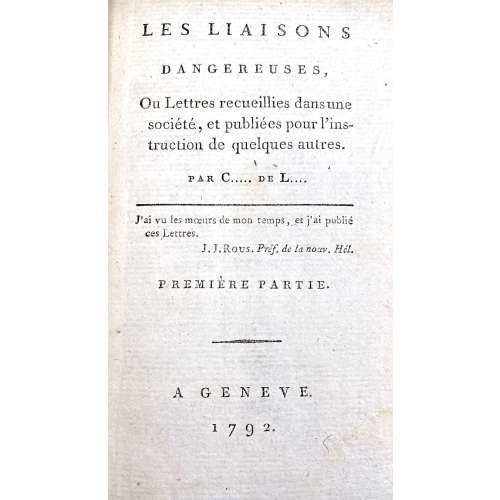 Four parts bound in two 18mo volumes (1-2 & 3-4), half polished brown calf, dot-ruled, flat spine with gilt bands and lettering, marbled boards, some plates with guard sheets, margins sparkled red. Title-page: LES LIAISONS | DANGEREUSES, | Ou Lettres recueillies dans une | société, et publiées pour l’ins- | truction de quelques autres. | par C….. de L… | — | J’ai vu les mœurs de mon temps, et j’ai publié | ces Lettres. | J. J. Rous. Préf. De la nouv. Hél. | PREMIÈRE PARTIE. | — | A GENEVE. | 1792. || Vol. 1: Pagination: ffep, blank, [2] – h.t., [i, ii] – t.p. part one, [iii] iv-xxij, [1] 2-245 [246] + 2 plates (p. 26 & p. 75); [1, 2] – h.t., [3, 4] – t.p. part two, [5] 6-233 [234], fep + 2 plates (p. 59 & p. 222). Collation: part 1: a12, A-M18 N5; part 2: A-M18 N9, plus four plates by various engravers after Le Barbier. Vol. 2: Pagination: ffep, blank, [1, 2] – h.t., [3, 4] – t.p. part three, [5] 6-225 [226] + 2 plates (p. 69 & p. 215); [1, 2] – h.t., [3, 4] – t.p. part four, [5] 6-250, fep + 2 plates (p. 25 & p. 201). Collation: part 3: A-M18 N5; part 4: A-N18 O5, plus four plates by various engravers after Le Barbier. Illustrations: After Le Barbier, engravers: Halbou (1), Simonet (1), N. Thomas (2), Dambrun (2), and Delignon (2). In the first illustration (vol. 1, part one, p. 26) Le Barbier signed “Le Barbier Jnv. 1794”, however, the edition was published (anonymously) in 1792. Cohen-De Ricci mentions an edition of 1794 (Paris: Maradan) and 1801 (Genéve) with the same plates. Lewine mentions a reprint of 1794 without naming the publisher. Catalogue raisonné: Cohen-De Ricci: 234-5, Ray: p. 79; Lewine: 109-10. Contributors: Choderlos de Laclos, Pierre Ambroise François (French, 1741 – 1803) – author. Le Barbier, Jean-Jacques-François (French, 1738 – 1826) – artist Engravers: Dambrun, Jean (French, 1741 – c. 1808) Delignon, Jean Louis (French, 1755 – 1804) Halbou, Louis Michel (1730 – 1809) Thomas, N. (French, c. 1750 – 1812) Simonet, Jean-Baptiste Blaise (French, 1742 – 1813)
Four parts bound in two 18mo volumes (1-2 & 3-4), half polished brown calf, dot-ruled, flat spine with gilt bands and lettering, marbled boards, some plates with guard sheets, margins sparkled red. Title-page: LES LIAISONS | DANGEREUSES, | Ou Lettres recueillies dans une | société, et publiées pour l’ins- | truction de quelques autres. | par C….. de L… | — | J’ai vu les mœurs de mon temps, et j’ai publié | ces Lettres. | J. J. Rous. Préf. De la nouv. Hél. | PREMIÈRE PARTIE. | — | A GENEVE. | 1792. || Vol. 1: Pagination: ffep, blank, [2] – h.t., [i, ii] – t.p. part one, [iii] iv-xxij, [1] 2-245 [246] + 2 plates (p. 26 & p. 75); [1, 2] – h.t., [3, 4] – t.p. part two, [5] 6-233 [234], fep + 2 plates (p. 59 & p. 222). Collation: part 1: a12, A-M18 N5; part 2: A-M18 N9, plus four plates by various engravers after Le Barbier. Vol. 2: Pagination: ffep, blank, [1, 2] – h.t., [3, 4] – t.p. part three, [5] 6-225 [226] + 2 plates (p. 69 & p. 215); [1, 2] – h.t., [3, 4] – t.p. part four, [5] 6-250, fep + 2 plates (p. 25 & p. 201). Collation: part 3: A-M18 N5; part 4: A-N18 O5, plus four plates by various engravers after Le Barbier. Illustrations: After Le Barbier, engravers: Halbou (1), Simonet (1), N. Thomas (2), Dambrun (2), and Delignon (2). In the first illustration (vol. 1, part one, p. 26) Le Barbier signed “Le Barbier Jnv. 1794”, however, the edition was published (anonymously) in 1792. Cohen-De Ricci mentions an edition of 1794 (Paris: Maradan) and 1801 (Genéve) with the same plates. Lewine mentions a reprint of 1794 without naming the publisher. Catalogue raisonné: Cohen-De Ricci: 234-5, Ray: p. 79; Lewine: 109-10. Contributors: Choderlos de Laclos, Pierre Ambroise François (French, 1741 – 1803) – author. Le Barbier, Jean-Jacques-François (French, 1738 – 1826) – artist Engravers: Dambrun, Jean (French, 1741 – c. 1808) Delignon, Jean Louis (French, 1755 – 1804) Halbou, Louis Michel (1730 – 1809) Thomas, N. (French, c. 1750 – 1812) Simonet, Jean-Baptiste Blaise (French, 1742 – 1813) -
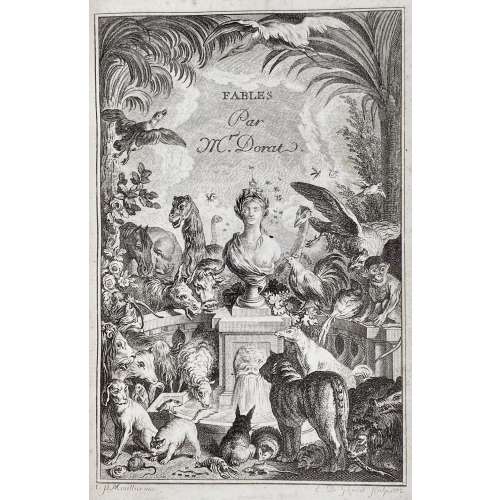 Title-page: FABLES | NOUVELLES. | {vignette by Ponce after Marillier} | A LA HAYE, | Et se trouve a Paris, | Chez Delalain, rue de la Comédie Françoise. | — | M. DCC. LXXIII. || Collation: 2 volumes (4 livres) in one, 1st blank, engraved t.p. “FABLES | Par | Mr. Dorat.” signed C. P. Marillier, inv. – E. D. Ghendt Sculp. 1772; a-c4, A-Z4 2A-2Q4, last blank, plus engraved frontispiece before A1 by Nicolas Delaunay and engraved d.t.p. before Z1: “Fables | de M. Dorat | II. Volume” also by Ghendt after Marillier., 99 vignettes and 99 tailpieces, all after Marillier. Lacking Delaunay frontispiece for the second volume (similar to the 1st). Edition: This is a vol. 1 176 pp. copy (Ray, 43). 2nd edition after Fables ou allégories philosophiques, 1772, p. 162 corrected: “Je sais , même au sein des poisons / Puiser le suc qui m'est utile”. Page xxii numbered correctly; on top of p. iii, printed a chain instead of a triple fillet in later issues (Ray, 43A). Pagination: [i, ii] iii-xxii, [2 d.t.p. «Livre premier»] [1] 2-309 [3 table], 3 plates. Binding: Crimson crashed morocco (198 x 133 mm) ruled in gilt, spine with raised bands gilt in compartments with gilt-lettered cream calf label, gilt dentelle inside, marbled endpapers, Pauli Menso bookplate pasted to front pastedown, printed on laid paper, AEG. Catalogue raisonné: Cohen-DeRicci: 313-315; Ray (French): № 43, pp. 81-83. Provenance: Pauli Menso. We only present a sample of illustrations, as their total number is enormous. Contributors: Author: Claude Joseph Dorat (French, 1734–1780) Publisher: Delalain (firm) (18th century) Artist: Clément Pierre Marillier (French, 1740–1808) Engravers: Jean Charles Baquoy (French, 1721–1777) Nicolas Delaunay (French, 1739–1792) Pierre Duflos (French, born in 1751) Emmanuel Jean Nepomucène de Ghendt (Flemish, worked in France, 1738–1815) Yves-Marie Le Gouaz (French, 1742–1816) Pierre Adrien Le Beau (French, 1748–after 1800) Jean-Jacques André Le Veau (French, 1729–1786) Charles Louis Lingée (French, 1748–1819) Joseph de Longueil (French, 1730–1792) Louis Legrand (French, 1723–1807) Jacques Le Roy (French, born in 1739) Louis Joseph Masquelier (French, 1741–1811) François Denis Née (French, 1735–1818) Nicholas Ponce (French, 1746–1831) Marguerite (Hémery) Ponce (French, born in 1745) Jean Baptiste Simonet (French, 1742–1813)
Title-page: FABLES | NOUVELLES. | {vignette by Ponce after Marillier} | A LA HAYE, | Et se trouve a Paris, | Chez Delalain, rue de la Comédie Françoise. | — | M. DCC. LXXIII. || Collation: 2 volumes (4 livres) in one, 1st blank, engraved t.p. “FABLES | Par | Mr. Dorat.” signed C. P. Marillier, inv. – E. D. Ghendt Sculp. 1772; a-c4, A-Z4 2A-2Q4, last blank, plus engraved frontispiece before A1 by Nicolas Delaunay and engraved d.t.p. before Z1: “Fables | de M. Dorat | II. Volume” also by Ghendt after Marillier., 99 vignettes and 99 tailpieces, all after Marillier. Lacking Delaunay frontispiece for the second volume (similar to the 1st). Edition: This is a vol. 1 176 pp. copy (Ray, 43). 2nd edition after Fables ou allégories philosophiques, 1772, p. 162 corrected: “Je sais , même au sein des poisons / Puiser le suc qui m'est utile”. Page xxii numbered correctly; on top of p. iii, printed a chain instead of a triple fillet in later issues (Ray, 43A). Pagination: [i, ii] iii-xxii, [2 d.t.p. «Livre premier»] [1] 2-309 [3 table], 3 plates. Binding: Crimson crashed morocco (198 x 133 mm) ruled in gilt, spine with raised bands gilt in compartments with gilt-lettered cream calf label, gilt dentelle inside, marbled endpapers, Pauli Menso bookplate pasted to front pastedown, printed on laid paper, AEG. Catalogue raisonné: Cohen-DeRicci: 313-315; Ray (French): № 43, pp. 81-83. Provenance: Pauli Menso. We only present a sample of illustrations, as their total number is enormous. Contributors: Author: Claude Joseph Dorat (French, 1734–1780) Publisher: Delalain (firm) (18th century) Artist: Clément Pierre Marillier (French, 1740–1808) Engravers: Jean Charles Baquoy (French, 1721–1777) Nicolas Delaunay (French, 1739–1792) Pierre Duflos (French, born in 1751) Emmanuel Jean Nepomucène de Ghendt (Flemish, worked in France, 1738–1815) Yves-Marie Le Gouaz (French, 1742–1816) Pierre Adrien Le Beau (French, 1748–after 1800) Jean-Jacques André Le Veau (French, 1729–1786) Charles Louis Lingée (French, 1748–1819) Joseph de Longueil (French, 1730–1792) Louis Legrand (French, 1723–1807) Jacques Le Roy (French, born in 1739) Louis Joseph Masquelier (French, 1741–1811) François Denis Née (French, 1735–1818) Nicholas Ponce (French, 1746–1831) Marguerite (Hémery) Ponce (French, born in 1745) Jean Baptiste Simonet (French, 1742–1813) -
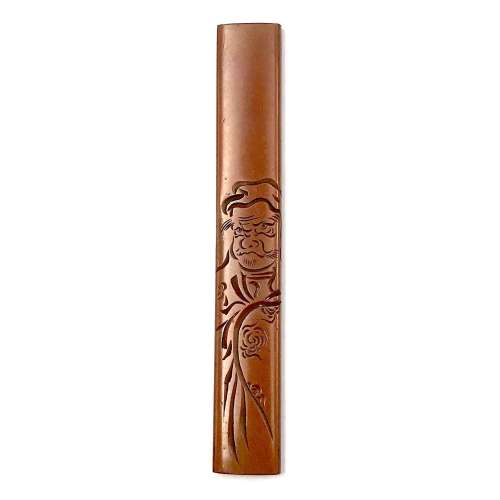 Kozuka made of pure copper with Daruma motif. The engraving technique is known as katakibori ("half-cut carving"). Signed on the back: Yasuchika. Size: 96.5 (H) x 14.5 mm (W). Edo period (Late 18th century). The technique of Katakiribori was developed by Yokoya school of artisans. Detailed account of Yasuchika family of kodōgo carvers is given at Japanese Sword Fittings from the Alexander G. Mosle Collection; Sebastian Izzard LLC, 2004 on page 64. The article ends with the following statement: "Given the popularity of his style and his many students, it is not surprising that a number of works bearing Yasuchika's signature are today disputed." S. Izzard attributes Yasuchika masters to Nara school. Yasuchika-signed kozuka in Important Japanese Swords and Sword Furniture and Works of Art [November 5, 1980, sales "Kotetsu". New York, Christie, Manson & Woods International Inc., 1980, pp.92-93, lot 172 and 173] are stylistically very different to our example. A shibuichi katakiribori kozuka, bearing the signature of Yashuchika, is illustrated at The Hartman Collection of Japanese Metalwork [sold at auction by Christie, Manson & Woods Ltd. June 30 and July 1, London, 1976] on page 82, lot 291. It depicts Daikoku and stylistically similar to ours. The description on page 83 says: "signed Yasuchika, and inscribed "drawn by Hanabusa Itcho" (Yasuchika IV, school of Iawamoto konkan, circa 1800)". A detailed account of Yasuchika signatures is presented at Masterpiece tsuba and kodogu from the Hans Conried and Alexander G. Mosle collections. Important woodblock prints by Utamaro, Hokusai, Hiroshige, Yoshida and other masters. San Francisco, September 1-25, 1983. Catalog #7. Robert E. Haynes, Ltd., pp. 141-174. The example that looks like ours is on page 146:
Kozuka made of pure copper with Daruma motif. The engraving technique is known as katakibori ("half-cut carving"). Signed on the back: Yasuchika. Size: 96.5 (H) x 14.5 mm (W). Edo period (Late 18th century). The technique of Katakiribori was developed by Yokoya school of artisans. Detailed account of Yasuchika family of kodōgo carvers is given at Japanese Sword Fittings from the Alexander G. Mosle Collection; Sebastian Izzard LLC, 2004 on page 64. The article ends with the following statement: "Given the popularity of his style and his many students, it is not surprising that a number of works bearing Yasuchika's signature are today disputed." S. Izzard attributes Yasuchika masters to Nara school. Yasuchika-signed kozuka in Important Japanese Swords and Sword Furniture and Works of Art [November 5, 1980, sales "Kotetsu". New York, Christie, Manson & Woods International Inc., 1980, pp.92-93, lot 172 and 173] are stylistically very different to our example. A shibuichi katakiribori kozuka, bearing the signature of Yashuchika, is illustrated at The Hartman Collection of Japanese Metalwork [sold at auction by Christie, Manson & Woods Ltd. June 30 and July 1, London, 1976] on page 82, lot 291. It depicts Daikoku and stylistically similar to ours. The description on page 83 says: "signed Yasuchika, and inscribed "drawn by Hanabusa Itcho" (Yasuchika IV, school of Iawamoto konkan, circa 1800)". A detailed account of Yasuchika signatures is presented at Masterpiece tsuba and kodogu from the Hans Conried and Alexander G. Mosle collections. Important woodblock prints by Utamaro, Hokusai, Hiroshige, Yoshida and other masters. San Francisco, September 1-25, 1983. Catalog #7. Robert E. Haynes, Ltd., pp. 141-174. The example that looks like ours is on page 146:
 Though we have to admit that the example from Catalog #7 by Robert E. Haynes looks much stronger.
Though we have to admit that the example from Catalog #7 by Robert E. Haynes looks much stronger.
-
 Copper (suaka) tsuba of oval form carved in relief, pierced and inlaid with soft metals (gold, shakudō, shibuichi or silver) with a cormorant fisherman (ushō) and moon motif on the face and a boat among the bank reeds on the reverse. Signed: Nagatsune. Box inscription: Tsuba with cormorant fishing, made by Nagatsune. Dimensions: 62.7 mm x 53.2 mm x 4.2 mm (at seppa-dai) Edo period: 18th century. Nagatsune (1721-1787), 1st generation master of Inchinomiya School in Kyoto, adopted son of the gilder Nagayoshi, student of Yasui Takanaga [M. Sesko 'Genealogies', p. 26]. Detailed account of the school is given at The Japanese toso-kinko Schools.// Lulu Inc., 2012 by Markus Sesko, pp. 104-108. Nagatsune's biographical sketch can be found there on pp. 104-106. "What Sōminis in the East (Edo), Nagatsune is in the West (Kyōto)." “Since Nara period, Japanese fishermen in small boats have used cormorants (u) to catch river fish at night, binding the necks of the birds so that the fish are not swallowed. […] The bird and the work it performs are symbols of selfless devotion to one’s master and keen eyesight.” – from Merrily Baird 'Symbols of Japan. Thematic motifs in art and design.' //Rizzoli international publications, Inc., 2001; p. 104. See also in this collection: TSU-241 and TSU-0096
Copper (suaka) tsuba of oval form carved in relief, pierced and inlaid with soft metals (gold, shakudō, shibuichi or silver) with a cormorant fisherman (ushō) and moon motif on the face and a boat among the bank reeds on the reverse. Signed: Nagatsune. Box inscription: Tsuba with cormorant fishing, made by Nagatsune. Dimensions: 62.7 mm x 53.2 mm x 4.2 mm (at seppa-dai) Edo period: 18th century. Nagatsune (1721-1787), 1st generation master of Inchinomiya School in Kyoto, adopted son of the gilder Nagayoshi, student of Yasui Takanaga [M. Sesko 'Genealogies', p. 26]. Detailed account of the school is given at The Japanese toso-kinko Schools.// Lulu Inc., 2012 by Markus Sesko, pp. 104-108. Nagatsune's biographical sketch can be found there on pp. 104-106. "What Sōminis in the East (Edo), Nagatsune is in the West (Kyōto)." “Since Nara period, Japanese fishermen in small boats have used cormorants (u) to catch river fish at night, binding the necks of the birds so that the fish are not swallowed. […] The bird and the work it performs are symbols of selfless devotion to one’s master and keen eyesight.” – from Merrily Baird 'Symbols of Japan. Thematic motifs in art and design.' //Rizzoli international publications, Inc., 2001; p. 104. See also in this collection: TSU-241 and TSU-0096The design was popular among the tsuba makers. We find one in the Alexander G. Moslé collection [Japanese Sword Fittings from the Alexander G. Moslé Collection; Sebastian Izzard LLC, 2004, page 90, №123] signed Nagatsune with kaō: Tsuba with cormorant fisherman, moon, and boat. Squared-oval shibuichi plate, slightly raised rim, engraved, pierced, and inlaid with soft metals in relief. 6.7 x 5.8 cm.

Alexander G. Moslé collection №123.
Another reference: Lundgren Collection, 1990, page 86 №207: Sword guard with design of ushō (person who fishes with cormorants). Signed by Nagatsune. Ichinomiya school. 6.45 x 5.95 x 0.40 cm. Polished shibuichi taka-bori relief, gold and silver inlay. Edo period, 18th century.

Lundgren Collection №207:
-

Copper tsuba of slightly elongated round form carved in low relief (usuniku-bori, katakiri bori) with the design of a mythical creature: a horse, however, with divided hoofs, with anthropomorphic (human-like) face though with a vertically positioned third eye on the forehead, and a corn. Certain elements of the image accentuated with gold iroe. On the back: flowers and grasses carved in katakiribori technique. Shakudō fukurin.
Edo period.
Dimensions: 70.7 x 70.2 x 3.7 mm In a custom wooden box. -

A copper tsuba with ishime-ji ground carved and polished (migaki-ji) with sitting Daruma; his eyes are inlaid with shakudo and he has a golden earring. The reverse carved with four characters: 廓 然 無 性 (Kakunen-mushō). It is a Zen proverb that goes back to Bodhidharma (Daruma), meaning "boundless expanse and nothing that can be called holy." [Markus Sesko translation]. Shakudo fukurin.
Unsigned.
Edo period (circa 1800). Dimensions: 68.2 x 65.5 x 4.8 (center) x 3.2 (rim) mm -
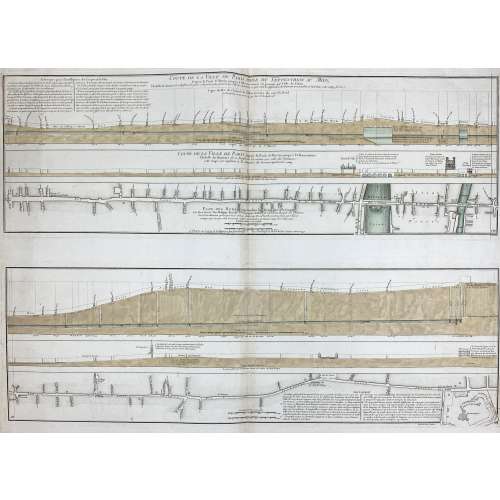
Two prints on one sheet of watermarked laid paper.
Coupe de la ville de Paris prise du septentrion au midy, depuis la porte St Martin jusqu'à l'Observatoire en passant par l'isle du Palais... Coupe de la ville de Paris depuis la porte St Martin jusqu'à l'Observatoire... Plan des rues comprises dans la direction dela coupe... / Le tout dressé par Philippe Buache... ; Desbruslins, sculpsit.
Watermark: "IHS" within circle; countermark of "FIN/ DUPUY/ AUVERGNE 1749".
LOC dates it to 1757. Gallica – to 1742, though the watermark is 1749.
-
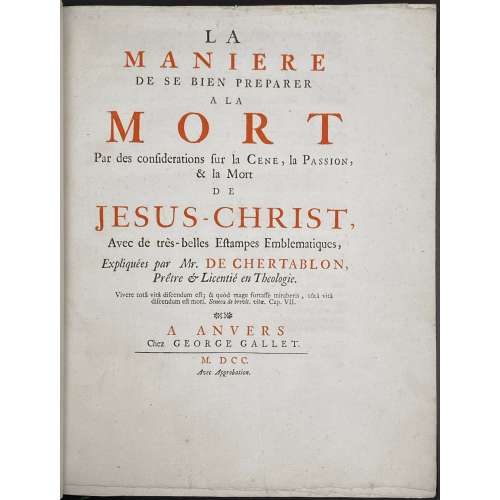 M. de Chertablon. La maniere de se bien preparer a la Mort par des Considerations sur la Cene, la Passion, et la Mort de Jesu-Christ. – Antwerp: George Gallet, 1700. Pagination: ff, [2 - blanks] [2 - t.p., blank] [3 - advert.] 4-63 [64]; 42 copper etched plates by Romeyn de Hooghe: A, B, C, 1-39; [20 - Dutch plate description of the David de la Vigne's Miroir de la bonne mort], bf. Full title: La maniere de se bien preparer a la Mort par des Considerations sur la Cene, la Passion, et la Mort de Jesu-Christ, Avec de très-belles Estampes Emblematiques, Expliquées par Mr. de Chertablon, Piêtre & Licentié en Theologie. Vivere totâ vitâ discendum est; & quòd mage fortasse miraberis, tôtâ vitâ discendum est mori. Seneca de brevit. vitæ. Cap. VII. A Anvers, Chez George Gallet. M DCC, Avec Approbation. / David de La Vigne. Spiegel om wel te sterven, annwyzende met beeltenissen van het lyden onses zaligmaakers Jesu Christi. Verzierd met 42 fyne Geërste Kopere Platen, Door Romain de Hooghe; Te Amsterdam, Voor dezen gedrukt by J. Stigter. Size: 4to, 27.2 x 21.6 cm. Binding: Late 19th century brown calf over marbled boards, spine with gilt lettering, raised bands, double fillet blind panels in compartments; marbled end-papers; bookplate of Samuel Ashton Thompson Yates library, AD 1894. Book illustrated with 42 copperplate etched engravings by Romeyn de Hooghe (Dutch, Amsterdam 1645–1708 Haarlem). According to Bonhams: the plates were "first printed for David de la Vigne's Miroir de la bonne mort. Each of the plates depicts a man contemplating a religious image in order to ease the passing of death, accompanied by commentary and an appropriate verse of scripture for each plate. The present French edition is bound with, as issued, the Dutch translation of David de La Vigne's aforementioned work."
M. de Chertablon. La maniere de se bien preparer a la Mort par des Considerations sur la Cene, la Passion, et la Mort de Jesu-Christ. – Antwerp: George Gallet, 1700. Pagination: ff, [2 - blanks] [2 - t.p., blank] [3 - advert.] 4-63 [64]; 42 copper etched plates by Romeyn de Hooghe: A, B, C, 1-39; [20 - Dutch plate description of the David de la Vigne's Miroir de la bonne mort], bf. Full title: La maniere de se bien preparer a la Mort par des Considerations sur la Cene, la Passion, et la Mort de Jesu-Christ, Avec de très-belles Estampes Emblematiques, Expliquées par Mr. de Chertablon, Piêtre & Licentié en Theologie. Vivere totâ vitâ discendum est; & quòd mage fortasse miraberis, tôtâ vitâ discendum est mori. Seneca de brevit. vitæ. Cap. VII. A Anvers, Chez George Gallet. M DCC, Avec Approbation. / David de La Vigne. Spiegel om wel te sterven, annwyzende met beeltenissen van het lyden onses zaligmaakers Jesu Christi. Verzierd met 42 fyne Geërste Kopere Platen, Door Romain de Hooghe; Te Amsterdam, Voor dezen gedrukt by J. Stigter. Size: 4to, 27.2 x 21.6 cm. Binding: Late 19th century brown calf over marbled boards, spine with gilt lettering, raised bands, double fillet blind panels in compartments; marbled end-papers; bookplate of Samuel Ashton Thompson Yates library, AD 1894. Book illustrated with 42 copperplate etched engravings by Romeyn de Hooghe (Dutch, Amsterdam 1645–1708 Haarlem). According to Bonhams: the plates were "first printed for David de la Vigne's Miroir de la bonne mort. Each of the plates depicts a man contemplating a religious image in order to ease the passing of death, accompanied by commentary and an appropriate verse of scripture for each plate. The present French edition is bound with, as issued, the Dutch translation of David de La Vigne's aforementioned work." -
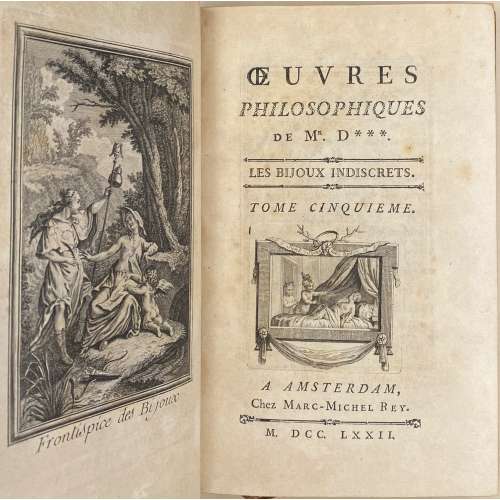 One volume, collated 8vo, 19.5 x 13 cm, later bound in brown full morocco by Pouillet, gilt-bordered covers, raised bands to spine, gilt in compartments, gilt-lettered, double-fillet on cover edges, gilt dentelle inside, signed, all edges gilt, marbled endpapers. Title-page: ŒUVRES | PHILOSOPHIQUES | DE MR. D ***. | — | LES BIJOUX INDISCRETS | — | TOME CINQUIEME | {vignette} | A AMSTERDAM, | Chez Marc-Michel Rey. | — | M. DCC. LXXII. || Pagination: [8] [1] 2-389 [390], total 398 pages, frontis., vignette, plates. Collation: 3 blank leaves at front and rear, π2 a2 A-Aa8 Bb3, total 199 leaves plus 7 unsigned engraved plates incl. frontispiece, and engraved vignette to t.p. Catalogue raisonné: Cohen-DeRicci 303; Lewine 145-6: …with the plates which have been copied and reduced in the undated Cazin edition (1771 and 1785). Contributors: Marc-Michel Rey (Dutch, 1720 – 1780) – publisher. Denis Diderot (French, 1713 – 1784) – author.
One volume, collated 8vo, 19.5 x 13 cm, later bound in brown full morocco by Pouillet, gilt-bordered covers, raised bands to spine, gilt in compartments, gilt-lettered, double-fillet on cover edges, gilt dentelle inside, signed, all edges gilt, marbled endpapers. Title-page: ŒUVRES | PHILOSOPHIQUES | DE MR. D ***. | — | LES BIJOUX INDISCRETS | — | TOME CINQUIEME | {vignette} | A AMSTERDAM, | Chez Marc-Michel Rey. | — | M. DCC. LXXII. || Pagination: [8] [1] 2-389 [390], total 398 pages, frontis., vignette, plates. Collation: 3 blank leaves at front and rear, π2 a2 A-Aa8 Bb3, total 199 leaves plus 7 unsigned engraved plates incl. frontispiece, and engraved vignette to t.p. Catalogue raisonné: Cohen-DeRicci 303; Lewine 145-6: …with the plates which have been copied and reduced in the undated Cazin edition (1771 and 1785). Contributors: Marc-Michel Rey (Dutch, 1720 – 1780) – publisher. Denis Diderot (French, 1713 – 1784) – author. -
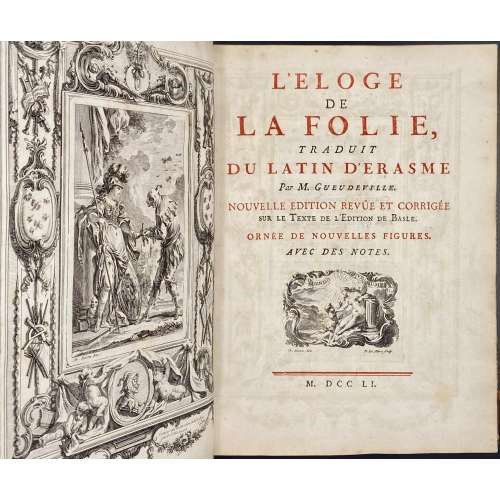 Title: L'ELOGE | DE | LA FOLIE, | TRADUIT | DU LATIN D'ERASME | Par M. Gueudeville. | NOUVELLE EDITION REVÛE & CORRIGÉE | sur le Texte de l'Edition de Basle. | ORNÉE DE NOUVELLES FIGURES. | AVEC DES NOTES. | {vignette Eisen / Le Mire} | — | M. DCC LI. || Pagination: [2 blank] [2] – h.t. / blank, [2] – t.p. / {citation*} | [4] – explication des figures; [i] ii-xxiv, [1] 2-222, [2] – table, [2 blank], plus frontispiece and 13 plates by various engravers after Charles Eisen, total number of pages 10+24+222+4=260, ils. Collation: 4to; [1 blank], π4 a-c4 A-Ee4 [1 blank], total number of leaves 130 plus frontispiece and 13 plates. Plates printed in black, paper 24 x 17.8 cm (grand papeir, 9.5 x 7 inches). Binding: Contemporary mottled calf, triple fillet gilt border with pomegranate corner pieces to boards, spine with raised bands, gilt foliage and pomegranates in compartments, red morocco spine label, all edges gilt, rebacked preserving the original spine and peacock marbled endpapers. Size: 24.8 x 18.8 cm; leaves 24 x 17.8 cm; text printed area: 10 x 6 cm. * Citattion: Admonere voluimus, non lædere: | Consulere moribus Hominum, | non officere. | Erasm. Epist. ad Mart. Dorpium Theolog. Usually, the citation is "Admonere voluimus, non mordere; prodesse, non laedere…", etc. Rococo-framed frontispiece engraved by Martinasie under the supervision of Le Bas. Contributors: Erasmus, Desiderius [Roterodamus] (Dutch, 1466 – 1536) – author. Gueudeville, Nicolas (French, 1652 – 1721) – translator. Meusnier de Querlon, Anne-Gabriel (French, 1702 – 1780) – notes. Eisen, Charles (French, 1720 – 1778) – artist. Engravers: Aliamet, Jacques (French, 1726 – 1788) Flipart, Charles Joseph (French, 1721 – 1797) Beauvais, Nicolas Dauphin de (French, 1687 – 1736) Pinssio [Pincio], Sébastien (French, 1721 – after 1744) Martenasie, Pierre François (French-Flemish, 1729 – 1789) Le Bas [Lebas], Jacques-Philippe (French, 1707 – 1783) Provenance: Bishop, Cortlandt Field (American, 1870 – 1935) – bookplate. Mary S. Collins – bookplate by J. H. Fincken. Robin F. Satinsky (American, 1919 – 2008) – Robin Collection bookplate. Catalogue raisonné: Cohen–deRichi 348-349; Lewine, p. 170; Ray (French) № 24, pp. 52-54.
Title: L'ELOGE | DE | LA FOLIE, | TRADUIT | DU LATIN D'ERASME | Par M. Gueudeville. | NOUVELLE EDITION REVÛE & CORRIGÉE | sur le Texte de l'Edition de Basle. | ORNÉE DE NOUVELLES FIGURES. | AVEC DES NOTES. | {vignette Eisen / Le Mire} | — | M. DCC LI. || Pagination: [2 blank] [2] – h.t. / blank, [2] – t.p. / {citation*} | [4] – explication des figures; [i] ii-xxiv, [1] 2-222, [2] – table, [2 blank], plus frontispiece and 13 plates by various engravers after Charles Eisen, total number of pages 10+24+222+4=260, ils. Collation: 4to; [1 blank], π4 a-c4 A-Ee4 [1 blank], total number of leaves 130 plus frontispiece and 13 plates. Plates printed in black, paper 24 x 17.8 cm (grand papeir, 9.5 x 7 inches). Binding: Contemporary mottled calf, triple fillet gilt border with pomegranate corner pieces to boards, spine with raised bands, gilt foliage and pomegranates in compartments, red morocco spine label, all edges gilt, rebacked preserving the original spine and peacock marbled endpapers. Size: 24.8 x 18.8 cm; leaves 24 x 17.8 cm; text printed area: 10 x 6 cm. * Citattion: Admonere voluimus, non lædere: | Consulere moribus Hominum, | non officere. | Erasm. Epist. ad Mart. Dorpium Theolog. Usually, the citation is "Admonere voluimus, non mordere; prodesse, non laedere…", etc. Rococo-framed frontispiece engraved by Martinasie under the supervision of Le Bas. Contributors: Erasmus, Desiderius [Roterodamus] (Dutch, 1466 – 1536) – author. Gueudeville, Nicolas (French, 1652 – 1721) – translator. Meusnier de Querlon, Anne-Gabriel (French, 1702 – 1780) – notes. Eisen, Charles (French, 1720 – 1778) – artist. Engravers: Aliamet, Jacques (French, 1726 – 1788) Flipart, Charles Joseph (French, 1721 – 1797) Beauvais, Nicolas Dauphin de (French, 1687 – 1736) Pinssio [Pincio], Sébastien (French, 1721 – after 1744) Martenasie, Pierre François (French-Flemish, 1729 – 1789) Le Bas [Lebas], Jacques-Philippe (French, 1707 – 1783) Provenance: Bishop, Cortlandt Field (American, 1870 – 1935) – bookplate. Mary S. Collins – bookplate by J. H. Fincken. Robin F. Satinsky (American, 1919 – 2008) – Robin Collection bookplate. Catalogue raisonné: Cohen–deRichi 348-349; Lewine, p. 170; Ray (French) № 24, pp. 52-54. -
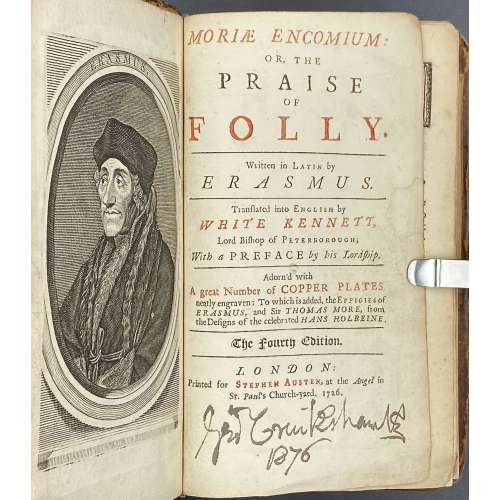 Erasmus. The praise of folly / Translated by White Kennett. — London: Stephen Austen, 1726. Title page in black and red: MORIÆ ENCOMIUM: | OR, THE | PRAISE | OF | FOLLY. |—| Written in Latin by | ERASMUS. |—| Translated into English by | WHITE KENNETT, | Lord Bishop of Peterborough; | With a PREFACE by his Lordship. |—| Adorn’d with | A great Number of COPPER PLATES | neatly engraven: To which is added, the Effigies of | ERASMUS, and Sir THOMAS MORE, from | theDesigns of the celebrated HANS HOLBEINE. |—| (in gothic letters) The Fourth Edition. |—| LONDON: | Printed for Stephen Austen, at the Angel in | St. Pauls’ Church-yard. 1726. || Pagination: modern endpapers and flyleaves, [2] – blank / frontis. (engraved portrait of Erasmus, [2] – t.p. in black and red with George Cruikshank’s signature in the bottom, dated 1876 / blank, [14] – to the reader, i-xiv – commendatory verses, [2] – John Wilford advert., folding portrait of Thomas More, i-v, [vi] - epistle, 1-168 – panegyrick, [4] – index.; 46 copper-engraved illustrations after Hans Holbein the Younger; pp. 17-20 detached. Collation: 12mo; π2 A6, a-b6, B-P6 Q2 (B3 unsigned), 13 in-text engravings + 26 plates + 7 folding plates; total 106 leaves and 33 plates, extraneous to collation. Edition: 4th, thus. Binding: 16.5 x 10.5 cm; rebacked with a modern spine, modern endpapers and flyleaves, contemporary boards sprinkled and tooled in a style of Cambridge panel. Provenance: Cruikshank, George (British, 1792 – 1878) [1876]; Stephen Whitehead (Oakland, CA) [2021]. Catalogue raisonné: J. Lewine (1898) p. 171 — 1st edition thus of 1709, in-8vo, with portrait and 46 plates after Holbein. Contributors: Desiderius Erasmus Roterodamus (Dutch, c. 1469 – 1536) – author of the original text in Latin.
Erasmus. The praise of folly / Translated by White Kennett. — London: Stephen Austen, 1726. Title page in black and red: MORIÆ ENCOMIUM: | OR, THE | PRAISE | OF | FOLLY. |—| Written in Latin by | ERASMUS. |—| Translated into English by | WHITE KENNETT, | Lord Bishop of Peterborough; | With a PREFACE by his Lordship. |—| Adorn’d with | A great Number of COPPER PLATES | neatly engraven: To which is added, the Effigies of | ERASMUS, and Sir THOMAS MORE, from | theDesigns of the celebrated HANS HOLBEINE. |—| (in gothic letters) The Fourth Edition. |—| LONDON: | Printed for Stephen Austen, at the Angel in | St. Pauls’ Church-yard. 1726. || Pagination: modern endpapers and flyleaves, [2] – blank / frontis. (engraved portrait of Erasmus, [2] – t.p. in black and red with George Cruikshank’s signature in the bottom, dated 1876 / blank, [14] – to the reader, i-xiv – commendatory verses, [2] – John Wilford advert., folding portrait of Thomas More, i-v, [vi] - epistle, 1-168 – panegyrick, [4] – index.; 46 copper-engraved illustrations after Hans Holbein the Younger; pp. 17-20 detached. Collation: 12mo; π2 A6, a-b6, B-P6 Q2 (B3 unsigned), 13 in-text engravings + 26 plates + 7 folding plates; total 106 leaves and 33 plates, extraneous to collation. Edition: 4th, thus. Binding: 16.5 x 10.5 cm; rebacked with a modern spine, modern endpapers and flyleaves, contemporary boards sprinkled and tooled in a style of Cambridge panel. Provenance: Cruikshank, George (British, 1792 – 1878) [1876]; Stephen Whitehead (Oakland, CA) [2021]. Catalogue raisonné: J. Lewine (1898) p. 171 — 1st edition thus of 1709, in-8vo, with portrait and 46 plates after Holbein. Contributors: Desiderius Erasmus Roterodamus (Dutch, c. 1469 – 1536) – author of the original text in Latin.White Kennett (British, 1660 – 1728) – translator from Latin into English.
Hans Holbein the Younger (German, 1497/8 – 1543) – artist.
Stephen Austen (fl. c. 1727 – 1746) – publisher. Linked items: Engraved portrait of Erasmus of Rotterdam in an octagonal frame, 1757 by Flipart after Holbein.Эразм Роттердамский. Похвальное слово глупости. — М.-Л.: Academia, 1932.
-
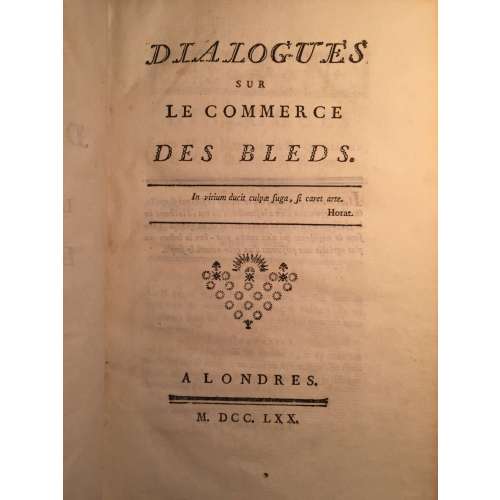
GALIANI, Ferdinando, Abbé. Dialogue sur le commerce des bleds. Londres, 1770. L'Abbé Roubaud, Pierre Joseph André. Récréations économiques ou lettres de l'auteur des représentations aux magistrats, a M. le chevalier Zanobi, principal interlocuteur des Dialogues sur le commerce des bleds; Amsterdam & Paris, Delalain, 1770. Béguillet, Edme. De principiis vegetationis et agreculturae et de causis triplicis culturae in Burgundia disquisitio physica. Auctore E.B.D. ex Societate Œconomica Lugdunensi; Divione, 1768.
-
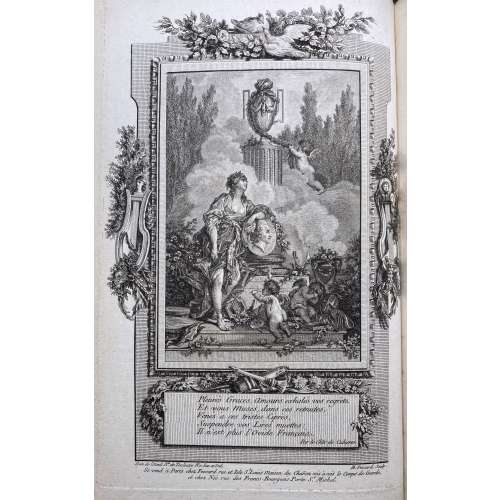 Title page: LES | BAISERS , | PRÉCÉDES | DU MOIS DE MAI, | POËME. | [vignette] | A LA HAYE , | Et se trouve à Paris | Chez Lambert , Imprimeur, rue de la Harpe. | Et Delalain , rue de la Comédie Françoise. | M. DCC. LXX Size: 8vo; 24.5 x 15.5 cm; Binding by Hippolyte Duru – stamp at the back of the front end paper DURU, 1855; full red calf, boards decorated in gilt, raised bands and gilt decorations in compartments, gilt lettering, AEG, peacock marbled end papers, text and illustrations printed on Holland paper. Collation: 2 ffls, engraved half-title by N. Ponce after Ch. Eisen, frontispiece by Etienne Fessard after Claude-Jean-Baptiste Hoin (French, 1750 – 1817) w/guard tissue, t.p. by J. Aliamet after Ch. Eisen, Réflexions préliminaires: A8, B4; 'Le Mois de Mai' half-title, imprim. note on verso, frontispice by De Longueil after Ch. Eisen w/guard tissue, A4 C-F(8) H4; 2bfls. Frontispiece by Etienne Fessard is unique in this edition. Pagination: [2] 3-24, [27]/28, 5/6, 31/32 31/34 11/12 37-119 [120], 22 head-pieces after Ch. Eisen and 22 end-pieces after Marillier, engraved by Baquoy, Binet, Delaunay, Lingée, De Longueil, Masquelier, Massard, and Née. Mistakes in pagination likely confirms first printing first edition. Catalogue raisonné: Cohen, De Ricci (1912): 308-311). Artists: Charles Eisen (French, 1720–1778); Clément Pierre Marillier (French, 1740–1808), and Claude-Jean-Baptiste Hoin (French, 1750–1817). Engravers: Jacques Aliamet (French, 1726–1788); Jean Charles Baquoy (French, 1721–1777); Louis Binet (French, 1744–about 1800); Nicolas Delaunay (French, 1739–1792); Etienne Fessard (French, 1714–1777); Charles Louis Lingée (French, 1748–1819); Joseph de Longueil (French, 1730–1792); Louis Joseph Masquelier (French, 1741–1811); Jean Massard (1740–1822); François Denis Née (French, 1735–1818); Nicholas Ponce (French, 1746–1831).
Title page: LES | BAISERS , | PRÉCÉDES | DU MOIS DE MAI, | POËME. | [vignette] | A LA HAYE , | Et se trouve à Paris | Chez Lambert , Imprimeur, rue de la Harpe. | Et Delalain , rue de la Comédie Françoise. | M. DCC. LXX Size: 8vo; 24.5 x 15.5 cm; Binding by Hippolyte Duru – stamp at the back of the front end paper DURU, 1855; full red calf, boards decorated in gilt, raised bands and gilt decorations in compartments, gilt lettering, AEG, peacock marbled end papers, text and illustrations printed on Holland paper. Collation: 2 ffls, engraved half-title by N. Ponce after Ch. Eisen, frontispiece by Etienne Fessard after Claude-Jean-Baptiste Hoin (French, 1750 – 1817) w/guard tissue, t.p. by J. Aliamet after Ch. Eisen, Réflexions préliminaires: A8, B4; 'Le Mois de Mai' half-title, imprim. note on verso, frontispice by De Longueil after Ch. Eisen w/guard tissue, A4 C-F(8) H4; 2bfls. Frontispiece by Etienne Fessard is unique in this edition. Pagination: [2] 3-24, [27]/28, 5/6, 31/32 31/34 11/12 37-119 [120], 22 head-pieces after Ch. Eisen and 22 end-pieces after Marillier, engraved by Baquoy, Binet, Delaunay, Lingée, De Longueil, Masquelier, Massard, and Née. Mistakes in pagination likely confirms first printing first edition. Catalogue raisonné: Cohen, De Ricci (1912): 308-311). Artists: Charles Eisen (French, 1720–1778); Clément Pierre Marillier (French, 1740–1808), and Claude-Jean-Baptiste Hoin (French, 1750–1817). Engravers: Jacques Aliamet (French, 1726–1788); Jean Charles Baquoy (French, 1721–1777); Louis Binet (French, 1744–about 1800); Nicolas Delaunay (French, 1739–1792); Etienne Fessard (French, 1714–1777); Charles Louis Lingée (French, 1748–1819); Joseph de Longueil (French, 1730–1792); Louis Joseph Masquelier (French, 1741–1811); Jean Massard (1740–1822); François Denis Née (French, 1735–1818); Nicholas Ponce (French, 1746–1831). -
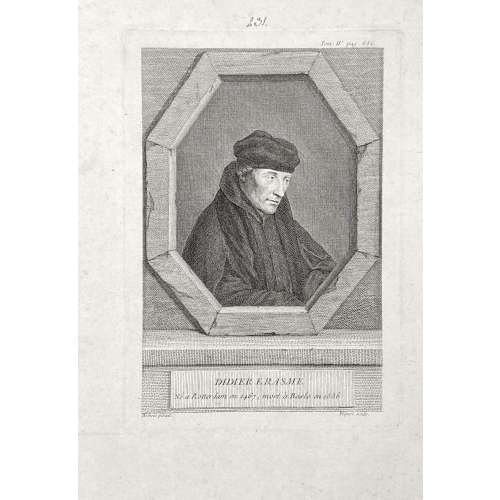 The portrait of Erasmus of Rotterdam (1466 – 1536), half-length, head to the right, body facing right, looking away, in a trompe-l'oeil octagonal frame. Inscriptions: Top right: Tom IV, pag. 686. Center of the image: DIDIER ERASME / Ne a Rotterdam en 1467, mort a Basle en 1536. Bottom of the plate: Holbein pinxit | Flipart Sculp. From the book Histoire générale des Provinces-Unies by Bénigne Dujardin (French, 1689 – 1771?) and Gottfried Sellius (real name Gottfried Sell) (1704? – 1767), published in 1757 in Paris by P. G. Simon. Volume 4, facing p. 686. Size: Sheet: 25 x 17.5 cm; Plate: 19.5 x 13.5 cm; Image: 18 x 12 cm. References: (1) Van Someren v.2, p.249, №1688; (2) https://archive.org/details/histoiregnra04duja/page/n714/mode/2up. Inscription above the plate: nut ink, hand, "231".
The portrait of Erasmus of Rotterdam (1466 – 1536), half-length, head to the right, body facing right, looking away, in a trompe-l'oeil octagonal frame. Inscriptions: Top right: Tom IV, pag. 686. Center of the image: DIDIER ERASME / Ne a Rotterdam en 1467, mort a Basle en 1536. Bottom of the plate: Holbein pinxit | Flipart Sculp. From the book Histoire générale des Provinces-Unies by Bénigne Dujardin (French, 1689 – 1771?) and Gottfried Sellius (real name Gottfried Sell) (1704? – 1767), published in 1757 in Paris by P. G. Simon. Volume 4, facing p. 686. Size: Sheet: 25 x 17.5 cm; Plate: 19.5 x 13.5 cm; Image: 18 x 12 cm. References: (1) Van Someren v.2, p.249, №1688; (2) https://archive.org/details/histoiregnra04duja/page/n714/mode/2up. Inscription above the plate: nut ink, hand, "231". -
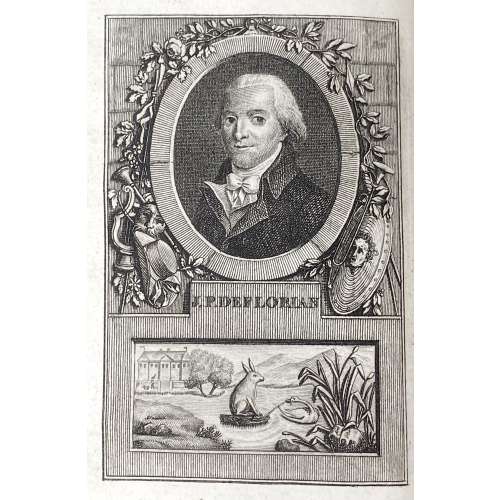 Title: FABLES | DE | M. DE FLORIAN , | de l’académie françoise, de celles de Madrid , | Florence, etc. | — | Je tâche d'y tourner le vice ridicule , | Ne pouvant l'attaquer avec des bras d'Hercule. | La Font. Fables , liv. V , I. — | [publisher's device ] | A PARIS, | DE L'IMPRIMERIE DE P. DIDOT L'AINÉ, | 1792. Pagination: ffl, [2 - h.t. / Imp.] [2 - blank / frontis.] [2 - tp. / blank] [5] 6-224 [2 - advert. / blank], bfl. Collation: numbered 1(5), 2-18(6), 19(3); engarved frontispiece portrait of Florian after François Hüet-Villiers, 5 engraved plates by Longueil, Delignon, and Gaucher after Flouest. Binding: Contemporary full mottled calf, all margins red, gilt floral ornaments to flat spine, red label with gilt lettering. Catalogue raisonné: Cohen, de Ricci 1912: p. 398-9.
Title: FABLES | DE | M. DE FLORIAN , | de l’académie françoise, de celles de Madrid , | Florence, etc. | — | Je tâche d'y tourner le vice ridicule , | Ne pouvant l'attaquer avec des bras d'Hercule. | La Font. Fables , liv. V , I. — | [publisher's device ] | A PARIS, | DE L'IMPRIMERIE DE P. DIDOT L'AINÉ, | 1792. Pagination: ffl, [2 - h.t. / Imp.] [2 - blank / frontis.] [2 - tp. / blank] [5] 6-224 [2 - advert. / blank], bfl. Collation: numbered 1(5), 2-18(6), 19(3); engarved frontispiece portrait of Florian after François Hüet-Villiers, 5 engraved plates by Longueil, Delignon, and Gaucher after Flouest. Binding: Contemporary full mottled calf, all margins red, gilt floral ornaments to flat spine, red label with gilt lettering. Catalogue raisonné: Cohen, de Ricci 1912: p. 398-9. -
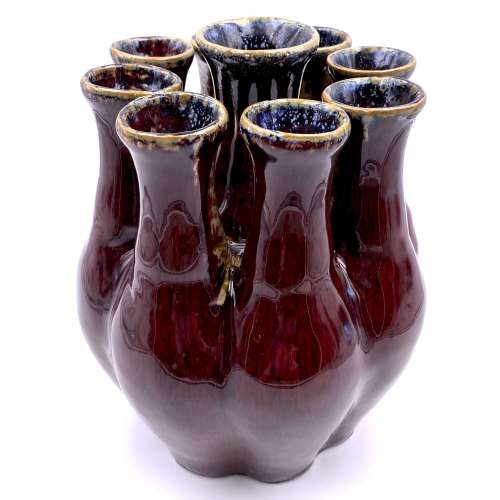 Porcelaneous stoneware vase glazed in purple-red with blue and beige splashes outside and dark blue inside, with one tube in the centre surrounded with eight peripheral tubes. Base unglazed. China, the Qianlong period (1711 – 1799) of the Qing Dynasty (1644 – 1912). Diameter: 19 cm; Height: 24 cm.
Porcelaneous stoneware vase glazed in purple-red with blue and beige splashes outside and dark blue inside, with one tube in the centre surrounded with eight peripheral tubes. Base unglazed. China, the Qianlong period (1711 – 1799) of the Qing Dynasty (1644 – 1912). Diameter: 19 cm; Height: 24 cm. -
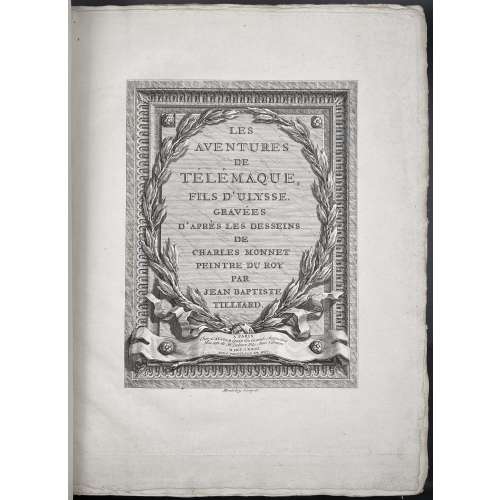 Vol. 1: Title page: LES AVENTURES | DE | TÉLÉMAQUE, | PAR FÉNELON. — | TOME PREMIER. | {publisher’s arms by Beugnet after Choffard} | DE L'IMPRIMERIE DE MONSIEUR. | M. DCC. LXXXV. || Title-frontispiece (engraved by Montulay): lettering within garland: Les Aventures de Télémaque, FILS D’ULYSSE. GRAVÉES | D’APRÈS LES DESSEINS | DE | CHARLES MONNET | PEINTRE DU ROY | PAR | JEAN BAPTISTE | TILLIARD. ||; Lettering on ribbon beneath the garland: A PARIS | Chez L’AUTEUR Quay des Grands Augustins | Maison de Mr. Debure Fils Aîné Libraire. M. DCC. LXXIII. | AVEC PRIVILEGE DU ROY. ||; Signed under the frame: Montulay Sculpsit. || Pagination: [2] – h.t. / imprint, [2] – t.p. / blank, [2] Advert., [2] d.t.p. / sommaire, [1] 2-309 [3 blanks], total 320 pages on thick wove paper plus engraved title-frontis. by Montulay, 12 engraved text leaves (one for each book), unsigned, and 36 plates (all in ornamental frame of laurel ribbon) by Tilliard after Monnet, all engravings on laid paper. Collation: 4to; vergé flyleaves at front and back, π4 A-2P4 plus 4 additional divisional titles in choirs C, F, I, and M for books 2-5, total 160 leaves, plus 49 plates. Vol. 2: Title page: Same but “TOME SECOND”. Pagination: [2] – h.t. / imprint, [2] – t.p. / blank, [1-3] 4-297 [298 blank] [2] – approb., total 304 pages plus 12 engraved text leaves (one for each book), and 36 plates, last 6 plates in a simple frame without the laurel ribbon and before signatures. Collation: 4to; π2 A-2O4 2P1 χ1, total 152 leaves, plus 48 plates. Binding: Two volumes uniformly bound in green paper boards with two red labels lettered in gilt, untrimmed. Size: overall 36.5 x 28 cm, platemark 32 x 25 cm, with white vergé flyleaves to front and back, similar pastedowns. Catalogue raisonné: Cohen, de Ricci (1912): 384-386; Ray (French): № 37, p. 74; Lewine (1898): p. 181. Contributors: François Fénelon [François de Salignac de la Mothe-Fénelon] (French, 1651 – 1715) – author. Choffard, Pierre Philippe (French, 1730 – 1809) – artist. Monnet, Charles (French, 1732 – after 1808) – artist. Montulay (French, fl. c. 1773) – engraver. Tilliard, Jean Baptiste (French, 1740 – 1813) – engraver. Beugnet, Jean (French, c. 1803) – engraver. Didot, Pierre-François (French, 1731 – 1795) – printer. Barrois, Louis-François (French, 1748 – 1835?); Barrois, Pierre-Théophile (French, 1752 – 1836); Onfroy, Eugène (French, before 1765 – 1809) ; Delalain, Louis-Alexandre (French, 1749? – 1798) – booksellers.
Vol. 1: Title page: LES AVENTURES | DE | TÉLÉMAQUE, | PAR FÉNELON. — | TOME PREMIER. | {publisher’s arms by Beugnet after Choffard} | DE L'IMPRIMERIE DE MONSIEUR. | M. DCC. LXXXV. || Title-frontispiece (engraved by Montulay): lettering within garland: Les Aventures de Télémaque, FILS D’ULYSSE. GRAVÉES | D’APRÈS LES DESSEINS | DE | CHARLES MONNET | PEINTRE DU ROY | PAR | JEAN BAPTISTE | TILLIARD. ||; Lettering on ribbon beneath the garland: A PARIS | Chez L’AUTEUR Quay des Grands Augustins | Maison de Mr. Debure Fils Aîné Libraire. M. DCC. LXXIII. | AVEC PRIVILEGE DU ROY. ||; Signed under the frame: Montulay Sculpsit. || Pagination: [2] – h.t. / imprint, [2] – t.p. / blank, [2] Advert., [2] d.t.p. / sommaire, [1] 2-309 [3 blanks], total 320 pages on thick wove paper plus engraved title-frontis. by Montulay, 12 engraved text leaves (one for each book), unsigned, and 36 plates (all in ornamental frame of laurel ribbon) by Tilliard after Monnet, all engravings on laid paper. Collation: 4to; vergé flyleaves at front and back, π4 A-2P4 plus 4 additional divisional titles in choirs C, F, I, and M for books 2-5, total 160 leaves, plus 49 plates. Vol. 2: Title page: Same but “TOME SECOND”. Pagination: [2] – h.t. / imprint, [2] – t.p. / blank, [1-3] 4-297 [298 blank] [2] – approb., total 304 pages plus 12 engraved text leaves (one for each book), and 36 plates, last 6 plates in a simple frame without the laurel ribbon and before signatures. Collation: 4to; π2 A-2O4 2P1 χ1, total 152 leaves, plus 48 plates. Binding: Two volumes uniformly bound in green paper boards with two red labels lettered in gilt, untrimmed. Size: overall 36.5 x 28 cm, platemark 32 x 25 cm, with white vergé flyleaves to front and back, similar pastedowns. Catalogue raisonné: Cohen, de Ricci (1912): 384-386; Ray (French): № 37, p. 74; Lewine (1898): p. 181. Contributors: François Fénelon [François de Salignac de la Mothe-Fénelon] (French, 1651 – 1715) – author. Choffard, Pierre Philippe (French, 1730 – 1809) – artist. Monnet, Charles (French, 1732 – after 1808) – artist. Montulay (French, fl. c. 1773) – engraver. Tilliard, Jean Baptiste (French, 1740 – 1813) – engraver. Beugnet, Jean (French, c. 1803) – engraver. Didot, Pierre-François (French, 1731 – 1795) – printer. Barrois, Louis-François (French, 1748 – 1835?); Barrois, Pierre-Théophile (French, 1752 – 1836); Onfroy, Eugène (French, before 1765 – 1809) ; Delalain, Louis-Alexandre (French, 1749? – 1798) – booksellers. -
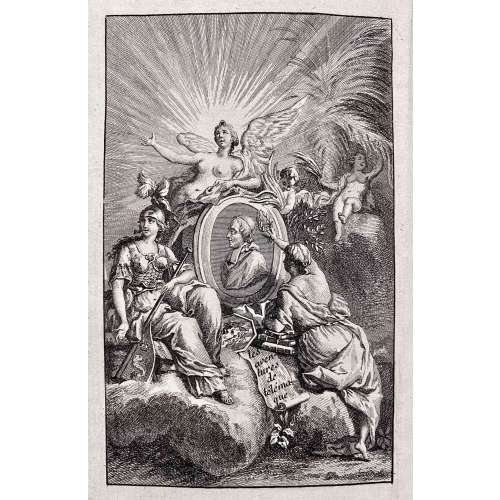 Les Aventures de Télémaque, fils d'Ulysse, Par feu Messire François de Salignac de la Mothe-Fénelon, Précepteur de Messeigneurs les Enfants de France, & depuis Archevêque - Duc de Chabray, Prince du Saint-Empire Romain, &c. / Nouvelle édition enrichie de figures en taille-douce. – À Maestricht, Chez J. E. Dufour & Ph. Roux, Imprimeurs-Libraires associés. M. DCC. LXXXII. Pagination: ffl, [i, ii - ht, explication] [2 - blank, frontis. portrait] [iii, iv - t.p., blank] [v - discours] vi-xxviii, [1] 2-484, bfl; 1 folding map and 24 plates engraved by Jean-Baptiste-Pierre Tardieu. Size: 8vo, 21 x 13 cm. Binding: full contemporary mottled calf, marbled end-papers, all margins red, raised bands, floral gilt elements in compartments, red title label, head- and tail-band absent. Point of issue: the vignette in Liv. 1 is upsidedown. Liv. 1 & 8 plates signed: Gravé par Tardieu résident à Malines. Jean Baptiste Pierre Tardieu (French, 1746 – 1816) - engraver and cartographer from a large family of artists and engravers. For English translation of this book see № LIB-2683-2021 in this collection.
Les Aventures de Télémaque, fils d'Ulysse, Par feu Messire François de Salignac de la Mothe-Fénelon, Précepteur de Messeigneurs les Enfants de France, & depuis Archevêque - Duc de Chabray, Prince du Saint-Empire Romain, &c. / Nouvelle édition enrichie de figures en taille-douce. – À Maestricht, Chez J. E. Dufour & Ph. Roux, Imprimeurs-Libraires associés. M. DCC. LXXXII. Pagination: ffl, [i, ii - ht, explication] [2 - blank, frontis. portrait] [iii, iv - t.p., blank] [v - discours] vi-xxviii, [1] 2-484, bfl; 1 folding map and 24 plates engraved by Jean-Baptiste-Pierre Tardieu. Size: 8vo, 21 x 13 cm. Binding: full contemporary mottled calf, marbled end-papers, all margins red, raised bands, floral gilt elements in compartments, red title label, head- and tail-band absent. Point of issue: the vignette in Liv. 1 is upsidedown. Liv. 1 & 8 plates signed: Gravé par Tardieu résident à Malines. Jean Baptiste Pierre Tardieu (French, 1746 – 1816) - engraver and cartographer from a large family of artists and engravers. For English translation of this book see № LIB-2683-2021 in this collection. -
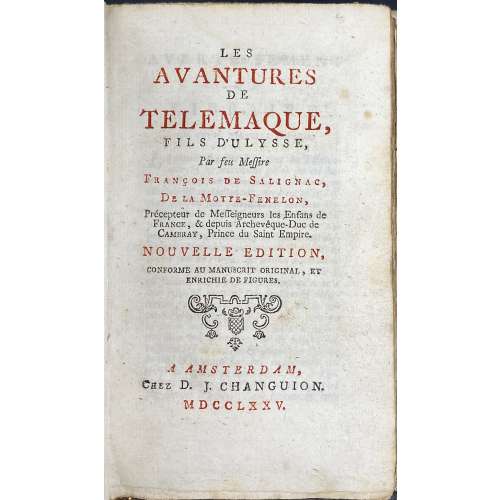 Title-page (in red and black, with tall “s”): LES | AVANTURES | DE | TELEMAQUE, | FILS D'ULYSSE, | Par seu Messire | François de Salignac, | De La Motte-Fenelon, | Precepteur de Messeigneurs les Enfans de | France, & depuis Archevêque-Duc de | Cambray, Prince du Saint Empire. | NOUVELLE EDITION, | CONFORME AU MANUSCRIT ORIGINAL, ET | ENRICHIE DE FIGURES. | {device} | A AMSTERDAM, | Chez D. J. CHANGUION. | MDCCXXV. || Pagination: fep, 1 bank leaves, frontis., [ii] title, [iii] iv-cvi, [1] 2-490 2 blank leaves, fep, total 496 pages. Collation: 12mo; 1*-4*12 5*5, A-V12 X8 (total 248 leaves) plus frontispiece and 9 plates designed and engraved by Simon Fokke (signed: “S. Fokke in et fec 1753”), and folding map (not signed). Binding: Red quarter roan over contemporary marbled vellum, only top margin trimmed. Edition: 2nd edition with these etchings after the 1st by Jan Daniel Beman in Rotterdam in 1755 (see British Museum 1887,0722.88 and 1887,0722.90 and others.) Catalogue raisonné: Not in Cohen-DeRicci, not in Lewine. Contributors: François Fénelon [François de Salignac de la Mothe-Fénelon] (French, 1651 – 1715) – author. Simon Fokke (Dutch, 1712 – 1784) – artist, engarver.
Title-page (in red and black, with tall “s”): LES | AVANTURES | DE | TELEMAQUE, | FILS D'ULYSSE, | Par seu Messire | François de Salignac, | De La Motte-Fenelon, | Precepteur de Messeigneurs les Enfans de | France, & depuis Archevêque-Duc de | Cambray, Prince du Saint Empire. | NOUVELLE EDITION, | CONFORME AU MANUSCRIT ORIGINAL, ET | ENRICHIE DE FIGURES. | {device} | A AMSTERDAM, | Chez D. J. CHANGUION. | MDCCXXV. || Pagination: fep, 1 bank leaves, frontis., [ii] title, [iii] iv-cvi, [1] 2-490 2 blank leaves, fep, total 496 pages. Collation: 12mo; 1*-4*12 5*5, A-V12 X8 (total 248 leaves) plus frontispiece and 9 plates designed and engraved by Simon Fokke (signed: “S. Fokke in et fec 1753”), and folding map (not signed). Binding: Red quarter roan over contemporary marbled vellum, only top margin trimmed. Edition: 2nd edition with these etchings after the 1st by Jan Daniel Beman in Rotterdam in 1755 (see British Museum 1887,0722.88 and 1887,0722.90 and others.) Catalogue raisonné: Not in Cohen-DeRicci, not in Lewine. Contributors: François Fénelon [François de Salignac de la Mothe-Fénelon] (French, 1651 – 1715) – author. Simon Fokke (Dutch, 1712 – 1784) – artist, engarver. -
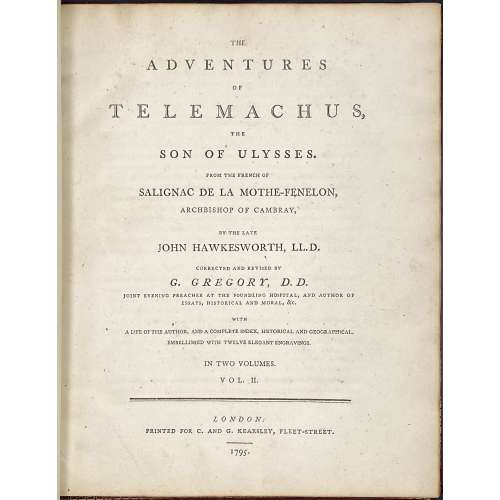 Title page: THE | ADVENTURES | OF | TELEMACHUS, | THE | SON OF ULYSSES. | FROM THE FRENCH OF | SALIGNAC DE LA MOTHE–FENELON, | ARCHBISHOP OF CAMBRAY. | BY THE LATE | JOHN HAWKESWORTH, LL. D. | CORRECTED AND REVISED BY | G. GREGORY, D. D. | JOINT EVENING PREACHER AT THE FOUNDLING HOSPITAL, AND AUTHOR OF | ESSAYS, HISTORICAL AND MORAL, &C. | WITH | A LIFE OF THE AUTHOR, AND A COMPLETE INDEX, HISTORICAL AND GEOGRAPHICAL. | EMBELLISHED WITH TWELVE ELEGANT ENGRAVINGS. | IN TWO VOLUMES. | VOL. I. [VOL. II] | — | LONDON: | PRINTED FOR C. AND G. KEARSLEY, FLEET-STREET. | 1795. || Vol. 1: collation: 2 blank leaves, π6, a-d4, B-Z4 Aa-Ff4, 2 blank leaves, 7 coloured engravings; pagination: [i-v] vi-xxxv [xxxvi], [1] 2-223 [224 blank]. Vol. 2: collation: 2 blank leaves, π4, Gg-Zz4, 3A-3K4 [a]4 b2, 2 blank leaves, 5 coloured engravings; pagination: [i-iii] iv-vii [viii], [225] 226-439, [440-452]. Exterior: 2-volume set, uniformly bound in full crimson linen morocco, key fret inside, gilt-ruled with a floral pattern between fillets to boards, flat spine decorated in gilt, with gilt lettering, marbled endpapers, AEG, 4to, 28 x 22.5 cm; printed on wove paper with watermark “WS”. Blind stamp to ffl by previous owner: "B. J. WIJNVELDT". Engravings: 12 tinted stipple engravings à la poupée: one by James Neagle (British, 1760? – 1822), four by William Bromley (British, 1769 – 1842), four by William Skelton (British, 1763 – 1848), one by John Ogborne (British, 1755 – 1837), and two by James Parker (1750 – 1805) after Thomas Stothard (British, 1755 – 1834). Ref.: Lewine (1898), p. 183: "The 1795 edition, 2 vols., 4to., with 12 engravings after Stothard, has a nominal value." Not in Cohen De Ricci, 1912. Original: François Fénelon. Les Aventures de Télémaque, fils d’Ulysse. See №№ LIB-2522-2020 and LIB-2683.2021 in this collection. John Hawkesworth (British, c. 1715 – 1773). George Gregory (British, 1754 – 1808).
Title page: THE | ADVENTURES | OF | TELEMACHUS, | THE | SON OF ULYSSES. | FROM THE FRENCH OF | SALIGNAC DE LA MOTHE–FENELON, | ARCHBISHOP OF CAMBRAY. | BY THE LATE | JOHN HAWKESWORTH, LL. D. | CORRECTED AND REVISED BY | G. GREGORY, D. D. | JOINT EVENING PREACHER AT THE FOUNDLING HOSPITAL, AND AUTHOR OF | ESSAYS, HISTORICAL AND MORAL, &C. | WITH | A LIFE OF THE AUTHOR, AND A COMPLETE INDEX, HISTORICAL AND GEOGRAPHICAL. | EMBELLISHED WITH TWELVE ELEGANT ENGRAVINGS. | IN TWO VOLUMES. | VOL. I. [VOL. II] | — | LONDON: | PRINTED FOR C. AND G. KEARSLEY, FLEET-STREET. | 1795. || Vol. 1: collation: 2 blank leaves, π6, a-d4, B-Z4 Aa-Ff4, 2 blank leaves, 7 coloured engravings; pagination: [i-v] vi-xxxv [xxxvi], [1] 2-223 [224 blank]. Vol. 2: collation: 2 blank leaves, π4, Gg-Zz4, 3A-3K4 [a]4 b2, 2 blank leaves, 5 coloured engravings; pagination: [i-iii] iv-vii [viii], [225] 226-439, [440-452]. Exterior: 2-volume set, uniformly bound in full crimson linen morocco, key fret inside, gilt-ruled with a floral pattern between fillets to boards, flat spine decorated in gilt, with gilt lettering, marbled endpapers, AEG, 4to, 28 x 22.5 cm; printed on wove paper with watermark “WS”. Blind stamp to ffl by previous owner: "B. J. WIJNVELDT". Engravings: 12 tinted stipple engravings à la poupée: one by James Neagle (British, 1760? – 1822), four by William Bromley (British, 1769 – 1842), four by William Skelton (British, 1763 – 1848), one by John Ogborne (British, 1755 – 1837), and two by James Parker (1750 – 1805) after Thomas Stothard (British, 1755 – 1834). Ref.: Lewine (1898), p. 183: "The 1795 edition, 2 vols., 4to., with 12 engravings after Stothard, has a nominal value." Not in Cohen De Ricci, 1912. Original: François Fénelon. Les Aventures de Télémaque, fils d’Ulysse. See №№ LIB-2522-2020 and LIB-2683.2021 in this collection. John Hawkesworth (British, c. 1715 – 1773). George Gregory (British, 1754 – 1808).George Kearsley the elder (British, 1739 – 1790) (Kearsley, Catharine and George – publishers)
-
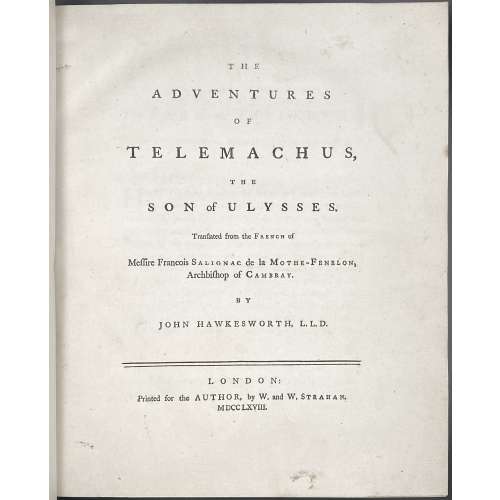 THE | ADVENTURES | OF | TELEMACHUS, | THE SON OF ULYSSES. | Translated from the French of | Messire François Salignac de la Mothe–Fenelon, | Archbishop of Cambray. | BY | JOHN HAWKESWORTH, L. L. D. | — | LONDON: | Printed for the AUTHOR, by W. and W. Strahan, | M DCC LXVIII. || Binding: half polished brown calf over marbled boards, wave ruled blind, gilt fillet ruled compartments, black label with gilt lettering to spine; 29.5 x 24.5 cm; marbled endpapers. Pagination: 2 blank leaves (wove paper), [I, ii] – t.p. / blank, [iii] iv – dedication, [v] vi-xv – subscribers, [xvi] blank, [xvii] xviii-xix – preface, [xx] xxi-xxxv – contents, [xxxvi] – errata, subscribers omitted, [1] 2-462, printed on laid paper, 2 blank leaves (wove paper). Collation: 4to; A4, a-c4 d2, B-Z4 Aa-Zz4 Aaa-Mmm4 Nnn3; 24 head- and 24 tailpieces engraved by Charles Grignion the Elder (British, 1721 – 1810) after Samuel Waly (British, 1720 – 1786). Original: François Fénelon. Les Aventures de Télémaque, fils d’Ulysse. See № LIB-2522-2020 in this collection. Not in Lewine, 1898; Not in Cohen De Ricci, 1912.
THE | ADVENTURES | OF | TELEMACHUS, | THE SON OF ULYSSES. | Translated from the French of | Messire François Salignac de la Mothe–Fenelon, | Archbishop of Cambray. | BY | JOHN HAWKESWORTH, L. L. D. | — | LONDON: | Printed for the AUTHOR, by W. and W. Strahan, | M DCC LXVIII. || Binding: half polished brown calf over marbled boards, wave ruled blind, gilt fillet ruled compartments, black label with gilt lettering to spine; 29.5 x 24.5 cm; marbled endpapers. Pagination: 2 blank leaves (wove paper), [I, ii] – t.p. / blank, [iii] iv – dedication, [v] vi-xv – subscribers, [xvi] blank, [xvii] xviii-xix – preface, [xx] xxi-xxxv – contents, [xxxvi] – errata, subscribers omitted, [1] 2-462, printed on laid paper, 2 blank leaves (wove paper). Collation: 4to; A4, a-c4 d2, B-Z4 Aa-Zz4 Aaa-Mmm4 Nnn3; 24 head- and 24 tailpieces engraved by Charles Grignion the Elder (British, 1721 – 1810) after Samuel Waly (British, 1720 – 1786). Original: François Fénelon. Les Aventures de Télémaque, fils d’Ulysse. See № LIB-2522-2020 in this collection. Not in Lewine, 1898; Not in Cohen De Ricci, 1912. -
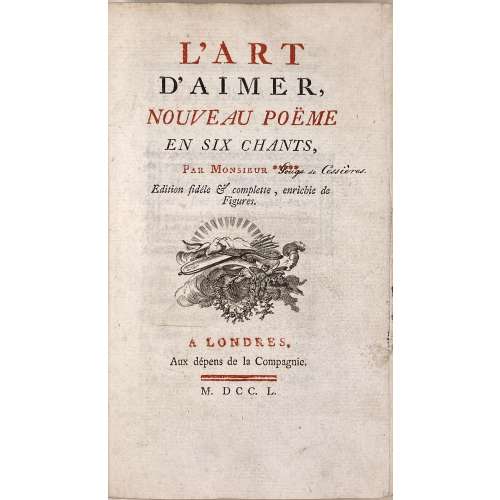 Description: 19th-century binding, 8vo,18.9 x 11.7 cm, in patterned quarter green shagreen over marbled boards, gilt elements and lettering to spine (reliure romantique), printed on laid paper, with tall "s", margins sprinkled blue. Title-page (red and black): L'ART | D'AIMER, | NOUVEAU POËME | EN SIX CHANTS, | Par Monsieur ***** Gouge de Cessières. | Edition fidéle & complette, enrichie de | Figures. | {vignette} | A LONDRES. | Aux dépens de la Compagnie. | = | M. DCC. L. || Includes: La Mort de Zulnï (pp. 175-190 ), Idée de l'Art d'aimer d'Ovide (pp. 191-244), and Lettre écrite à Monsieur *** de ******de l'Académie... (pp. 245-261). Collation: 8vo; a-b8, A-Q8 R3, lacking K2 (pp. 147/8); total 146 leaves (of 147) plus 8 engraved plates, unsigned, incl. frontispiece. Pagination: [i, ii] iii-xxxii, [1, 2] 3-261 [262 blank], lacking pp. 147/8 (K2), possibly containing Argument du chant VI; total 292 pages (of 294), ils. Catalogue raisonné: Cohen-DeRicci (under Ovid) 775, Lewine (under Ovid) 398. The artist and engravers of this edition are unknown. "Another edition, Londres (Paris), 1760, with frontispiece after Eisen by Martinet, and 6 plates after Martinet". Contributors: François-Étienne Gouge de Cessières (French, 1724 – 1782) – author. Ovid [Publius Ovidius Naso] (Roman, 43 B.C. – A.D. 17) – author. Aux dépens de la Compagnie (1685 – 1780) (Amsterdam) – publisher.
Description: 19th-century binding, 8vo,18.9 x 11.7 cm, in patterned quarter green shagreen over marbled boards, gilt elements and lettering to spine (reliure romantique), printed on laid paper, with tall "s", margins sprinkled blue. Title-page (red and black): L'ART | D'AIMER, | NOUVEAU POËME | EN SIX CHANTS, | Par Monsieur ***** Gouge de Cessières. | Edition fidéle & complette, enrichie de | Figures. | {vignette} | A LONDRES. | Aux dépens de la Compagnie. | = | M. DCC. L. || Includes: La Mort de Zulnï (pp. 175-190 ), Idée de l'Art d'aimer d'Ovide (pp. 191-244), and Lettre écrite à Monsieur *** de ******de l'Académie... (pp. 245-261). Collation: 8vo; a-b8, A-Q8 R3, lacking K2 (pp. 147/8); total 146 leaves (of 147) plus 8 engraved plates, unsigned, incl. frontispiece. Pagination: [i, ii] iii-xxxii, [1, 2] 3-261 [262 blank], lacking pp. 147/8 (K2), possibly containing Argument du chant VI; total 292 pages (of 294), ils. Catalogue raisonné: Cohen-DeRicci (under Ovid) 775, Lewine (under Ovid) 398. The artist and engravers of this edition are unknown. "Another edition, Londres (Paris), 1760, with frontispiece after Eisen by Martinet, and 6 plates after Martinet". Contributors: François-Étienne Gouge de Cessières (French, 1724 – 1782) – author. Ovid [Publius Ovidius Naso] (Roman, 43 B.C. – A.D. 17) – author. Aux dépens de la Compagnie (1685 – 1780) (Amsterdam) – publisher. -
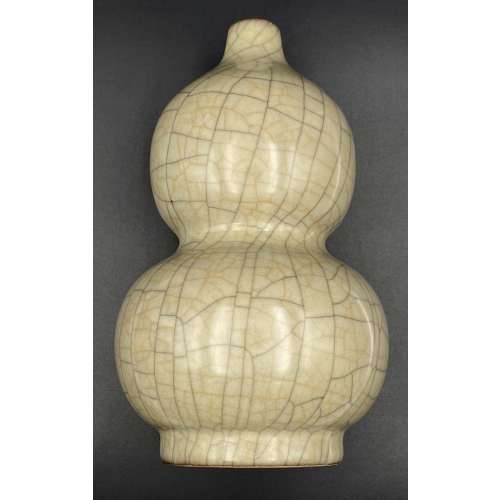 A footed double-gourd porcelain bottle with iron and gold coloured crackle on grey background. China, the Qianlong period (1711 – 1799) of the Qing Dynasty (1644 – 1912). Diameter: 12 cm; Height: 21 cm.
A footed double-gourd porcelain bottle with iron and gold coloured crackle on grey background. China, the Qianlong period (1711 – 1799) of the Qing Dynasty (1644 – 1912). Diameter: 12 cm; Height: 21 cm. -
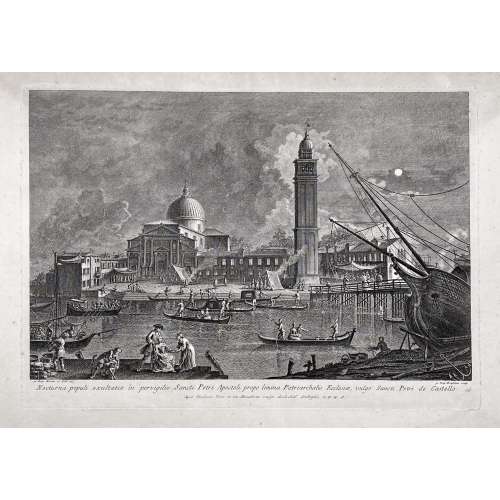
From the series of prints 'Prospectum Ædium Viarumque Insigniorum Urbis Venetiarum'. Inscribed below image left: "Jo. Bap. Moretti et Filii del. e Pinx."; right: "Jo. Baptista Brustoloni sculp."; in lower margin centre: "Nocturna populi exultatio in pervigilio Sancti Petri Apostoli prope limina Patriarchalis Ecclesiæ, vulgò Sancti Petri de Castello. / Apud Ludovicum Furlanetto supra Pontem vulgo dictum dei Baretteri C.P.E.S.". The third state, published by Teodoro Viero; the numbering on plate lower right, next to the inscription in Latin is cancelled as indicated by bibliography.
The subject is taken from a drawing by Giovanni Battista Moretti (Italian, active Venice, 1748-75) which in turn derives from a Canaletto painting. The print comes from the most important of Brustolon’s series, Prospectuum Aedium Viarumque Insignorum Urbis Venetiarum, dedicated to the Doge Marco Foscarini, from drawings by Canaletto, Moretti and sons and others, published for the first time by Ludovico Furlanetto in 1763 and later by Teodoro Viero. Giambattista Brustolon (1712–1796) was a famous Venetian engraver, a pupil of Joseph Wagner; whose talent is best displayed in his famous nocturnals: ‘riesce a dare il meglio di sé … nei famosi notturni’ (Succi).
Plate: 324 × 458 mm Sheet: 350 × 471 cm
References: The British Museum 1944,1014.209.48; The Metropolitan Museum of Art 60.611.29(4) (first state); Dario Succi, Da Carlevaris ai Tiepolo, 1983, pp.81-93, n. 55; William George Constable, J. G. Links, Canaletto: Giovanni Antonio Canal. 1697–1768. Oxford, 1989, vol. II, cat. no. 10, p. 674.
Condition: a very slight central fold, slight foxing and a very slight stain to the top, four small pinholes in corners, not affecting the engraving; else a well-margined copy in good condition.
-
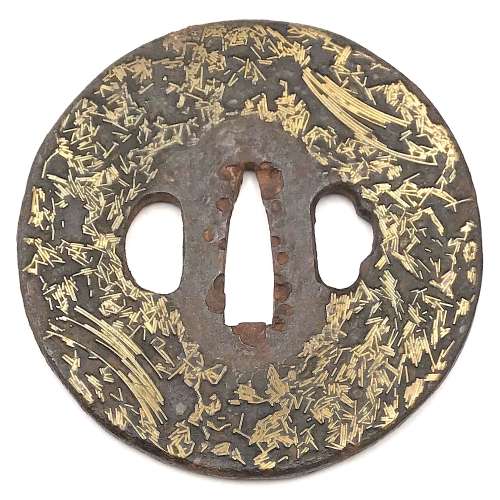 Gomoku-zōgan tsuba. Iron, inlaid with brass scrap (gomoku-zōgan), and polished. Height: 75.3 mm; Width 74.9 mm; Thickness at seppa-dai: 3.6 mm. Weight 130.2 g. Edo, 18th century. Gary D. Murtha dedicates 10 pages to this type of tsuba: "...they were made by soldering brass overlay scraps to the iron plate". Actual gomoku-zōgan tsuba are seldom found in collections most likely because they have little if any artistic attributes. In addition, many have rough surfaces making them questionable for use on a sword. It is said that many of these were produced in Yokohama for export to the West during the late Edo period". G. D. Murtha then describes the technique of making gomoku-zōgan in every detail, and states that "The brass pieces are said to represent 'fallen pine needles', a description most likely created to add aesthetic value to help market the tsuba" [see:Gary D. Murtha. Japanese sword guards. Onin - Heianjo - Yoshiro. GDM Publications, 2016; pp. 160-161].
Gomoku-zōgan tsuba. Iron, inlaid with brass scrap (gomoku-zōgan), and polished. Height: 75.3 mm; Width 74.9 mm; Thickness at seppa-dai: 3.6 mm. Weight 130.2 g. Edo, 18th century. Gary D. Murtha dedicates 10 pages to this type of tsuba: "...they were made by soldering brass overlay scraps to the iron plate". Actual gomoku-zōgan tsuba are seldom found in collections most likely because they have little if any artistic attributes. In addition, many have rough surfaces making them questionable for use on a sword. It is said that many of these were produced in Yokohama for export to the West during the late Edo period". G. D. Murtha then describes the technique of making gomoku-zōgan in every detail, and states that "The brass pieces are said to represent 'fallen pine needles', a description most likely created to add aesthetic value to help market the tsuba" [see:Gary D. Murtha. Japanese sword guards. Onin - Heianjo - Yoshiro. GDM Publications, 2016; pp. 160-161]. -
 Iron tsuba of oval form with design of cherry blossoms in positive and negative silhouette openwork (ji-sukashi and in-sukashi). Details chiseled in kebori technique. Rounded rim. Copper sekigane. Higo school, Hayashi sub-school. Unsigned. Attributed to third generation Tōhachi (1723-1791). Edo period, 18th century (Hōreki / Meiwa era: 1751-1772). Height: 78.7 mm. Width: 72.2 mm. Rim thickness: 5.2 mm. Center thickness: 5.2 mm. Provenance: Sasano Masayuki Collection, № 289: "Hayashi. Third generation Tohachi (died in in the third year of Kansei, 1791 at the age of sixty-nine). Early 18th century (Hohreki / Meiwa era). "
Iron tsuba of oval form with design of cherry blossoms in positive and negative silhouette openwork (ji-sukashi and in-sukashi). Details chiseled in kebori technique. Rounded rim. Copper sekigane. Higo school, Hayashi sub-school. Unsigned. Attributed to third generation Tōhachi (1723-1791). Edo period, 18th century (Hōreki / Meiwa era: 1751-1772). Height: 78.7 mm. Width: 72.2 mm. Rim thickness: 5.2 mm. Center thickness: 5.2 mm. Provenance: Sasano Masayuki Collection, № 289: "Hayashi. Third generation Tohachi (died in in the third year of Kansei, 1791 at the age of sixty-nine). Early 18th century (Hohreki / Meiwa era). " -
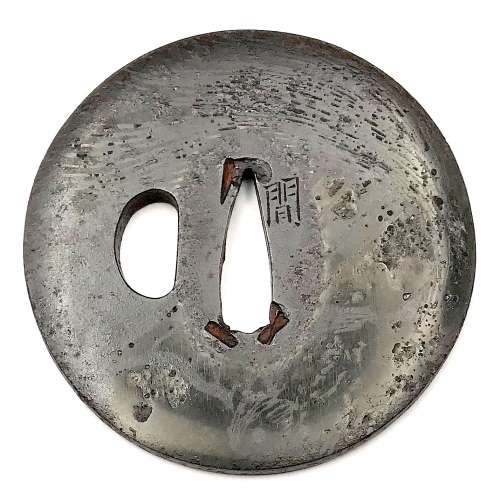 Iron tsuba of round form (width > height) decorated with a squirrel (on the face) and bamboo (on the reverse) motif in sahari flat inlay (hira-zōgan). Signed: Hazama (間) Size: 75.1mm x 75.9mm, thickness of seppa-dai 5.4mm. Early 18th century, mid Edo. Haynes/Torigoye: "There is another name for Hazama tsuba: the Kameyama school. In the period from Hōei to Kyōhō (1704-36) at Kameyama, in the province of Ise, the Kunitomo family made this style of tsuba" [...] The two artists who are best known for the sahari style of inlaid tsuba are Sadahide and Masahide" [...] The signature Hazama should be considered as that of Masahide". Sahari inlay is the distinctive characteristics of Hazama school. Sahari is an alloy of copper, tin, lead, zinc and silver. Hazama tsuba was carved patterns at first, then poured heated into the carvings on iron ground. Because it is an alloy, sahari shows different colors in each tsuba. According to Merrily Baird [Symbols, p. 163], "squirrels (risu) ... have no symbolic importance". NBTHK certificate №448388.
Iron tsuba of round form (width > height) decorated with a squirrel (on the face) and bamboo (on the reverse) motif in sahari flat inlay (hira-zōgan). Signed: Hazama (間) Size: 75.1mm x 75.9mm, thickness of seppa-dai 5.4mm. Early 18th century, mid Edo. Haynes/Torigoye: "There is another name for Hazama tsuba: the Kameyama school. In the period from Hōei to Kyōhō (1704-36) at Kameyama, in the province of Ise, the Kunitomo family made this style of tsuba" [...] The two artists who are best known for the sahari style of inlaid tsuba are Sadahide and Masahide" [...] The signature Hazama should be considered as that of Masahide". Sahari inlay is the distinctive characteristics of Hazama school. Sahari is an alloy of copper, tin, lead, zinc and silver. Hazama tsuba was carved patterns at first, then poured heated into the carvings on iron ground. Because it is an alloy, sahari shows different colors in each tsuba. According to Merrily Baird [Symbols, p. 163], "squirrels (risu) ... have no symbolic importance". NBTHK certificate №448388. -
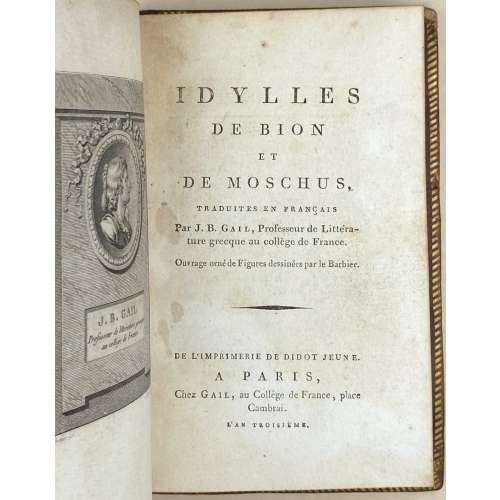 Title-page: IDYLLES | DE BION | ET | DE MOSCHUS, | TRADUITES EN FRANÇAIS | Par J. B. Gail, Professeur de littéra- | ture grecque au collège de France. | Ouvrage orné de Figures dessinées par le Barbier. | DE L’IMPRIMERIE DE DIDOT JEUNE. | A PARIS, | Chez Gail, au Collège de France, place | Cambrai. | L’AN TROISIEME. || Small volume in-12mo, 14.7 x 10 cm, bound in tree calf with gilt ornamental border, flat spine with gilt lozenges in compartments, lacking upper label and half of the lower label, gilt dentelle inside, marbled endpapers, all edges gilt. Collation: 1st and last leaves blank, [1]-96, total 54 leaves and 9 engraved plates, incl. frontispiece. Pagination: [1-5] 6-106 [2] (notice), total 108 pages, ils. Illustrations: (1) Frontispiece bust portrait of Jean-Baptiste Gail in two states, one proof before letters signed Le Barbier del., — C. S. Gaucher inc. a. ƒ., the other in finished state lettered « J. B. Gail | Professeur de littérature grecque | au collège de France » signed Le Barbier del. — C. S. Gaucher incid. (2) Le tombeau d’Adonis in two states, the first unsigned, the second signed by Le Barbier and Gaucher in Greek Λε Βαρβιερ εγραφε — Γαυχερ εχαλχενε, with tissue guard. (3) Enlèvement d’Europe in two states, the first signed Baquoy fecit., the second Le Barbier inv. — Delignon Sculp. (4) Amour du fleuve Alphée pour la fontaine Aréthuse in two states, the first unsigned, the second signed Le Barbier inv. — Dambrun. (5) Daphnis et Naïs only in final state signed by Le Barbier and Gaucher in Greek Λε Βαρβιερ εγρφε — Γαυχερ εχαλχενε. (sic.) Catalogue raisonné: Cohen-DeRicci 151-2, attributes to 1895, in-18, Daphnis et Naïs without the proof state; Lewine 64, "very scarce, particularly that of the portrait, a fancy price". Contributors: Bion [Βίων] (fl. late 2nd century BCE, Phlossa near Smyrna) – author. Moschus [Μόσχος] (fl. mid 2nd century BCE, Syracuse) – author. Jean-Baptiste Gail (French, 1755 – 1829) – translator. Jean-Jacques-François Le Barbier (French, 1738 – 1826) – artist. Charles-Étienne Gaucher (French, 1740 – 1804) – engraver. Jean-Louis Delignon (French, 1755 – 1820) – engraver. Jean Dambrun (1741 – 1808/14) – engraver. Pierre François Didot, Le Jeune (French, 1732 – 1795) – publisher.
Title-page: IDYLLES | DE BION | ET | DE MOSCHUS, | TRADUITES EN FRANÇAIS | Par J. B. Gail, Professeur de littéra- | ture grecque au collège de France. | Ouvrage orné de Figures dessinées par le Barbier. | DE L’IMPRIMERIE DE DIDOT JEUNE. | A PARIS, | Chez Gail, au Collège de France, place | Cambrai. | L’AN TROISIEME. || Small volume in-12mo, 14.7 x 10 cm, bound in tree calf with gilt ornamental border, flat spine with gilt lozenges in compartments, lacking upper label and half of the lower label, gilt dentelle inside, marbled endpapers, all edges gilt. Collation: 1st and last leaves blank, [1]-96, total 54 leaves and 9 engraved plates, incl. frontispiece. Pagination: [1-5] 6-106 [2] (notice), total 108 pages, ils. Illustrations: (1) Frontispiece bust portrait of Jean-Baptiste Gail in two states, one proof before letters signed Le Barbier del., — C. S. Gaucher inc. a. ƒ., the other in finished state lettered « J. B. Gail | Professeur de littérature grecque | au collège de France » signed Le Barbier del. — C. S. Gaucher incid. (2) Le tombeau d’Adonis in two states, the first unsigned, the second signed by Le Barbier and Gaucher in Greek Λε Βαρβιερ εγραφε — Γαυχερ εχαλχενε, with tissue guard. (3) Enlèvement d’Europe in two states, the first signed Baquoy fecit., the second Le Barbier inv. — Delignon Sculp. (4) Amour du fleuve Alphée pour la fontaine Aréthuse in two states, the first unsigned, the second signed Le Barbier inv. — Dambrun. (5) Daphnis et Naïs only in final state signed by Le Barbier and Gaucher in Greek Λε Βαρβιερ εγρφε — Γαυχερ εχαλχενε. (sic.) Catalogue raisonné: Cohen-DeRicci 151-2, attributes to 1895, in-18, Daphnis et Naïs without the proof state; Lewine 64, "very scarce, particularly that of the portrait, a fancy price". Contributors: Bion [Βίων] (fl. late 2nd century BCE, Phlossa near Smyrna) – author. Moschus [Μόσχος] (fl. mid 2nd century BCE, Syracuse) – author. Jean-Baptiste Gail (French, 1755 – 1829) – translator. Jean-Jacques-François Le Barbier (French, 1738 – 1826) – artist. Charles-Étienne Gaucher (French, 1740 – 1804) – engraver. Jean-Louis Delignon (French, 1755 – 1820) – engraver. Jean Dambrun (1741 – 1808/14) – engraver. Pierre François Didot, Le Jeune (French, 1732 – 1795) – publisher. -
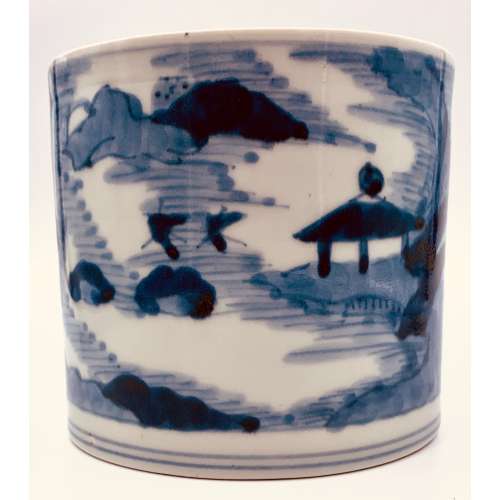
-
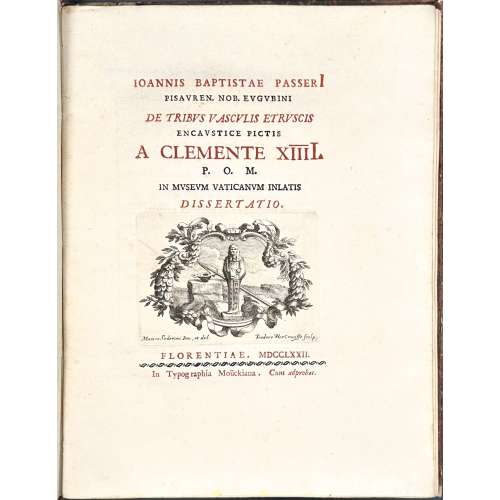 Owner’s wrappers, 28 x 21 cm, printed on laid paper, unpaginated, collated ffl, [A, B]4 C-G4, 2 ffl; total 28 leaves plus 5 engraved plates by Allegrini after Mariotti; engraved title-page (Vercruys after Soderini), head- and tailpieces (Gregori after del Moro) and initials. Owner's label to front pastedown: Marc Burdin, prêtre. Title-page (engraved, red and black): IOANNIS BAPTISTAE PASSERI | PISAUREN. NOB. EUGUBINI | DE TRIBUS VASCULIS ETRUSCIS | ENCAUSTICE PICTIS | A CLEMENTE XIIII. | P.O.M. | IN MUSEUM VATICANUM INLATIS | DISSERTATIO. | {VIGNETTE} | FLORENTIAE. MDCCLXXII. | ~ | in Typographia Moückiana. Cum adprobat. || Dedication: ANTIQVARIAE. ERVDITIONIS. PROPAGATORI EXIMIO ABSOLVTISSIMAM . HANC. DISSERTATIONEM CLARISS. PASSERII DE . IMAGINIBVS . ET . SYMBOLIS TRIVM . VASORVM . ETRVSCI . OPERIS QVAE PRINCIPIS. NOSTRI.SANCTISS. ET. SAPIENTISS. LARGITATE IN . VATICANVM . MVSEVM A. SE. CVMVLATISSIME . DITATVM INVE CTA . FVERVNT REGINALDVS.COMES.ANSIDAEVS.PATR.PERVS. M. A. CARD. PRONEPOS DEVOTVS. NOMINI . MAIESTATIQVE . EIVS DEMISSISSIME. Translation: "To the most excellent promoter of antiquities, the most accomplished: This most complete dissertation concerning the images and symbols of three Etruscan vases, which were most abundantly bestowed by our most holy and wise Prince onto the Vatican museum, was composed by the illustrious Passerius. Reginald, Count of Ansidius, true ancestral father, grandson by blood of the Cardinal, devoted most humbly and devoutly to his name and majesty." Note: P.O.M. stands for "Papa Optimo Maximo", which translates to "Father Most Excellent." For a similar vase in this collection, see VO-0098.
Owner’s wrappers, 28 x 21 cm, printed on laid paper, unpaginated, collated ffl, [A, B]4 C-G4, 2 ffl; total 28 leaves plus 5 engraved plates by Allegrini after Mariotti; engraved title-page (Vercruys after Soderini), head- and tailpieces (Gregori after del Moro) and initials. Owner's label to front pastedown: Marc Burdin, prêtre. Title-page (engraved, red and black): IOANNIS BAPTISTAE PASSERI | PISAUREN. NOB. EUGUBINI | DE TRIBUS VASCULIS ETRUSCIS | ENCAUSTICE PICTIS | A CLEMENTE XIIII. | P.O.M. | IN MUSEUM VATICANUM INLATIS | DISSERTATIO. | {VIGNETTE} | FLORENTIAE. MDCCLXXII. | ~ | in Typographia Moückiana. Cum adprobat. || Dedication: ANTIQVARIAE. ERVDITIONIS. PROPAGATORI EXIMIO ABSOLVTISSIMAM . HANC. DISSERTATIONEM CLARISS. PASSERII DE . IMAGINIBVS . ET . SYMBOLIS TRIVM . VASORVM . ETRVSCI . OPERIS QVAE PRINCIPIS. NOSTRI.SANCTISS. ET. SAPIENTISS. LARGITATE IN . VATICANVM . MVSEVM A. SE. CVMVLATISSIME . DITATVM INVE CTA . FVERVNT REGINALDVS.COMES.ANSIDAEVS.PATR.PERVS. M. A. CARD. PRONEPOS DEVOTVS. NOMINI . MAIESTATIQVE . EIVS DEMISSISSIME. Translation: "To the most excellent promoter of antiquities, the most accomplished: This most complete dissertation concerning the images and symbols of three Etruscan vases, which were most abundantly bestowed by our most holy and wise Prince onto the Vatican museum, was composed by the illustrious Passerius. Reginald, Count of Ansidius, true ancestral father, grandson by blood of the Cardinal, devoted most humbly and devoutly to his name and majesty." Note: P.O.M. stands for "Papa Optimo Maximo", which translates to "Father Most Excellent." For a similar vase in this collection, see VO-0098.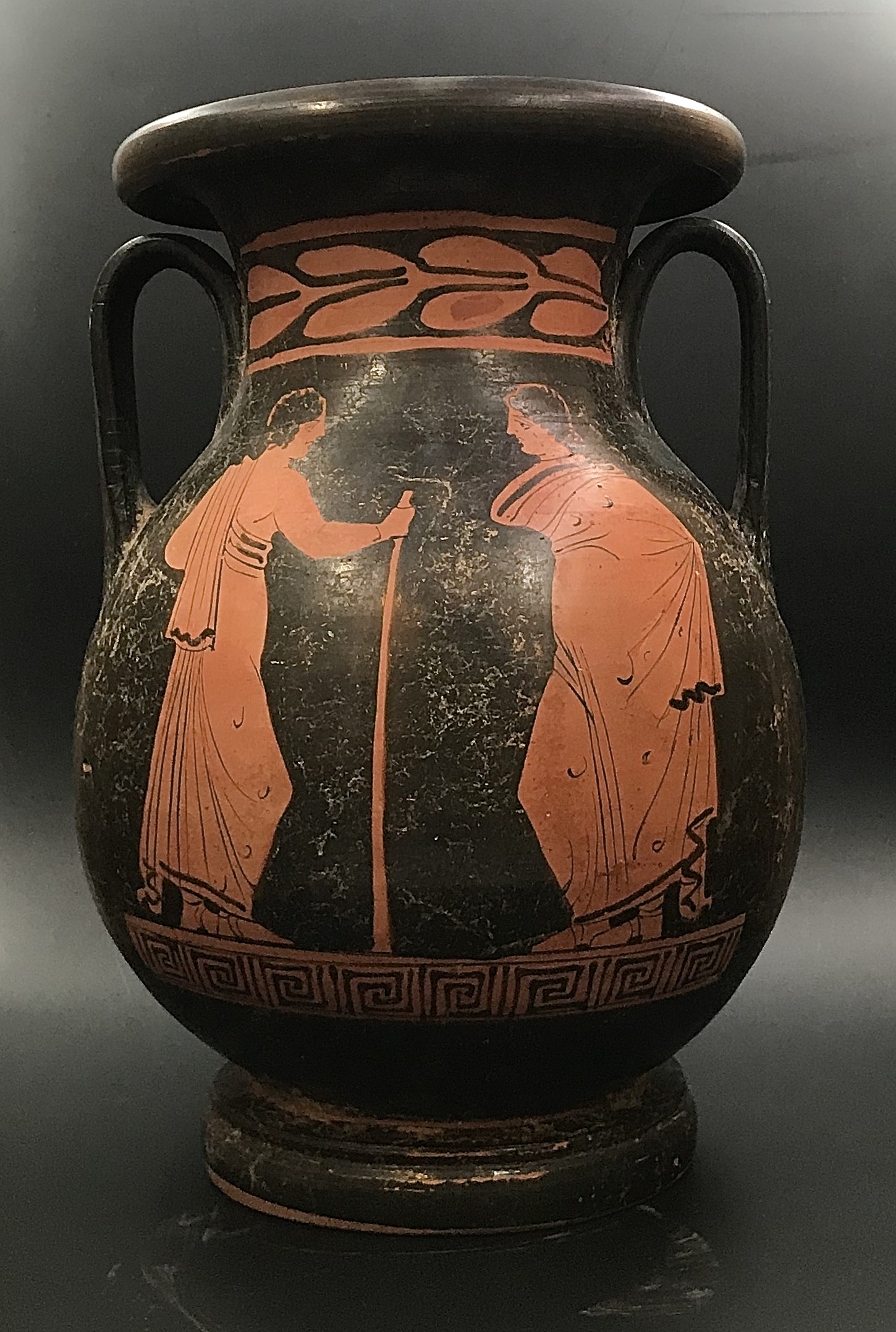
 This vase is attributed to Apulia, ca. 330 BCE. Passeri was probably wrong to attribute this type of vessel to Etruscan vase painting, produced from the 7th through the 4th centuries BC.
Contributors:
Giovanni Battista Passeri (Italian, 1694 – 1780) – author.
Francesco Moücke (Italian, fl. 1729 – 1787) – publisher.
Pope Clement XIV [Ganganelli, Giovanni Vincenzo Antonio] (Italian, 1705 – 1774) – dedicatee.
Artists:
Mauro Soderini (Italian, 1704 – after 1751)
Carlo Spiridione Mariotti (Italian, 1726 – 1790)
Lorenzo del Moro (Italian, 1677 – 1735)
Engravers:
Theodor Vercruys [Teodoro Vercruysse] (Dutch, 1678 – 1739)
Francesco Allegrini da Gubbio (Italian, 1587 – 1663)
Carlo Bartolomeo Gregori (Italian, 1702 – 1759)
This vase is attributed to Apulia, ca. 330 BCE. Passeri was probably wrong to attribute this type of vessel to Etruscan vase painting, produced from the 7th through the 4th centuries BC.
Contributors:
Giovanni Battista Passeri (Italian, 1694 – 1780) – author.
Francesco Moücke (Italian, fl. 1729 – 1787) – publisher.
Pope Clement XIV [Ganganelli, Giovanni Vincenzo Antonio] (Italian, 1705 – 1774) – dedicatee.
Artists:
Mauro Soderini (Italian, 1704 – after 1751)
Carlo Spiridione Mariotti (Italian, 1726 – 1790)
Lorenzo del Moro (Italian, 1677 – 1735)
Engravers:
Theodor Vercruys [Teodoro Vercruysse] (Dutch, 1678 – 1739)
Francesco Allegrini da Gubbio (Italian, 1587 – 1663)
Carlo Bartolomeo Gregori (Italian, 1702 – 1759) -
 Ippitsusai Bunchō [一筆斎文調] (Japanese, 1725 – 1794). Size: Vertical Hosoban. As the Library of Congress put it: "Print shows the actor Ichikawa Monnosuke II, full-length portrait, facing left, standing on the snow-covered veranda". Actor: Ichikawa Monnosuke II [市川門之助] (Japanese, 1743/56 – 1794); other names: Ichikawa Benzō I, Takinaka Hidematsu II, Takinaka Tsuruzō. According to Heroes of the Kabuki Stage [LIB-1197.2016] Ichikawa Monnosuke II was active from 11/1770 to 10/1794. Play: Chūshingura [忠臣蔵] (The Treasury of Loyal Retainers), played at Nakamuraza in the 4the month of Meiwa 8 (1771). The actor played in a variety of roles and performances and was the subject of multiple woodblock prints by many famous ukiyo-e artists, including Bunchō, Katukawa Shunkō, Katukawa Shunshō, Katsukawa Shun'ei, Tōshūsai Sharaku, and many others. Ref: Vever (1976), vol. 1, № 242, p. 227.
Ippitsusai Bunchō [一筆斎文調] (Japanese, 1725 – 1794). Size: Vertical Hosoban. As the Library of Congress put it: "Print shows the actor Ichikawa Monnosuke II, full-length portrait, facing left, standing on the snow-covered veranda". Actor: Ichikawa Monnosuke II [市川門之助] (Japanese, 1743/56 – 1794); other names: Ichikawa Benzō I, Takinaka Hidematsu II, Takinaka Tsuruzō. According to Heroes of the Kabuki Stage [LIB-1197.2016] Ichikawa Monnosuke II was active from 11/1770 to 10/1794. Play: Chūshingura [忠臣蔵] (The Treasury of Loyal Retainers), played at Nakamuraza in the 4the month of Meiwa 8 (1771). The actor played in a variety of roles and performances and was the subject of multiple woodblock prints by many famous ukiyo-e artists, including Bunchō, Katukawa Shunkō, Katukawa Shunshō, Katsukawa Shun'ei, Tōshūsai Sharaku, and many others. Ref: Vever (1976), vol. 1, № 242, p. 227.
Katsukawa Shun'ei. The Actor Ichikawa Monnosuke II in an Aragoto Role. LACME.

Actor Ichikawa Monnosuke II as Date no Yosaku Artist Tôshûsai Sharaku (Japanese, active 1794–1795), Publisher Tsutaya Jûzaburô (Kôshodô) (Japanese) 1794 (Kansei 6), 5th month. MFA.

Ippitsusai Bunchô. Actor Ichikawa Monnosuke II as Tsunewakamaru. Play: Iro Moyô Aoyagi Soga Theater: Nakamura. MFA.
-
 Ippitsusai Bunchō (一筆斎文調); lived 1725-1794; flourished 1755–1790. Size: Chuban; 26 x 20 cm The design presents a young woman reading a scroll while arranging her hear, and a young man with a rowing rod watching over her shoulder; the pair is standing on a giant shrimp that ferries them over a stream. The third passenger is a literate octopus, who's is attentively exploring the text of a scroll. This allusion comes to mind promptly: “Bodhidharma crossing the Yangzi River on a reed” (Royō Daruma).
Ippitsusai Bunchō (一筆斎文調); lived 1725-1794; flourished 1755–1790. Size: Chuban; 26 x 20 cm The design presents a young woman reading a scroll while arranging her hear, and a young man with a rowing rod watching over her shoulder; the pair is standing on a giant shrimp that ferries them over a stream. The third passenger is a literate octopus, who's is attentively exploring the text of a scroll. This allusion comes to mind promptly: “Bodhidharma crossing the Yangzi River on a reed” (Royō Daruma). Image from Asian Art Museum in San Francisco:
Image from Asian Art Museum in San Francisco:
Masanobu’s mitate wittily evokes an episode known as “Bodhidharma crossing the Yangzi River on a reed” (Royō Daruma). According to legend, the river crossing occurred en route to the Shaolin monastery, where Bodhidharma sat facing a wall for nine years without speaking. While serious interpretations abound in Chinese and Japanese paintings, popular prints of the Edo period often playfully substituted a beautiful woman for the monk. This parodic version was reportedly invented in response to a courtesan’s comment that she was more enlightened than Bodhidharma because she had spent ten years sitting, on display in a brothel.
An interesting article about this particular design is published at UKIYO-E.ORG BLOG. Though, the design is erroneously attributed to Harunobu. We see that Bunchō was quite fascinated by the idea of crossing a water obstacle with the help of an unsuitable means of transportation:
Female Daruma Riding a Mushroom. MFA # 21.4758.


